November 30, 2019
Saint Cecilia: The Sixteen at Kings Place
But, no matter. This performance by Harry Christophers’ ensemble at Kings Place was characteristically accomplished and well-composed, in terms of, respectively, the singers’ assurance (though I’m not sure why Christophers needed to employ pitch pipes between items, given the singers’ experience and the harmonic clarity and focus of the works performed) and the balance of compositional styles presented.
Britten’s ‘A Hymn to the Virgin’ (1931) opened proceedings, and here the strengths of The Sixteen were obvious: the clarity of diction; the persuasive nuance of suspension and dissonance; the give and take between phrases which creates fluency; the independence of voices where necessary which injects drama and vigour.
The programme included works by many women composers of the 20th and 21st centuries. Ruth Byrchmore’s ‘Prayer of St Teresa of Avila’ was noteworthy for the way harmonic stasis and movement were opposed, creating a dynamism that flowered in rich timbral majesty. In contrast, the lines of the composer’s ‘A Birthday (St Cecilia)’ seemed at times to be swimming against each other, resulting in no less dynamic urgency. The latter climaxed in a sustained proclamation, “my love is come to me”, through which the female voices seemed to evolve from a human to an instrumental to an almost abstract timbre.
We had two works by Cecilia McDowall, ‘Now may we singen’ and ‘Of a Rose’, both of which recalled carolling traditions - and the spirit of John Rutter - in their combinations of melody and drone, and the temporal flexibility which seems to be a direct representation of linguistic veracity. Similarly, there were two works by Margaret Rizza: ‘O speculum columbe’, which sprayed its harmonic light like a fan of colour in the opening stanza, and ‘Ave generosa’ which was one of the evening’s more individual and engaging offerings, bringing together soprano and alto solos in a complementary partnership and culminating in a blaze of jubilation: “Dei Genitricem. Amen.” (Mother of God. Amen)
The programme did evince an occasional waft of ‘English gentility’: Elizabeth Poston’s ‘Jesus Christ the apple tree’ was an exquisite dose of Christmas-come-early; The Sixteen’s Kim Porter showed her choral nous in ‘Christmas Eve’, combining contrapuntal dialogue with harmonic nuance. But any sense of comfort or complacency, however beautiful, was challenged most creatively by Alissa Firsova’s ‘Stabat Mater’, which foraged through piquant harmonic landscapes and sonorities, exploiting false relation and flattened ‘blue notes’, and sculpting an architectural expanse of quiet dignity. Similarly Peter Maxwell Davies’ ‘Lullaby for Lucy’ made its mark without undue ceremony: as the text spoke of “plants and creatures of the valley” which “Unite,/ calling a new/ Young one to join the celebration”, so the music expanded organically from tenor solo to tender intertwinings, culminating in startling luminosity: “Lucy came among them, all brightness and light.”
Ironically, if there was one item that left me feeling a bit ‘bristly’ it was Britten’s Hymn to Saint Cecilia. Though the text was well articulated throughout, I longed for more rhythmic swing and suaveness at the opening, to avoid the impression of English-country-house etiquette and stiff-upper-lips. In the second section, “I cannot grow”, there was precision but not tension: the counterpoint was precise but prim. The tuning of some of the unison refrains was not entirely settled, though there was a persuasive organ-like timbre and sonority at time for the appeal, “Blessed Cecilia, appear in vision”; the pause on “Love me” at the close of this second section was distinctly troubled intonation-wise.
With the arrival of the concluding Auden poem, “O ear whose creatures cannot wish to fall”, I longed for more fluency of line: all was absolutely accurate, but, for example, the men’s stepwise lines came across as separate notes rather than a melodic sweep. And, this may be an entirely personal preference or predilection, but I found soprano solo - though powerfully sung by Julie Cooper - too empowered and vibrant: this is surely an angelic song, and if we can’t have a boy soprano then we might have a voice which approximates the abstract elevation of such? Similarly, when it came to the poetic ‘punchline’, so to speak, I felt that Jeremy Budd’s solo tenor proclamation, “O wear your tribulation like a rose”, needed greater spaciousness to take in the import of the text; and that more precise tuning of the chord supporting the fanfare-like declaration was required. This work highlighted, too, the tendency of The Sixteen to over-sing in this venue; they did not need to cast their utterances into a cathedral’s sonic void that would magnify and return and enrich; the acoustic in Hall One is excellent, the space fairly intimate. Less would have been more at times.
Most affecting of all was Herbert Howells’ ‘Take him, earth, for cherishing’, which is often said to have been commissioned following the death of John F. Kennedy, though the real dedicatee is surely Howells’ son, Michael, who died 28 years earlier from polio. The initial unison challenged; imperatives, “Guard him well”, compelled; the counterpoint was simultaneously knotty and dynamic: “Comes the hour God hath appointed/ To fulfil the hope of men:” The plea to the Lord, “O take him, mighty Leader, Take again thy servant’s soul”, was expansive and compelling. The final prayer, “Take him, earth, for cherishing.”, was quietly touching. Christophers sculpted a cathedral of sound, simultaneously gracious and fragile.
Claire Seymour
The Sixteen:
Saint Cecilia
Harry Christophers (conductor)
Britten - Hymn to the Virgin, Ruth Byrchmore - Prayer of St Theresa of Avila, Britten - Hymn to Saint Cecilia, Cecilia McDowall - Now May We Singen, Margaret Rizza - O Speculum Columbe, Alissa Firsova - Stabat Mater, Howells - Take Him Earth for Cherishing, Kim Porter - Christmas Eve, Byrchmore - A Birthday (St Cecilia), McDowall - Of a Rose, Roxanna Panufnik - Prayer, Elizabeth Poston - Jesus Christ the Apple Tree, Maxwell Davies - Lullaby for Lucy, Rizza - Ave generosa.
Kings Place, London; Friday 29th November 2019.
image=http://www.operatoday.com/The%20Sixteen.jpg image_description= product=yes product_title=The Sixteen at Kings Place: Saint Cecilia product_by=A review by Claire Seymour product_id=Above: The Sixteen
November 29, 2019
Liszt Petrarca Sonnets complete – Andrè Schuen, Daniel Heide
Since no complete edition of the Liszt songs exists apart from the Alexander edition for Breitkopf and Härtel in 1919-21, this may be more than an ordinary completist series. There could be as many as 145 variants, with questions of classification, since Liszt did not not assign opus numbers. This recording seeks to highlight the connections between Liszt’s three settings of Petrarch’s Sonnets 47, 104 and 123. Recorded in the Marküs -Sittikus Saal in Hohenems, these are performances of great sensitivity, as we’d expect from Schuen, and Heide.
Andrè Schuen is easily one of the more promising young baritones around, and one whose genuine love for repertoire leads him to in-depth performances of more eclectic material. He recorded an outstanding Frank Martin Sechs Monologe aus Jedermann as well as Schumann, Beethoven and Wanderer, an excellent collection of Schubert Lieder. At the Wigmore Hall on Saturday 23rd November, Schuen and Heide are giving a recital of Schubert and Mahler (Lieder eines fahrenden Gesellen and the Rückert Lieder).
Liszt’s first settings of the Petrarch sonnets date from 1842-6 while the second settings were completed between 1864-1882. Composed decades apart, these are far more than simple “variations” but thoroughly thought-through new works, showing the evolution of Liszt’s approach though time. The order of songs is also transposed. In the first Sonetto 104, (Pace non trovo) is declamatory, each verse clearly separated by a piano interlude. The line “equalamente mi spiace morte et vita” rises with operatic flourish, before a hushed ending, marked by two assertive chords on the piano for emphasis. The second Sonetto 104, better reflects the brief phrases in the poem, which flow in succession, building up tension towards the line “né mi vuol vivo, né mi trae impaccio” expressing the poet’s frustration. The line “in questa stato son, donna, por voi” is all the more moving because it expresses love, tenderly complemented by a gentle piano postlude.
In the first Sonetto 47 (Benedetto sia ‘l giorno), the mood is gentler, suggesting the purity of the beloved. Elaboration is focused on the third strophe “Benedette le voci tante” where phrases are repeated, adding lustre to the name “Laura”, which Schuen projects with glowing awe. The second setting of this sonetto is even more sensitive, Liszt’s attention even better attuned to the scansion of Petrarch’s flowing phrases, “‘l giorno, e ‘l mese, e l’anno, e la stagione, e ‘l tempo, e l’ora, e ‘l punto”, which are all connected, since they underline the meaning of the poem. Schuen’s perfect diction underlines the melodious nature of the text. Only in the line “E le piaghe, ch’infino al cor mi vanno” is there a hint of the pain the poet is going through. With such subtlety, Liszt has no need to decorate the third strophe: its impact comes from the sincere, direct expression of emotion. This makes the final strophe even more moving, as it gradually decelarates into quietude. For the poet, nothing matters but the beloved: “Ch’ è sol di lei” sings Schuen with deep feeling, “si ch’altra non v’ha parte”. As the song subsides, the word “benedette” is intoned, like a prayer.
An extended piano prelude introduces the first setting of Sonetto 123 (I’ vidi in terra), the genly rocking melody taken up in the vocal line. The beloved is now a memory, “par sogni, ombre e fume”. Though there are differences in the two settings for voice and piano, the focus is now on the poet, alone. For Liszt as composer, such personal expression would have favoured the piano. Given that the versions for solo piano from Années de Pélerinage, Année II (Italie) S 161 no. 4 to 6 were written shortly after the first settings of the songs for voice and piano, S 270a, it is natural that the resemblances are strong. The popularity of the pieces for piano thus derives from the emotional power inherent in the songs, even shorn of text. Hearing all three sets together enhances understanding of their context and the role they play in the development of Liszt’s oeuvre. Paradoxically, this also means a greater appreciation of the later set, known as S 270b, but much more mature, subtle and sophisticated than mere variation.
Appositely, Schuen and Heide conclude this first volume in the Liszt Lieder series with Liszt’s setting of Victor Hugo, Oh! Quand je dors, S 282, here in the second version, completed in 1859. Many of Liszt’s songs are standard repertoire, but the time has come for a re-evaluation of all the songs, in context. Recently, Cyrille Dubois and Tristan Raës presented Liszt Lieder together with his Mélodies in the French style, demonstrating how original Liszt was, a composer “beyond boundaries”, so to speak. Please read more about that here. Essential listening for all.
Anne Ozorio
image=http://www.operatoday.com/8553472.png image_description=Avi-Music 4260085534722 product=yes product_title=Franz Liszt : Petrarca Sonnets product_by=Andrè Schuen, baritone and Daniel Heide , piano. product_id=Avi-Music 4260085534722 [CD] price=$17.21 product_url=https://amzn.to/34z9JmRNovember 26, 2019
Insights on Mahler Lieder, Wigmore Hall, Andrè Schuen
Everyone has heard the Schubert favourites Schuen and Heide chose, maybe hundreds of times, but Schuen and Heide made them feel fresh and personal. An den Mond D259, illuminated with subtle restraint, Im Frühling D882, full-throated and free-spirited, Abendstern D806, gently contemplative. Schuen and Heide know how to programme, varying songs of introspection with exuberant outbursts like Der Musensohn D764. The second half of the recital was even better: a particularly tender Sei mie gegrüsst D741 and Dass sie hier gewesen D775. Together they demonstrated Schuen’s range, which effortlessly reaches the upper limits of baritone, to near-tenor brightness. He’s still young but has huge potential – definitely a singer to follow.
Schuen and Heide have often explored less familiar parts of the repertoire, like their outstanding Frank Martin Sechs monologe aus Jedermann so it was interesting to hear how they’d do Mahler Lieder eines fahrenden Gesellen, which just about everyone has done, not always to best effect. This is very much a young man’s adventure, as it was for Mahler himself, setting out on his own journey. Despite a slightly cautious start, understandable enough, Schuen soon got into his stride. Schuen’s diction is agile, an energetic, even stride in his phrasing. The poet sets out, upset because he’s been rejected by a girl, but his love may have been little more than teenage fantasy. Almost immediately he is drawn to Nature and the world beyond himself. “Ziküth, Ziküth” here rang strong and pure, as if modelled on hearing bird song ringing in the wild, for the bird symbolizes destiny – Siegfried, heading off down the Rhine, led by a wood dove in the forest. Thus revitalised, the poet looks ahead. Schuen breathed into the phrase “Blümlein blau! Verdorre nicht!” making the words glow with wonder. Anyone who’s seen gentians in Alpine regions, growing out between rocks, know exactly why they can feel miraculous. No surprise then that Schuen and Heide gave the second song “Ging heut’ Morgen über’s Feld” such heartfelt vigour. Flowing, decorative phrasing in “Wird’s nicht eine schöne Welt?Zink! Zink! Schön und flink! Wie mir doch der Welt gefällt!” Sparkling piano figures lead into a new, more serene mood, where lines stretch smoothly, held for several measures, as if basking in Sonnenschein.
With “Ich hab’ ein glühend Messer” the mood shifts, like sudden storm, descending on a mountain. The dark resonance in Schuen’s lower register highlighted the drama. But yet again, Mahler doesn’t dwell on angst: the drama here is almost as if the poet were reminding himself to be angry – as teenagers do – when he has in fact moved on. In the final song, Schuen showed the lyricism and tenderness in his timbre, which in many ways is even more impressive than the volume he can achieve when needed. The Lindenbaum reputedly has narcotic qualities, that can intoxicate those inhaling the scent of its leaves and flowers. Perhaps the poet might die (as suggested in Winterreise) but for Mahler, the song is lullaby. Sleep can refresh and re-invigorate. Schuen’s style is direct, with clear-eyed focus, totally appropriate to this cycle.
Mahler’s Rückert-Lieder are not a cycle, as such, and the sequence can be altered. Schuen and Heide put the more overt songs of love together forming a miniature cycle of their own, followed by Um Mitternacht, in which the poet confronts mortality, and Ich bin der Welt abhanden gekommen, in which the poet comes away from the cares of the world. The Rückert-Lieder are in an altogether more sophisticated league than Lieder eines fahrenden Gesellen, but Schuen and Heide rose to the challenge. Their performance here was the highlight of the whole evening. Lovely as these songs are, loveliness alone means little. What impressed me most was the emotional maturity and artistic insight Schuen and Heide brought to this interpretation, which can elude some bigger-name celebrities.
A particularly beautiful Ich atmet’ einen linden Duft. Again, a Lindenbaum, whose scent is powerful, but invisible. Subtlety is of the essence: Schuen and Heide seemed to make the music hover, shaping lines without forcing them, Schuen breathing carefully into each phrase, using air itself, like an Äolsharfe. Vowel sounds surged, consonants softened. It is significant that Rückert’s poem is almost minimalist, images suggested with as few words as possible. Similar gentleness in Liebst du um Schönheit. Rückert’s lines are again deceptively simple, almost childlike. Schuen understands that less is more, allowing the song to reveal its purity as it unfolds.
Um Mitternacht thus operates as contrast, not only in purely musical terms, but also to emphasize meaning. If the poet dies, his dilemma is even more poignant if he had had a good life. While the other songs are near lullaby, Um Mitternacht is an anthem, ringing out with impassioned dignity, connecting the individual to the cosmos. “Um Mitternacht hab ‘ ich gedacht Hinaus in dunkle Schranken.” All that separates life from death is the beating of the heart, “ein einz’ger Puls”. An image of fragile humanity, reminding us that all the powers of this world can come suddenly to nothing. As so often in Mahler, bombast is inappropriate. Instead, humility and respect for something greater than the individual. “Herr über Tod und Leben Du hältst die Wacht Um Mitternacht!”. Heide’s lines are firm and steady: Schuen’s voice rings with dignity and affirmation. Thus the logic of concluding with Ich bin der Welt abhanden gekommen : after the storm, the calm of true wisdom. The protagonist isn’t actually dead but has learned that wasting time on pettiness is futile. “Ich bin gestorben dem Weltgetümmel..... ich leb’ allein in meinem Himmel, in meinem Lieben, in meinen Lied”. This was an excellent performance, but in time, Schuen will develop and find even more in this group of songs.
Thus, the logic behind the choice of encore, Urlicht, Mahler’s setting of Nietszche, which he incorporated into his Symphony no 2, heard here in the version for voice and piano. In the symphony it serves as a transition between the “worldy cares” evoked in the quotation of Des Antonius von Padua Fischpredigt in the previous movement and the resolution, the “resurrection” in the finale. “O Röschen rot!”, an image of beauty that must, inevitably fade, Schuen’s voice warming the “o” sounds, so they felt sensual, which occur again in the next phrase, but with a chill. But this nadir of suffering is but a phase. Even angels cannot divert the supplicant from his/her goal. “Ich bin von Gott und will wieder zu Gott!” Schuen sang with resolve, suggesting great inner strength. God will light the way to “das ewig selig Leben!”.
Franz Liszt’s S290, Morgens steh’ ich auf und frage, a setting of Heinrich Heine, provided the second encore. Again, a deceptively simple text, suggesting more than mere words, Liszt’s setting more pianistic than Schumann’s. Schuen and Heide are planning a complete series of Liszt Lieder, the first volume of which features all three versions of the Tre Sonnetti de Petrarca (Petrarca Sonnets). Please read my review of that HERE.
Anne Ozorio
image=http://www.operatoday.com/Andre_Schuen_1_cGWerner_v.jpg image_description=Andrè Schuen [Photo © Guido Werner] product=yes product_title=Mahler and Schubert Lieder. Andrè Schuen (baritone), Daniel Heide (piano) Wigmore Hall, London, 23rd November 2019. product_by=A review by Anne Ozorio product_id=Above: Andrè Schuen [Photo © Guido Werner]Ermelinda by San Francisco's Ars Minerva
Sig. Freschi’s little divertimento was a but a small part of a much bigger evening that went on, I assume, to include at least a naval battle on the villa’s pools, grandiose entertainment for a multitude of invited dignitaries.
A larger perspective of Venetian opera finds Monteverdi’s complex Coronation of Poppea premiere in 1643. Francesco Cavalli’s racy, slice-of-debauched-aristocratic-life operas that we see these days come from the 1650’s (his famed Parisian misadventure with theatrical machinery, Ercole Amante, was in 1662). Antonio Vivaldi, the resident musician of a Venetian orphanage for musically talented girls, came onto the local opera scene as an impresario of the newer Neopolitan style in 1712, and later (1727) wrote his own Orlando furioso based on Ludovico Ariosto’s 1513 epic poem that had established a psychopathology of love that more or less endured until the Romantics.
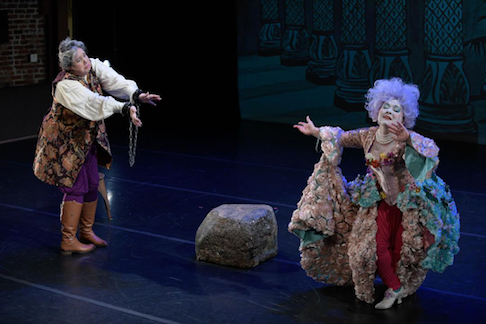 Sara Couden as Clorindo, Kindra Scharich as Rosaura
Sara Couden as Clorindo, Kindra Scharich as Rosaura
All these threads converge in Sig. Freschi’s little comedy for the Doge’s son Marco whose country estate included an orphanage for talented girls. Possibly this orphanage resource is why the Ars Minerva production made use of only treble voices — one male lover was a trouser soprano, the other was a trouser contralto. Ermelinda and her friend Rosaura were duly female. Ermelinda’s father was a male mezzo-soprano (countertenor).
In short, Ormondo loves Ermelinda, Armidoro does too. Ermelinda loves Ormondo, Rosaura does too. Ormondo becomes the mad Clorindo who pretends to love crazy-in-love Rosaura. Aristeo, Ermelinda’s father, intervenes. Ermelinda tries to kill herself for love. Unlike a Cavalli plot this one is quite simple, and unlike Cavalli’s variety of musical forms Sig. Freschi limits himself to recitative, arioso and through composed arietta. There were a few ritornellos and only one sort of duet in the string of solo numbers that told the story very simply and very directly. The dignity of early Venetian opera had long since been thrown into the canals and the grandiose, embellished arias of the Baroque are many years away,
There was no need for theatrical machinery. We were either indoors or out. The Ars Minerva production covered the huge back wall of the 171 seat ODC Theater (a fine dance venue in San Francisco’s Mission district) with projected images created by Entropy (a person’s name) that colorfully abstracted architectural detail vaguely reminiscent of the period.
The elaborate costumes, wittily abstracted from period shapes were designed by Matthew Nash, now retired from the San Francisco Opera costume shop. Stage director Céline Ricci deftly moved her actors around simple, portable props in the center of the expansive dance floor, the Ormondo gone mad — as Clorindo — teased theorbo player Adam Cockerham who was seated with the harpsichord, cello, and three da braccio viols far stage left.
The program booklet does not credit an edition of Sig. Freschi’s little opera, thus we may assume that early music harpsichordist and conductor Jory Vinikour organized the production musically based on a manuscript found at Venice’s Marciana Library. It is lively music that flows in very natural speech rhythms enhanced with very inventive melodic riffs that tease and amuse us and become upon occasion quite specific songs. These players were a confident lot that gave us great delight in their ritornellos. The three instrument continuo cleverly supported the excellent performances center stage.
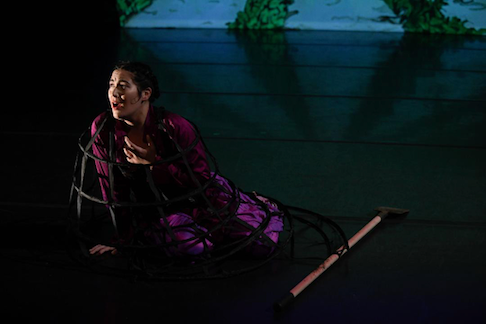 Nikola Printz as Ermelinda, lighting design by Thomas Bowersox
Nikola Printz as Ermelinda, lighting design by Thomas Bowersox
Those 17th century dignitaries will have been mightily amused as we were with the broad comic antics of a nicely matched cast. Ermelinda was sung by mezzo-soprano Nikola Printz who brought rich tone and informed period inflection to her femme fatale role, and created, with Sig. Freschi’s help, convincing musical pathos in her attempted suicide. Her friend and rival Rosaura was sung by Kindra Scharich who made this love sick character a comic masterpiece, every sung phrase an insidious calculation, every movement a neurotic gesture, and all in beautiful voice that flowed naturally over composer Freschi’s finely chiseled lines.
Contralto Sara Couden sang Ermelinda’s suitor Ormondo who disguised himself as a peasant named Clorindo to fit into pastoral life. Mlle. Couden possesses a rare contralto voice that offers her a wide range of roles — from this vocally convincing castrato role, to the nurses, grandmothers and witches of later repertory. She gave herself to the creation a truly rustic Clorindo who goes out and in of feigning madness. Clorindo’s rival for the love of Ermelinda, soundly thwarted, is Armidoro sung by soprano Deborah Rosengaus who created one of the most beautiful musical moments of the evening in her final lament, singing composer Freschi’s fine music with exquisite phrasing.
And what would an Italian opera of this period be without a countertenor! Thus male mezzo soprano Justin Montigne sang Ermelinda’s father Aristeo! Not exactly gender bending, but possibly representative of the musical norms of a time gone-by where voices interacted and competed musically rather than theatrically.
Ars Minera is in its fifth year of presenting the modern world premieres of forgotten operas (one opera each year)!
Michael Milenski
Cast and production information:
Ermelinda: Nikola Printz; Ormondo/Clorindo: Sara Couden; Rosaura: Kindra Scharich; Aristeo: Justin Montigne; Armidoro: Deborah Rosengaus. Conductor/Harpsichord: Jory Vinikour. Stage Director: Céline Ricci; Projections: Entropy; Costume Designer: Matthew Nash; Lighting Designer: Thomas Bowersox. ODC Theater, San Francisco, November 23, 2019.
image=http://www.operatoday.com/Ermelinda_SF1.png
image_description=
product=yes
product_title=Ermelinda by San Francisco’s Ars Minerva
product_by=A review by Michael Milenski
product_id=Above: Kindra Scharich as Rosaura
Photos by Teresa Tam courtesy of Ars Minerva
Wozzeck in Munich
At its heart, in every sense, lay Christian Gerhaher’s Wozzeck, Gun-Brit Barkmin’s Marie, and their child, touchingly sung by Alban Mondon.
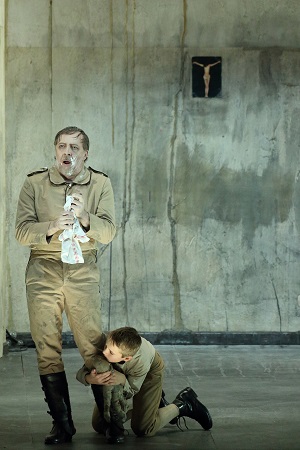 Christian Gerhaher (Wozzeck)
Christian Gerhaher (Wozzeck)
I have heard some fine Wozzecks over the years; Gerhaher must surely rank alongside the finest. He has been selective in his opera roles; it would, however, be an over-simplification verging on distortion to say that he is more at home in the concert hall. Wozzeck is, of course, a very different role from his fabled Tannhäuser Wolfram and is surely the sterner dramatic test, perhaps especially for someone with so heartbreakingly beautiful a voice. Or so it might seem on first glance, but Gerhaher is an artist at least as celebrated for intelligence and humanity. His way with words, music, and gesture too simply had one believe that this was the character he was playing. Verbal nuance without pedantry, attention to musical line without a hint of self-regard, harrowing facial expression that demanded our sympathy: yes, this was a compleat Wozzeck. Barkmin’s Marie, equally well sung (and spoken), equally sympathetic, made for a fine complement indeed. Through her artistry one felt her hopes as well as her devastation, her pride as well as her capacity for love. Wolfgang Ablinger-Speerhacke’s Captain, John Daszak’s Drum Major and Jens Larsen’s Doctor skilfully trod the line between character and caricature, no mean feat in a production that often called upon them to accentuate the grotesque. Kevin Conners as Andres and Heike Grötzinger as Margret impressed too, carving out their own dramatic potentialities, even as we knew them no more likely to succeed than the opera’s central couple. Cast from depth, this was a fine Wozzeck for singing-actors.
Hartmut Haenchen’s conducting proved efficient most of the time, albeit with a few too many discrepancies between sections of the orchestra as well as between orchestra and pit. To be fair, there were also passages—often the interludes—in which all came together to offer something considerably more than that. Haenchen’s reading was not for the most part, however, one to offer any particular revelation. He clearly knew ‘how it went’, yet the post-Wagnerian orchestra as dramatic cauldron had its juices emerge only fitfully.
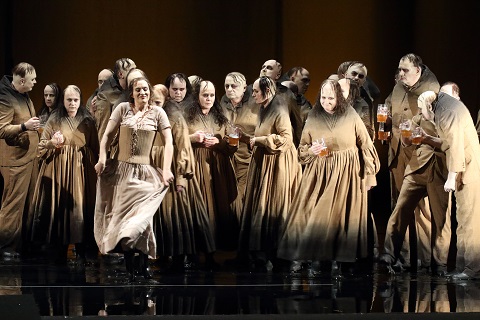 Gun-Brit Barkmin (Marie) and Ensemble
Gun-Brit Barkmin (Marie) and Ensemble
Andreas Kriegenburg’s production seemed conceptually a little unsure of what it was trying to achieve. Straddling the divide between Expressionist grotesquerie—some arresting images there—and social realism—with a curious twist of Brechtian image, not dramaturgy—is a perfectly reasonable strategy. Communication of how the two might intertwined proved more elusive. Updated to what seemed to be more or less the time of composition, the production left no doubt of the gross injustice and poverty pervading the world in which these events took place. I could have done without all the splashing round in the lake below. Kriegenburg often scored, however, in particular dramatic touches: above all, the acts of Wozzeck’s son, keen to learn from his ill-fated father: watching, listening. and in some cases, acting, as when this evidently wounded child broke his mother’s heart by painting the accusation ‘Huren’ (‘whore’) on her wall. All was lost, then: a moment of devastation. Already we knew what fate, or rather society, had in store not only for Wozzeck and Marie, but for their child too. ‘Wir arme leut’ ...
Mark Berry
Alban Berg: Wozzeck
Wozzeck - Christian Gerhaher, Drum Major - John Daszak, Andres - Kevin Conners, Captain - Wolfgang Ablinger-Speerhacke, Doctor - Jens Larsen, First Apprentice - Peter Lobert, Second Apprentice - Boris Prýgl, Fool - Ulrich Reß, Marie - Gun-Brit Barkmin, Margret - Heike Grötzinger, Marie’s Child - Alban Mondon, Lad - Jochen Schäfer, Soldier - Markus Zeitler; Director - Andreas Kriegenburg, Conductor - Hartmut Haenchen, Set Designs - Harald B Thor, Costumes - Harald B Thor, Costumes - Andrea Schraad, Lighting - Stefan Bolliger, Choreography - Zenta Haerter, Dramaturgy - Miron Hakenbeck, Bavarian State Opera Chorus (chorus director: Stellario Fagone), Bavarian State Orchestra.
Nationaltheater, Munich; Saturday 23rd November 2019.
image=http://www.operatoday.com/Barkmin%20Daszak_W._Hoesl.jpg image_description= product=yes product_title=Berg, Wozzeck - Bavarian State Opera, Munich product_by=A review by Mark Berry product_id=Above: Gun-Brit Barkmin (Marie), John Daszak (Drum Major)Images © W. Hösl
November 25, 2019
Une soirée chez Berlioz – lyrical rarities, on Berlioz’s own guitar
The booklet notes by Bruno Messina, the Berlioz scholar, read like poetry, evoking what an intimate evening with Berlioz himself might have been, in the company of those closest to him, making music for their own pleasure. “Ni festival, ni requiem, ni symphonie, ni opéra, mais une invitation à partager une soirée chez Berlioz et quelques impressions musicales, de celles qui ne font pas beaucoup de bruit mais qui s’inscrivent dans le cœur (comme ces inflexions “des voix chères qui se sont tués”) et qu’on porte longtemps avec soi…”. Though this soirée chez Berlioz is refined and lyrical, and can be enjoyed on its own terms, this recording includes many lesser known works, which enhance our appreciation of the breadth of Berlioz’s art, sensitively and beautifully performed. A must for true Berlioz aficionados.
Indeed, the instruments played here are not only period but unique. The guitar belonged to Berlioz himself, who used it regularly, and to Paganinni before him. The maker was Jean-Nicole Grobert, whom the composer knew well. Given its significance, Berlioz inscribed the guitar with his signature when he donated it to the Conservatoire de Musique. The piano was made by Ignace Pleyel and was used by Chopin and is beautifully preserved. More technical details in the notes.
The evening begins with Plaisir d’amour. It is heard here in the 1784 original for voice and piano by Jean-Paul-Égide Martini. Berlioz liked it so much that he made an arrangement for voice and small orchestra, with flutes, clarinets, horns and strings. As a child, Berlioz enjoyed the tales of the poem’s author, Jean-Pierre Florian. Around 1859, he made an arrangement for voice and small orchestra, but he would undoubtedly have heard and played the original for voice and piano. Williencourt’s technique makes this Pleyel grand from 1842 sound as agile and delicate as a fortepiano. Viens, aurore and Vous qui loin d’une amante are settings of other poems by Florian in troubador style. Roussel’s background in lute and early stringed instruments enhances his way with Berlioz’s period guitar. Viens, aurore is a setting by Lélu (1798–c1822) and Vous qui loin d’une amante a setting by François Devienne (1759–1803).
Berlioz’s La captive is best known in its orchestral version H60 from 1848, but is heard here in Berlioz’s adaptation for voice, piano and violincello (Bruno Philippe) made soon after the first version for voice and piano, from 1832. Seven songs for voice and guitar follow and three for solo guitar, interspersed with settings by Berlioz and Liszt. These are well worth including since this rare opportunity to hear Berlioz’s own guitar should not be missed. The timbre is distinctive, warmer and less strident than guitars made for different repertoire, particularly sympathetic to French style and to the elegance of D’Oustrac’s voice. These relatively unknown works also provide context for Liszt’s L’Idée fixe LW A16b an Andante amoroso “pour le piano d’après une mélodie de Hector Berlioz” making further connections between Berlioz and Liszt. Though Liszt generally preferred an Érard, this Pleyel is still closer to the instruments Berlioz knew so well, and appropriate for the the intimate feel of this “soirée chez Berlioz”.
Also included are Liszt’s transcriptions for piano (LW 205) of Berlioz’s “Danse de Sylphides” from The Damnation of Faust, and “Marche des Pèlerins” (LW A29) from Harold en Italie Berlioz’ Le Jeune Pâtre breton H 65C to a pastoral text by Auguste Brizeux (1803–1858) a poet and man of the theatre who popularized the language and heritage of Brittany. Hence, perhaps, Berlioz’s use of the cor naturel, (Lionel Renoux), evoking the sounds of Breton lovers calling to each other over mountains and valleys, “semble un soupir mêlé d’ennuis et de plaisir”. Berlioz’s Fleuve du Tage (H.5) for voice and guitar is very early Berlioz indeed, written at the age of 16. The Élégie en prose H.47 for voice and guitar sets a translation of a poem by Thomas Moore and comes from Berlioz’s Neuf mélodies irlandaises, op. 2, H. 38.
Anne Ozorio
[Click here for album contents.] image=http://www.operatoday.com/71nMFiiNhAL._SX522_.png image_description=Harmonia Mundi HMM902504 product=yes product_title=Une Soireé Chez Berlioz product_by=Stéphanie D'Oustrac (soprano), Thibaut Roussel (guitar), and Tanguy de Williencourt (piano). product_id=Harmonia Mundi HMM902504 [CD] price= $16.99 product_url=https://amzn.to/2OK2BxpKorngold's Die tote Stadt in Munich
Some of Korngold’s music I have responded to warmly, some less so. (It
would still take some persuasion, though now less than before, to drag me
to another performance of Das Wunder der Heliane.) My experience
with Die tote Stadt has been mixed too. That, however, is bye the
bye, for this new production and still more the performances within it,
superlatively conducted by Kirill Petrenko, made for a splendid evening
that more or less had me forget reservations hitherto entertained.
Petrenko’s conducting and the playing of the Bavarian State Orchestra could
hardly have been bettered. There was no doubting the care taken in his
preparation, nor his ability vividly and meaningfully to communicate
understanding of the score in the theatre. Once the harmony becomes more
interesting, during the second and third scenes, Petrenko showed himself
equally alert to its shorter-term expressive potential and, score
permitting, longer-term tonal implications. There is greater progress in
such terms here than in, say, Schreker’s more harmonically—and
dramaturgically—adventurous Die Gezeichneten, which ends up going
round and round in circles, having one thank God for Schoenberg and
Stravinsky. Petrenko likewise showed skill surpassing that of any conductor
I have heard in communicating Korngold’s motivic working as dramatic past,
present, and future. The orchestra, moreover, offered a far more variegated
sound than I heard from the Vienna Philharmonic in Salzburg in 2005; if
that calorific frenzy impressed in its own way, this was ultimately a more
revealing sound as part of an overall dramatic conception. Where some
performances of what we may broadly call ‘late Romantic’ music—a term I
generally avoid on account of chronological absurdity and levelling
generalisation—all too readily become congested, here was a panoply of
orchestral colour that shifted before our ears so as to suggest, at least
during the most skilfully composed passages, ready understanding of
Straussian phantasmagoria.
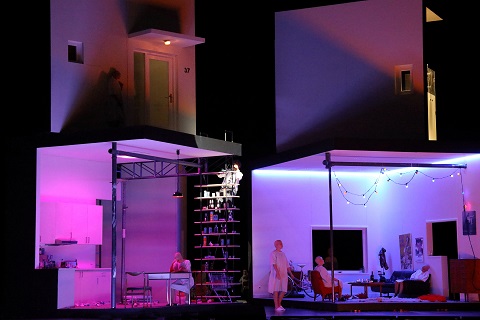 Photo credit: Wilfried Hösl.
Photo credit: Wilfried Hösl.
For whereas in Salzburg, Willy Decker’s staging (later seen at Covent
Garden too) was very much in ‘period’ keeping not only with Korngold but
also with George Rodenbach’s Bruges la morte, Fernand Khnopff, et al.—and as such will I suspect greatly have appealed to
enthusiasts—Stone’s production offered a welcome contemporary—to
us—alternative for those who, like me, find the opera’s laboured symbolism
both stifling and a little empty (as well as curiously dated for 1920).
Here, Paul’s house (no.37: no evident symbolism to me, though you may know
otherwise) is the focus for a cancer bereavement—as we learn when we later
behold Marie’s apparition—from which he shows no sign of recovering. One
room’s every wall is covered with pictures of her; he hangs her hair in his
bedroom; some of the house, furniture covered, goes unused; and so on. His
housekeeper, Brigitta, and friend, Frank, are clearly, justifiably
concerned. However, a psychonalytical dream sequence appears to offer the
route to recovery. Having at least begun to work out some of his issues
with Marie/Marietta in a dream in which all manner of strange things can
happen and do—the dead town comes into its own, multiplying Doppelgänger, Pierrot-troupes, accusations thrown as freely as
underwear, etc.—there is perhaps some hope for the future in what uncannily
looks and sounds like the morning of a fresh start. Ralph Myers’s revolving
set permits the house to transform itself, almost as if it were turning
itself inside out, as do the characters, their acts, and their neuroses.
‘It was all a dream’ may or may not be a satisfactory solution; if not,
that remains a problem with the work itself. Stone’s production makes
uncommon, if arguably reductive, sense of a text that can readily seem
somewhat silly.
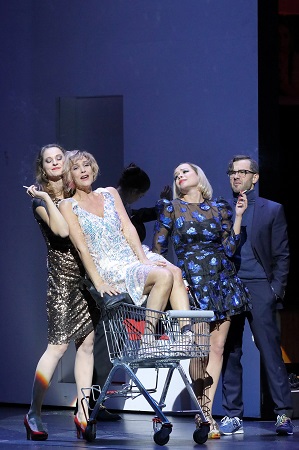 Marlis Petersen, Corinna Scheurle, Mirjam Mesak, Manuel Günther. Photo credit: Wilfried Hösl.
Marlis Petersen, Corinna Scheurle, Mirjam Mesak, Manuel Günther. Photo credit: Wilfried Hösl.
Vocally, this was unquestionably an evening to savour. Jonas Kaufmann’s
voice is a very different instrument from that of a few years ago. Sounding
more baritonal than ever, Kaufmann had lost nothing, however, of his
ability to float and turn a long line, nor to forge from word and tone that
particular, peculiar alchemy of song. In opera, further alchemy is
required, of course, with the art of gesture; this was as compelling a
stage performance—and I have seen a few—as I have seen from him. Kaufmann’s
Paul remembered, lived in, and came close to final suffocation from times
past, but in its final freshness, shared in the hope suggested, if only
suggested, by Petrenko and Stone alike. Marlis Petersen’s Marietta proved
the perfect foil, a high-spirited heir to Strauss’s Zerbinetta, albeit with
the vocal reserves and finely spun line of something more Wagnerian. Her
acting skills proved just as impressive, as did those of other partners
onstage. Jennifer Johnston’s no-nonsense yet compassionate Brigitta,
Andrzej Filończyk’s sympathetic and beautifully sung Frank, the rest of an
excellent supporting cast, estimable choral forces: all contributed to a
dream performance in every sense. In the intelligence of its accomplishment
of values both musical and theatrical, I suspect this Munich Tote Stadt will set a gold standard to successors.
Mark Berry
Erich Wolfgang Korngold, Die tote Stadt Op.12
Paul - Jonas Kaufmann, Marietta/Marie’s Apparition - Marlis Petersen,
Frank/Fritz -Andrzej Filończyk, Brigitta - Jennifer Johnston, Juliette -
Mirjam Mesak, Lucienne -Corinna Scheurle, Gaston/Victorin - Manuel Günther,
Count Albert - Dean Power; Director - Simon Stone, Conductor - Kirill
Petrenko, Assistant Director - Maria-Magdalena Kwaschik, Set Designs -
Ralph Myers, Costumes - Mel Page, Lighting - Roland Edrich, Dramaturgy -
Lukas Leipfinger, Chorus and Children’s Chorus of the Bavarian State Opera
(chorus director - Stellario Fagone), Bavarian State Orchestra.
Nationaltheater, Munich; Friday 22nd November 2019.
image=http://www.operatoday.com/Die_tote_Stadt_c__W._Hoesl.%202jpg%20%281%29.jpg image_description= product=yes product_title= Korngold, Die tote Stadt, Bavarian State Opera product_by=A review by Mark Berry product_id=Above: Ensemble
Photo: Wilfried Hösl
Exceptional song recital from Hurn Court Opera at Salisbury Arts Centre
Established in 2017, Hurn Court Opera was founded to give performance opportunities and showcase emerging young soloists at the start of their professional careers. Achievements so far include critically acclaimed productions of Die Zauberflöte and Acis and Galatea, along with two influential competitions that have produced a wealth of talented singers, some of whom are already making their mark on the operatic stage.
Siân Dicker (soprano) and Michael Lafferty (baritone), both former prize winners of the scheme, devised a tour d’horizon of English song, lieder and operatic excerpts under the banner ‘A Shropshire Lad and a Wiltshire Lass’, the whole accompanied by rising pianist and conductor Ashley Beauchamp. Familiar and seldom-performed songs framed an intriguing cocktail of comic, poignant and whimsical offerings to form a compelling evening that could have found an equally attentive audience in London’s Wigmore Hall.
Both singers, already equipped with considerable experience in opera, oratorio and recital work conveyed admirable poise, intelligent musicianship and flawless techniques. They also possessed an easy rapport with the audience in spoken introductions claiming rapt attention while clearly inhabiting differing musical personalities. This last was most evident in the two Mozart duets where Siân Dicker was a feisty Pamina and Michael Lafferty an earnest Papageno in ‘Bei Männern’ ( Die Zauberflöte). It was handsomely sung, as was ‘Là ci darem la mano’ (Don Giovanni), the latter convincing for the not-so innocent protests of Dicker as Zerlina to Lafferty’s seductive Giovanni.
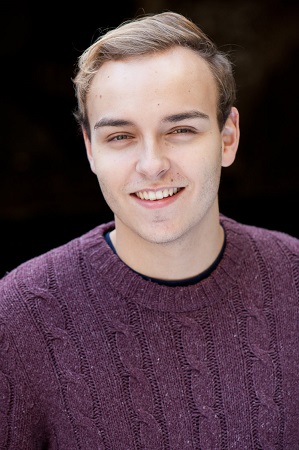 Michael Lafferty. Photo credit: Sebastian Charlesworth.
Michael Lafferty. Photo credit: Sebastian Charlesworth.
There was no doubt about Dicker’s full throttle engagement, with each song oozing characterful expression, vividly so in Libby Larsen’s witty ‘Pregnant’, Mendelssohn’s ‘Hexenlied’ and Walton’s jazzy ‘Old Sir Faulk’, all dashed off with dramatic flair that bodes well for future operatic projects. She was in her element for Jonathan Dove’s ‘Adelaide’s Wedding’ (The Enchanted Pig) where she managed to combine a haughty grandeur somewhere between Mozart’s Queen of the Night and Hyacinth Bouquet. The song could almost have been written for Dicker. But despite ample tones, gorgeously rich in the middle and fruity at the bottom, I would have liked to have heard something less ‘produced’ for Lisa Lehman’s whimsical ‘There are fairies at the bottom of our garden’.
Where Michael Lafferty began warmly yet somewhat diffidently, his well-upholstered baritone found expressive outlet in songs by Otto Nicolai, Duparc and Schubert. But it was in George Butterworth’s A Shropshire Lad (the most substantial group of songs in the programme) where he found his form. There was melting warmth in ‘Loveliest of trees’, swagger in ‘The lads in their hundreds’ and sepulchral tone for ‘Is my team ploughing?’ Best of all was the wonderfully evocative ‘Sicilienne’ by Giacomo Meyerbeer, sung with demonstrable affection and involvement.
Throughout the evening, accompanist Ashley Beauchamp was a sensitive collaborator with a chameleon-like ability to adapt to the numerous musical styles crowding this generously conceived programme.
David Truslove
Siân Dicker (soprano), Michael Lafferty (baritone), Ashley Beauchamp (piano)
Salisbury Arts Centre; Thursday 21st November 2019.
image=http://www.operatoday.com/Si%C3%A2n%20Dicker.jpg image_description= product=yes product_title=Hurn Court Opera at Salisbury Arts Centre product_by=A review by David Truslove product_id=Above: Siân DickerPhoto: Sebastian Charlesworth
Lohengrin in Munich
It was also—and perhaps more surprisingly to me—exceptional in that fine
musical performances rescued the evening from one of the silliest and most
bizarrely irrelevant productions of the work I have ever seen. (For what it
is worth, staging Lohengrin is an issue to which I have given a
good deal of attention; it is, for instance, the subject of a chapter in
one of my books,
After Wagner
.) Increasingly, I have felt that opera performances working only as
music—shorthand, I know—and not as theatre have little interest for me any
more; I may as well stay at home and listen to a recording or read the
score. This, however, was exceptional in that orchestra, singers, and
conductor managed to convince me that I had experienced a dramatic
performance of Lohengrin, acting included, that had little or
nothing to do with what Richard Jones had served up.
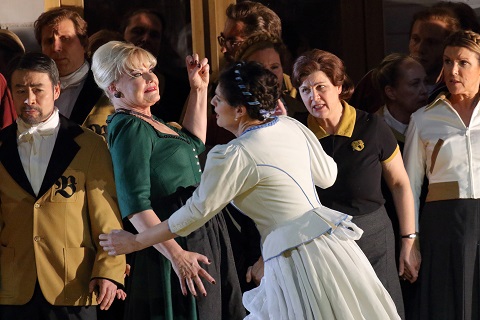 Karita Mattila (Ortrud), Anja Harteros (Elsa von Brabant).
Karita Mattila (Ortrud), Anja Harteros (Elsa von Brabant).
Jones presented a banal tale, if one may call it that, of a middle-aged,
middle-class heterosexual couple—a neglected group of whose experience we
all should hear more—marrying somewhere provincial and building a new house
there. That seemed to be it, save for when the house project did not work
out as planned and the house was no longer present. There was occasionally
promise of something else: brown-shirted uniforms suggested something
obvious at the start, yet disappeared in favour of an eccentric
combination—at least in any circles I know—of Tracht and
tracksuits. (Maybe savings needed to be made to finance the crane that
hoisted the roof onto the house.) For some reason, a difficult-to-read
floral inscription in the front garden imitated that on the front of
Wagner’s Wahnfried villa. Doubtless one could propose all manner of
symbolic explanations concerning what various things might have meant; one
would have to, really, since the production appeared not to bother. I am
sure we are all, ‘in a very real sense’, as an Anglican bishop might have
it, building a house, and so on and so forth, but really. King Henry the
Fowler appeared to be a marriage celebrant, not unreasonably confused by
proceedings around him; quite who most of the others were eluded me. Swords
sat awkwardly with the narrative, to put it mildly, yet at least reminded
us that Wagner’s opera has a more involving story to tell. All was blocked
well: credit where credit is due to the Abendspielleitung
(Georgine Balk) and, presumably, to the original production. I cannot
imagine otherwise what else, if anything, ran through Jones’s head. O for a
Hans Neuenfels, a Peter Konwitschny, a Stefan Herheim…
Lohengrin ‘itself’ fared much better. Anja Harteros took a while to warm up, her first act Elsa veering in and out of focus, verbally as well as musically. Once focus had been achieved however, hers was a battle royal with rival Schillerian queen—and sometime Elsa—Karita Mattila. To see and hear the two was to experience something akin to a duet between finest woodwind principals, timbres contrasting yet complementary, albeit with finely honed words and gesture too. The greatest Ortruds command attention even during the first act, the character onstage yet having little to sing. Waltraud Meier did the first time I saw her on stage; so here did Mattila, her interpretative and communicative zeal amply compensating for the vacuity of Jones’s production. Klaus Florian Vogt’s Lohengrin did not settle immediately and is famously not to all tastes. For me, it works considerably better than his other Wagner roles, a sense of unearthly ‘purity’ not at all inappropriate; like his Elsa and Ortrud, he offered a consummately professional performance throughout. So too did Wolfgang Koch as Telramund. An estimable, always likeable artist, he sometimes seemed slightly out of sorts, but there was no doubting the intelligence of his properly Wagnerian blend of word and tone; likewise Christof Fischesser’s King Henry. Gantner’s excellent Herald fully lived up to expectations, as did the Tölz trebles acting as pages and their Brabantian noble colleagues.
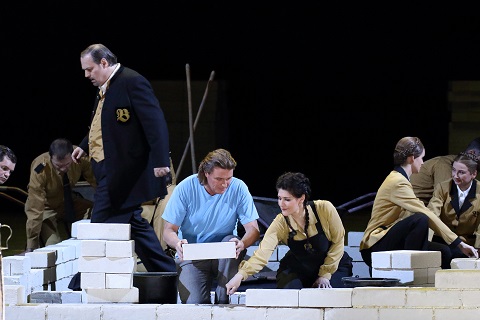 Klaus Florian Vogt (Lohengrin), Anja Harteros (Elsa von Brabant).
Klaus Florian Vogt (Lohengrin), Anja Harteros (Elsa von Brabant).
If the orchestra was not always quite on peak form, the first act Prelude a
little bumpy at times, one would have had to be wishing to find fault to be
disappointed. Its strings sounded golden, more Vienna or Dresden than, say,
Berlin, though there were naturally darker passages too, not least during
the Prelude to the second act. Characterful woodwind and a brass section
capable of sometimes breathtaking tonal variegation offered further
orchestral pleasure and insight. Lothar Koenigs’s direction of the whole
was sane, sensitive, and unassumingly purposeful. It certainly never drew
attention to itself, which, after
a certain conductor at Bayreuth this summer
was more than welcome, but instead gave the impression of ‘natural’
communication of Wagner’s melos. There were a few cases of
surprising disjuncture between pit and chorus, but they were rectified soon
enough and did little to spoil one’s enjoyment of some fine choral singing.
All in all, then, an interesting evening—if not quite in the way one might
have expected.
Mark Berry
Richard Wagner: Lohengrin
King Henry the Fowler - Christof Fischesser, Lohengrin - Klaus Florian
Vogt, Elsa - Anja Harteros, Friedrich von Telramund - Wolfgang Koch, Ortrud
- Karita Mattila, King’s Herald - Martin Gantner, Four Brabantian Nobles -
Caspar Singh/ George Virban/ Oğulcan Yilmaz/ Markus Suihkonen, Four Pages -
Members of the Tölz Boys’ Choir, Gottfried - Lukas Engstler; Director -
Richard Jones, Conductor - Lothar Koenigs, Designs - Ultz, Lighting - Mimi
Jordan Sherin, Video - Silke Holzach, Choreographical Assistance - Lucy
Burge, Chorus and Extra Chorus of the Bavarian State Opera (chorus
director: Stellario Fagone), Bavarian State Orchestra.
Nationaltheater, Munich; Thursday 21st November 2019.
image=http://www.operatoday.com/Lohengrin%20Munich%20title.jpg image_description= product=yes product_title=Lohengrin, Bavarian State Opera product_by=A review by Mark Berry product_id=Above: Ensemble, Bavarian State OperaPhotographs courtesy of Bavarian State Opera
November 22, 2019
Hansel and Gretel in San Francisco
The grand foyer of the San Francisco opera house was already decked out in green boughs and red bows though Thanksgiving has yet to come. It’s the time of year when some adults think about exposing their children to high art, albeit art that is perceived to be accessible to their innocent psyches. And opera and ballet companies want to take this urge to the bank.
This production by British designer Anthony McDonald, a veteran of several British Nutcracker productions, does wish to tug a bit at your heartstrings more than frighten your children. During the overture you learn that a poor family living in a quite lush and scenic Alpine meadow has insufficient food on its dinner table.
But the two resourceful children in search of strawberries conjure a quite wonderful adventure for themselves in an enchanted forest of golden hued trees filled with fanciful spirits. It was fun to identify these witty additions to the story — I saw Cinderella, Little Red Riding Hood and Rapunzel, but there were more.
A lively wood sprite ballerina opened hidden doors on the ornate frame that was a false proscenium to bring on a charming hook nosed, miniature soprano sandman to sedate the children and later a lovely, white dew fairy to awaken them. Atop the ornate frame was an elaborate cuckoo clock that revolved backwards during the overture taking us back to another time, and of course later participating in the children’s musical games.
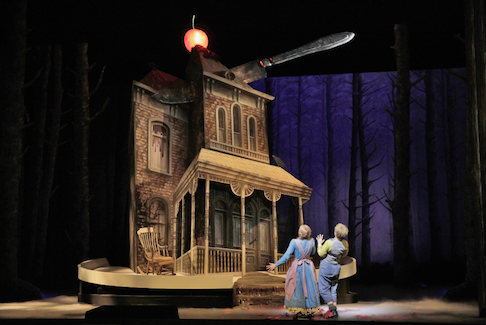 The Gingerbread House
The Gingerbread House
Though the gingerbread house did not look very tasty (an all brown Victorian cottage with a great big illuminated cherry on its top), it revolved to expose a huge marmite that broke open to reveal a boiled and charred witch, the only macabre moment of the evening and it seemed out of place. For the record the witch was first female, then male thus avoiding a stereotypical witch branding.
There was gorgeous horn playing to begin the evening (and in fact throughout the evening), conductor Christopher Franklin evoking very bright playing from his orchestra that made the performance far more folksongish than Wagnerian. All the familiar pieces of the opera were in great relief, though the beautiful little prayer was uncomfortably soft and somehow the chorus of reanimated children at the end lacked meaning, possibly because we never really felt that Hansel and Gretel were threatened to begin with.
The wanted charm of the evening did not overcome the prevailing atmosphere of boredom I felt. And if I was bored I assume that all those targeted families will be a bit bored as well. For the record the audience was not families (I did saw three or four children) but the usual San Francisco opera audience who are now offered but eight annual operas. This could be a sufficiently satisfying number if all eight were of sufficient weight.
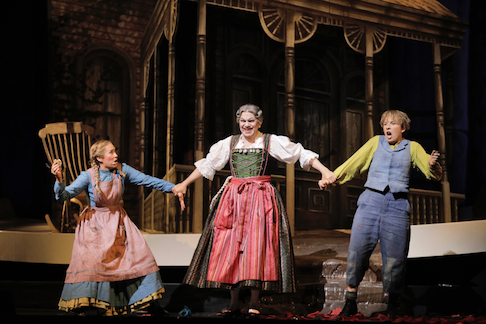 Hansel and Gretel with the Witch
Hansel and Gretel with the Witch
Hansel was mezzo-soprano Sasha Cooke of beautiful voice and strong tone, Gretel was soprano Heidi Stober who brought infectious energy and fine singing to her role. Mlles. Cooke and Stober are regulars at San Francisco, as is Michaela Martens who was effective as the mother. Alfred Walker, a bass-baritone from New York, provided a beautifully sung father while underlining the ethnic diversity we take for granted in opera. Tenor Robert Brubaker brought charm rather than menace to the Humperdinck witch. Adler Fellows Ashley Dixon and Natalie Image were, respectively, the Sandman and Dew Fairy. Ballerina Chiharu Shibata offered lovely sous-sus and graceful pas de chat to the Woodsprite.
Hansel and Gretel was sung in an English language translation by David Pountney.
Michael Milenski
Cast and production information:
Hansel: Sasha Cooke; Gretel: Heidi Stober; The Witch: Robert Brubaker; Gertrude: Michaela Martens; Peter: Alfred Walker; Sandman: Ashley Dixon; Dew Fairy: Natalie Image; Will-o'-the-wisp: Chiharu Shibata. Childrens Chorus and Orchestra of the San Francisco Opera. Conductor: Christopher Franklin; Stage Director & Production Designer: Antony McDonald; Associate Stage Director: Danielle Urbas; Associate Designer: Ricardo Pardo; Lighting Designer: Lucy Carter; Revival Lighting Designer: Neill Brinkworth; Choreographer Lucy Burge. War Memorial Opera House, San Francisco, November 21, 2019.
image=http://www.operatoday.com/HAnselGretel_SFO1.png
image_description=
product=yes
product_title=Hansel and Gretel at San Francisco Opera
product_by=A review by Michael Milenski
product_id=Above: Heidi Stober as Gretel, Sasha Cooke as Hansel
Photos by Cory Weaver courtesy of the San Francisco Opera.
An hypnotic Death in Venice at the Royal Opera House
Aschenbach’s gesture, in the opening scene of David McVicar’s astonishingly hypnotic production of Benjamin Britten’s final opera, anticipates a symbol which does not appear until the latter scenes of Mann’s text, when, following the vulgar musical performance of a group of ‘beggar virtuosi’ in the front garden of the Hotel des Bains, he steals a glance at the young Polish boy Tadzio and reflects, in what Mann describes as ‘that sober objectivity into which the drunken ecstasy of desire somethings strangely escapes’: ‘He’s sickly, he’ll probably not live long.’ Into Aschenbach’s mind intrudes a memory of his parents’ house, many years ago: ‘he suddenly saw that fragile symbolic little instrument as clearly as if it were standing before him. Silently, subtly, the rust-red sand trickled through the narrow glass aperture, dwindling away out of the upper vessel, in which a whirly vortex had formed.’ [1]
Thus, with subtle symbolic foreshadowing, McVicar begins to tell Mann’s and Britten’s tale. Like the rust-red hair shared by the sinister figures who cross Aschenbach’s path in the action which unfolds, the vanishing sand is ominous. “My mind beats on and no words come,” sings Aschenbach. Time is running out: “No sleep restores me.” Repeated references to the passing hours infiltrate Mann’s text and in McVicar’s production the defiant clock makes its presence felt, nowhere more so than when an outsize pendulous clock-face descends and hangs in suspended motion above the gondola in which Aschenbach sits, agitatedly, his attempt to depart from Venice thwarted by the misdirection of his luggage.
The Hotel Barber may promise to restore his youthful looks but Aschenbach’s creative spirit is sterile, guttering like the candles on his desk. His journey to the South, driven by the Strange Traveller’s encouragement that he might quench his spiritual thirst - “a leaping, wild unrest, a deep desire! […] a sudden desire for the unknown” - is an attempt to return to the past: “I am led to Venice once again,” Aschenbach sings, later fearing, “O Serenissima, be kind, or I must leave, just as I left before.” But, the sand runs steadfastly downwards.
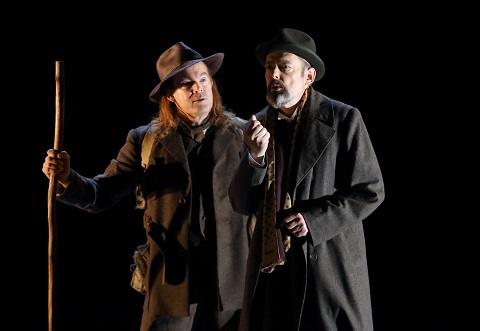 Gerald Finley (Traveller) and Mark Padmore (Aschenbach). Photo credit: Catherine Ashmore.
Gerald Finley (Traveller) and Mark Padmore (Aschenbach). Photo credit: Catherine Ashmore.
The tremendous achievement of McVicar, his creative team and a superb, extensive cast, is to simultaneously portray the mythical aura of the city of Venice and present a disturbing portrait of a psychology laid bare. The naturalism of the 1910s setting and the astonishingly detailed realism of Vicki Mortimer’s designs are intruded by the surreal, the grotesque and the demonic. The result for Aschenbach is catastrophic.
McVicar, Mortimer and lighting designer Paul Constable exercise masterly control of these two intersecting energies, capturing in form and flux both the wretched reality and the mythic grandeur of Venice. A prevailing darkness is punctuated by sudden illuminations of light. The golden glow that greets Aschenbach when the Hotel Manager reveals the glorious view from the window of his room, for a brief moment bathes the drama in hope. But, elsewhere, for all the vivid colour that Apollo’s sunrays reveal, the Lido often seems to shimmer with a secret sickness. When the vista opens to reveal the glistening teal waters of the limitless sea, the easefulness that the brightness offers is tempered by a thick, unmoving green glow. The sky above is cloudless, but it is muted by a patina of soft grey or pink flush.
When Aschenbach arrives by gondola through the swirling mists, we can almost smell the pungency - what he later describes as a “sweetish medicinal cleanliness, overlaying the smell of still canals”. Even the clarion purity of the cry of the Strawberry Seller (Rebecca Evans) as she advertises her wares is deceptively sweet, for her red fruit is laden with choleric juices.
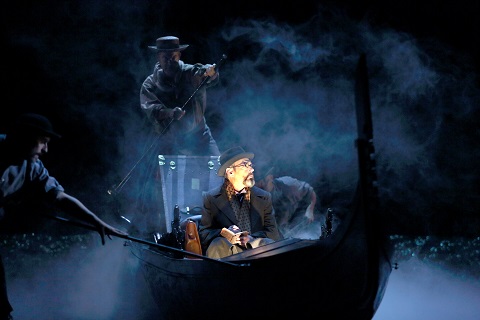 Gerald Finley (Gondolier) and Mark Padmore (Aschenbach). Photo credit: Catherine Ashmore.
Gerald Finley (Gondolier) and Mark Padmore (Aschenbach). Photo credit: Catherine Ashmore.
As within Aschenbach’s own imagination and consciousness, nothing is still in the city or its lagoon. A stage-length gondola is expertly manipulated across and around the stage, twisting through the inky blackness; beyond pillars and arches which slide with the slick slipperiness of the boatman’s oar we glimpse piazzas, arches, basilicas, as our emblematic Charon carries Aschenbach towards his fate. The stagnant waters dominate, and McVicar repeatedly lets a black drop fall, to isolate Aschenbach as he sinks further into the abyss of his own mind and soul. Venetian hordes bustle and barter: tourists from across Europe gather in the cafés and on the strand; lace-sellers and glass-makers press their wares upon the repulsed Aschenbach, crowding beneath the claustrophobic arches. The individuals of the company excel, and deserving of especial note are Dominic Sedgwick’s English Clerk, who is the lone deliverer of the truth of Venice’s innate corruption, and Colin Judson’s Hotel Porter, though the latter’s middle-aged censoriousness belies the youthfulness of Mann’s original.
Amid the restlessness, though, there is statuesque motionlessness: in the form of the young Polish boy, Tadzio, holidaying with his mother, the Lady of the Pearls (Elizabeth McGorian), and his siblings. And, it is to this Hellenic apparition - what Mann’s narrator describes as ‘a statuesque masterpiece of nature’ - that Aschenbach is drawn, a vulnerable moth to a flame, increasingly convinced that, in the words of Mann’s narrator, ‘it was inevitable that some kind of relationship and acquaintance should develop between Aschenbach and the young Tadzio’.
In both novella and opera, Aschenbach is repeatedly reassured by moments, actual or self-delusory, in which the respective gazes of man and boy are locked together, and McVicar emphasises this ‘looking’ and ‘knowing’, not just through the frighteningly confident stare with which Leo Dixon, First Artist of the Royal Ballet, fixes the elderly writer with eyes that tempt and dare, but also through more subtle symbols: the small round spectacles which Aschenbach clutches and fumbles; the Brownie box-camera positioned on the beach, its single-focus lens shrouded from the sun’s heat. “So, my little beauty, you notice when you’re noticed do you?” Aschenbach’s imagined private contact with Beauty hypnotises him, inducing a mental, visual and moral stagnation: he cannot look away and, incapable of moral resolution, abandons himself to his apocalyptic destiny.
As the self-tormented protagonist, Mark Padmore gives a performance of unwavering acuity and accomplishment. For all his achievements as Bach’s Evangelist and as an interpreter of Schubert’s and of Britten’s songs, he surely has done nothing finer than this. The sweetness of his tenor, which launches lightly and cleanly into the ethereal but also communicates the pain and pathos of the actual, makes his Aschenbach a more sympathetic sufferer than we might imagine possible.
Aschenbach may be isolated from his fellow travellers in Venice but the directness of Padmore’s delivery, as he dominates the forestage, and the exemplary articulacy of his diction, hold the fictional artist and the real audience in a compelling communion. Mann described his protagonist’s inner maelstrom, with autobiographical resonance, as a combustible creativity in which the thoughts and spirit of the writer’s aged and youthful self, circled each other animatedly. [2] And, this creativity, which is both fertility and conflagration, is what Padmore, and McVicar, capture so persuasively. Padmore’s Aschenbach is not so much animated as agitated and consumed, as evidenced by the cruel glow of barber’s red cheek-rouge. The writer’s descent from novelistic speculations and the belief that beauty will enable him to “liberate from the marble mass of language the slender forms of an art”, to the desperate recognition that he “can fall no further”, is consummately controlled and paced.
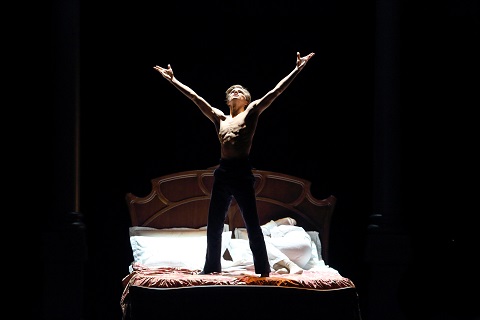 Leo Dixon (Tadzio). Photo credit: Catherine Ashmore.
Leo Dixon (Tadzio). Photo credit: Catherine Ashmore.
At the start Padmore demonstrates surprising depth and vigour of voice, as when he celebrates his reputation - “I, Aschenbach, famous as a master-writer, successful honoured, self-discipline my strength”. It’s an almost fiery self-assertion which seeks to deny and defy encroaching self-knowledge: “Why am I now at a loss? … Would not the light of inspiration had not left me.” During his Act 2 pursuit of Tadzio and his family through the fetid waterways and alleys of Venice, occasionally Padmore is subsumed within the acrid agitation. But, it is the tenor’s vocal nuance, perspicacity and control which most astounds: that, and the stamina - this is an enormously demanding sing and Padmore’s tenor is no less penetrating or well-supported at the excoriating close of the opera than it was three hours previously, when Aschenbach had sat alone in his darkened study.
‘“You see, Aschenbach has always only lived like this” - and the speaker closed the fingers of his left hand tightly into a fist - “and never like this” - and he let his open hand hang comfortably down along the back of the chair,’ reports Mann’s narrator. And, so, Padmore’s hands in many ways communicate Aschenbach’s distress and demise. Initially, he holds himself with the rigid conformity of his class, hand behind back, spine ram-rod rigid. Later, he grips his ornate leather-bound notebook, in which he seeks to translate his emotive response to Tadzio’s beauty into Platonic art, with clenched fingers; similarly, he contorts his hat’s rim and twists its crown in febrile fists. And if, when accepting the offerings of the city he exults as “Serenissma”, Aschenbach’s arms are outstretched, his palms open, then he later acknowledges his moral degeneracy with the same welcoming, or resigned, gesture.
Dixon’s Tadzio is introduced to us as a ‘real’ boy, somewhat petulant, proud and aware of the effect of his posture and pose. In fact, McVicar might have made the Polish family’s entrance more markedly gaze-grabbing, for they seem to slip into the hotel foyer without undue notice; only in Aschenbach’s feverish imagination does Tadzio almost instantly become an immortal emblem of Hellenic beauty and form. And, what is so compelling thereafter is the way the statuesque is always hovering on the cusp of motion: this Tadzio is the union of art and life for which Aschenbach longs.
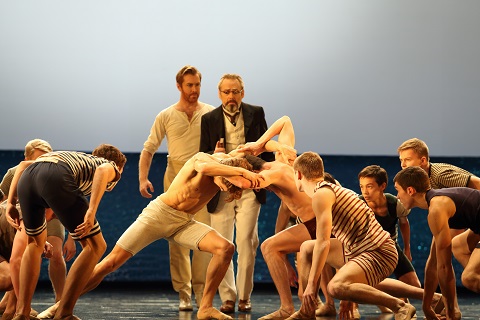 Tim Mead (Apollo), Mark Padmore (Aschenbach). Photo credit: Catherine Ashmore.
Tim Mead (Apollo), Mark Padmore (Aschenbach). Photo credit: Catherine Ashmore.
McVicar does not shy from the potential difficulties posed by the dance elements of Britten’s opera and, just as the opera assimilates both realism and surrealism, so the dance segues seamlessly from naturalism to artifice. In the children’s beach games, cartwheels and tumbles twist into pirouettes and entrechats, the youths’ athleticism suggesting both freedom and rebellious danger. Dixon’s duets with Olly Bell’s Jaschiu shift between aggression and sensuality. The crouches, curves and curlicues are quite simply mesmerising to behold. The Games of Apollo have a choreographic persuasiveness which beguiles. I was not entirely convinced, though, by McVicar’s notion of an Apollo-cum-gym teacher; Garsington's 2015 production seemed more forthright and more successful in this regard. But, Tim Mead was penetrating and dulcet in equal measure, if a little dour for the sun God.
From his first uncanny entrance, as the Stranger-Traveller in the graveyard, understated but suggestive in his intimations to the troubled Aschenbach, Gerald Finley injected the grotesque, ghostly and mysterious into the drama. His incarnations accrued symbolic and disturbing resonance: his lewd, lecherous Elderly Fop appalled; the vanishing gondolier alarmed; the crude balladeer - the Leader of the Players - shocked, as much for the faux-dwarf deformity that he relished brandishing as for the menacing taunt, “How ridiculous you are!”, with which he and his troupe flagellated the flinching Aschenbach.
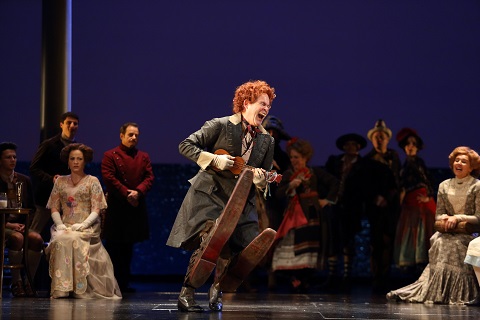 Gerald Finley (Leader of the Players). Photo credit: Catherine Ashmore.
Gerald Finley (Leader of the Players). Photo credit: Catherine Ashmore.
The culmination of Aschenbach’s struggle to reconcile the aesthetic with the homoerotic is a Dream sequence of terrifying viscerality. Apollo and Dionysus fight for supremacy as Aschenbach writhes on a bed between them; Tadzio mounts the sleeping Aschenbach’s counterpane and strikes a pose of proud confrontation.
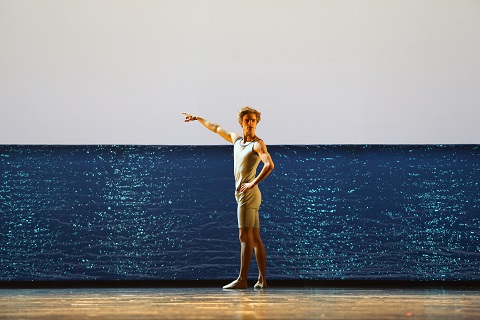 Lee Dixon (Tadzio). Photo credit: Catherine Ashmore.
Lee Dixon (Tadzio). Photo credit: Catherine Ashmore.
But, McVicar and Padmore save something, perhaps everything, for the opera’s closing sequence, which is both transcendent (symbolic and mythic) and real (psychologically penetrating). Dixon’s beautifully muscular Tadzio stands upright - poised or posed - against the horizontal line where the sea meets the sky: a symbol of the Beauty which exerts a fatal fascination over Aschenbach’s fading creating imagination. The boy is a ‘perfect’ form, but one which leads Aschenbach into the formless nothingness of the Venetian waters, and on to the sea, and onwards to oblivion.
In Mann’s novella, Aschenbach strains to identify the young boy’s name: is it ‘Adgio’, or ‘Adgiu’, with a long u, the ‘euphony befitting to its object’? In the opera, the children’s affectionate “Adziù!” merges with the demonic cries of Dionysus's “Aa-oo”. The Hellenic idol, Tadzio, has a name which trickles like the sands of time: Adziù - Tadziu - Todesengel. The angel of death. But, even as we watch Padmore’s Aschenbach slump into eternal slumber, we see Dixon’s Tadzio scoop and spin, an emblem of Beauty eternal. And, we remember that Aschenbach, watching the children’s beach games, had rejoiced: “Ah, how peaceful to contemplate the sea, immeasurable, unorganised, void. I long to find rest in perfection.”
Claire Seymour
Gustav von Aschenbach - Mark Padmore, Traveller/Old Gondolier/Hotel Manager/Elderly Fop/Hotel Barber/Leader of the Players/Voice of Dionysus - Gerald Finley, Voice of Apollo - Tim Mead, Tadzio - Leo Dixon, Lady of the Pearls - Elizabeth McGorian, Jaschiu - Olly Bell, Strawberry Seller -Rebecca Evans, Lace Seller - Masabane Cecilia Rangwanasha, Danish Lady - Elizabeth Weisberg, English Lady - Katy Batho, Russian Nanny - Rosie Aldridge, German Mother - Hanna Hipp, Russian Spinster - Amanda Baldwin, French Mother - Rebecca Lodge Birekebaek, Hotel Porter - Colin Judson, Boy Player - Andrew Tortise, Glass Maker - Sam Furness, Steward - Andrew O’Connor, English Clerk - Dominic Sedgwick, German Father - Michael Mofidian, Lido Boatman - Byeongmin Gil, Russian Father - Dominic Barrand, Russian Boy - Mathew Prichard, Tadzio’s Sisters - Corey Annand/Alice Guilot, German Boy - Lewis Bondu, Polish Governess - Sirena Tocco, French Girl - Adrianna Forbes-Dorant, Russian Girls - Fleur Hinchchliffe/Henrietta Howley, Dancers (David Stirrup, Arnau Velazquez, Aitor Viscarolasaga López, Hayden Davis, Euan Garrett, Matthew Humphreys, Zavier Linstrom, Leonardo McCorkindale, Casper Mott, Alfie Pearce, Harry Sills), Actors (Josephine Arden, Irene Hardy, Marcos James, Simon Johns); Director - David McVicar, Conductor - Richard Farnes, Choreographer - Lynne Page, Designer -Vicki Mortimer, Lighting Designer - Paule Constable, Associate Director - Leah Hausman, Associate Choreographer - Gareth Mole, Orchestra of the Royal Opera House.
Royal Opera House, Covent Garden, London; Thursday 21st November 2019.
[1] Translated by David Luke, ‘ Death in Venice’ and Other Stories (Secker & Warburg, 1900)
[2] ‘Sein Geist kreiste, sein Gedächtnis warf uralte, seiner Jugend überlieferte und bis dahin niemals von eigenem Feuer belebte Gedanken’, in Die schönsten Erzählungen der Welt (The most beautiful stories in the world ) (1938).
Photo credit: Catherine Ashmore
November 20, 2019
A Baroque Christmas from Harmonia Mundi
Daucé and Ensemble Correspondances are among the finest of many very specialists in French baroque. Please read here about their Le Concert Royale de la Nuit, their recreation of the extravaganza with which Louis XIV dazzled his Court. They have also focused on Charpentier and in particular the Histoires sacrées (Please read more here), which have roots both in sacred oratorio and in the mystery plays of the Middle Ages. Their performances are outstanding: paragons of the art, presented with stylish flourish. This set is worth purchasing for this superlative Charpentier.
Charpentier’s patron was Marie de Lorraine, Duchesse de Guise, an independent woman whose tastes were freer and more informal than those at the royal Court. In the Pastorale sur la Naissance de Notre Seigneur Jésus-Christ, H. 483, Charpentier adapts the pastoral style into a work of piety, somewhat unusual at the time. Between 1684 and 1686 he created three versions, with different second parts, all of which are recorded together for the first time on this disc.
“The first part of the pastorale is imbued with solemnity”, writes Daucé. “The protagonists evoke the condition of humanity, permeated by sin, violence, darkness and death, and, in this state of extreme wretchedness, call for a divine sign bringing light, peace, justice and redemption.”. The exquisite balance of voices in the ensembles suggests rapture, and the restrained power of the soloist in “Ecoutez-moi, peuple fidele” suggests emotional authority. Charpentier’s instrumental writing is equally meticulous, marking the “contrast between the tenuousness of the recitative and the plenitude of the chorus, and above all of the device of silence”. The instrumental interlude that is the “Simphonie de la Nuit” marks in many ways the spiritual core of the first of the two parts of this Pastorale. A sublime “Paix en terre” completes the first half: voices and instruments in glorious harmony.
The second part of H.483 is a series of vignettes illustrating the Nativity scene. Particularly attractive is the section “Cette nuit d’une vierge aussis pure que belle”, the countertenor line lambent and clear, haloed by female voices. All three second parts follow the same pattern but each section within is different. In version H.483a, “We encounter the naïve and folklike elements which the first part of the work had completely avoided”, writes Daucé. “Here the musical gesture draws on the same popular imagery with which painters and designers have always depicted the Nativity scene.” Especially impressive is “Heureux bergers” for tenor with ensemble. This version ends joyously, voices accompanied by pipes, strings and percussion. “Faisons de nos joyeux cantiques”, “Menuet de la Bergère” and “ Ne laissons point sans louanges”. There are just four sections in the second part of version H.483b. “Le Soleil recommence à dorer nos montagnes” is contemplative, introducing a more reverential character. The infant Jesus is addressed as “Ouy Siegneur” framing the last section which is along as the first three sections put together, for it celebrates the “Source de lumière et de grâce”.
Also included on the Ensemble Correspondances disc is Charpentiers’ Grands antiennes de O de l’avent (1693) – ten anthems, each beginning with the word “O” on the veneration of Advent. The best -known piece on this set will be Bach’s Christmas Oratorio (Weihnachts-Oratorium) BWV 248 with René Jacobs conducting the RIAS Kammerchor and Akademie für Alte Musik with soloists Dorothea Röschmann, Andreas Scholl, Werner Güra and Klaus Häger, all then at their prime. Recorded in 1997, this performance evokes the spirit of early 18th century Lutheran piety. In modern times, we’re overwhelmed by commercialized Christmas kitsch and consumerist excess, and the banality of the seasonal music that comes with it. All the more reason then to turn to performances like this which reflect the real values of Christmas, and the promise of hope in dark times. Strong stuff, but necessary. The fourth disc on this set is a collection of pieces by Corelli (Concerto Grosso), Johann Rosenmüller, Buxtehude, Heinrich Schütz (Heute ist Christus geboren, Concerto Vocale/René Jacobs), Louis-Claude Daquin, Domenico Zipoli, and Claude Bénigne Balbastre from performances recorded between 1976 and 2004.
Anne Ozorio
image=http://www.operatoday.com/Baroque_Christmas.jpg image_description=Harmonia Mundi HMX2908984.87 [4CDs] product=yes product_title=A Baroque Christmas product_by=Akademie für Alte Musik Berlin; RIAS Kammerchor; Concerto Vocale; René Jacobs - Direction; Ensemble 415; Chiara Banchini - Direction; Jesper Christensen - Direction; Ensemble Correspondances; Sébastien Daucé - Direction; Cantus Cölln; Concerto Palatino; Konrad Junghänel - Direction; René Saorgin - Orgue. product_id=Harmonia Mundi HMX2908984.87 [4CDs] price=$18.69 product_url=https://amzn.to/2QENIz4November 19, 2019
Bampton Classical Opera's Young Singers' Competition - Winner Announced
The decision was reached after a superb final on Sunday 17 November at the
Holywell Music Room, Oxford. The adjudicators were renowned British singers
Bonaventura Bottone and Jean Rigby, and the esteemed accompanist and
conductor Phillip Thomas.
Lucy is awarded £1,500, Daniella and Carolyn £300 each. Dylan is awarded
£500.
This biennial competition was first launched in 2013 to celebrate Bampton
Classical Opera’s 20th birthday, and is aimed at identifying the
finest emerging singers currently studying or working in the UK. From an
initial entry of over 50 young singers aged 21-32 and after two preliminary
rounds, six were chosen to compete at the public final in the Holywell
Music Room. The finalists were Natasha Page (soprano), Jade Moffat
(mezzo-soprano), Daniella Sicari (soprano), Lucy Anderson (soprano), Giulia
Laudano (mezzo-soprano) and Carolyn Holt (mezzo-soprano). Unfortunately
Jade Moffat was unable to participate in the Final due to ill health.
Lucy Anderson’s varied programme included Smetana’s ‘Och, jaký žal!...Ten
lásky sen’ from The Bartered Bride, Fauré’s ‘Nell’ from 3 Songs Op.18, Richard Strauss’ ‘Cäcilie’ from 4 Lieder Op 27, James MacMillan’s ‘Ballad’ from 3 Scottish Songs and Ben Moore’s The Audience Song.
The judges were impressed with Lucy’s overall performance, and her
partnership with Dylan Perez. Bonaventura Bottone said:
“The First Prize winner, Soprano Lucy Anderson, was wonderfully
partnered by the outstanding accompanist Dylan Perez who took the award
of accompanists’ prize. Strongest in her characterisation of Marenka's
aria ‘Och, jaký
žal!...Ten lásky sen’, through to closing with Ben Moore's sizzling
'The Audience Song', Lucy communicated in delightful collaboration with
Dylan to present a musically expressive recital programme.”
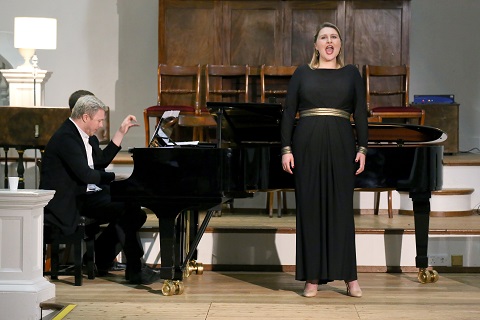 Lucy Anderson and Dylan Perez. Photo credit: Robert Piwko.
Lucy Anderson and Dylan Perez. Photo credit: Robert Piwko.
Daniella Sicari completed her postgraduate studies at the Royal Northern College of Music with Mary Plazas. Roles includes Despina (Così fan tutte), La Fée (Cendrillon), and Gretel (Hansel and Gretel). She previously trained at the Western Australian Academy of Performing Arts with Patricia Price. Daniella is the recipient of numerous awards such as the WA Young People and the Arts International Award, Amanda Roocroft Prize, the Joyce and Michael Kennedy Strauss Prize, John Cameron Award for Lieder, the Elizabeth Harwood Prize and Robin Kay Memorial Prize. In 2018 she worked with Clonter Opera and this year she had her debut at the Buxton International Festival, performing the role of Sticks in the UK premiere ofThe Orphans of Koombu and has just returned from Norway performing Sweeney Todd with Bergen National Opera.
Carolyn Holt is from a farming background in Ireland. She was the winner of the Dermot Troy Prize for the best Irish singer in the 2019 Veronica Dunne International Singing Competition and recently sang the role of Sister Helen Prejean in the UK staged premiere of Dead Man Walking in Glasgow, to great critical acclaim. She was a semi-finalist at the Grange Festival International Singing Competition, the winner of the Irish Heritage Bursary, the Audience Prize winner at the NI Opera Festival of Voice and the Sybil Tutton Award. She is a graduate of the Royal Irish Academy of Music, the Royal Academy of Music and the Royal Conservatoire of Scotland, where she performed many roles including Dido (Dido and Aeneas) and Mrs Jones in Weill’s Street Scene. She has performed with Irish National Opera and the Orchestra of the Age of the Enlightenment and performs regularly with orchestras and choral societies at home and abroad.
American pianist Dylan Perez is the current Lord and Lady Lurgan Collaborative Piano Fellow at the Royal College of Music. He graduated from the Guildhall School of Music and Drama with Distinction in the Artist Diploma. Dylan has received the Gerald Moore Prize for Accompanists, the Paul Hamburger Prize for Accompaniment and was a semi-finalist in the Wigmore Hall/Independent Opera International Song Competition and Das Lied International Song Competition. Dylan is a Britten-Pears and Oxford Lieder Young Artist, and an alumnus of the Franz-Schubert-Institut. Dylan recently made his Wigmore Hall recital debut and has performed at Barbican Hall, Milton Court Concert Hall, St Martin-in-the-Fields and Cadogan Hall. image=http://www.operatoday.com/Lucy%20Anderson.jpg image_description= product=yes product_title=Bampton Classical Opera, Young Singers’ Competition 2019 product_by= product_id=Above: Lucy Anderson
Photo credit: Robert Piwko
November 18, 2019
Philip Glass's Orphée at English National Opera
Cocteau’s take on the Orphée myth is a touch idiosyncratic and the
allegory is reset, like tuned in and tuned out radio stations (a recurring
motif in this staging), to an unfolding of the story in a contemporary
context. All of this is meticulously recreated in Lizzie Clachan’s sets for
ENO. This is post-war France, with its shattered buildings and grey
arrondissements - a city where characters kind of zone in and out between
the living and the dead. Orphée is now a poet, though he is in something of
an existentialist crisis. Eurydice’s blandness is seen through her kitchen
and a threadbare armchair; if there is colour here it isn’t of the dazzling
kind, just a mosaic of demi-print which is washed out. As if to illustrate
the banality of this relationship, Eurydice’s dress is identical to that of
the wallpaper, so she just appears to be absorbed into it, forgettable.
Orphée simply looks fragile, emasculated by his recognition as a poet.
In contrast, the Princess, the very embodiment of Cocteau’s strong feminine figure, is endowed with extraordinary visual power. Her long, sweeping black dresses and hair that shines like anthracite, is an image that is moulded in strength. The only time we see her in colour, it’s a sharp, blazing purple which is like a torch, made all the more striking because it’s projected entirely against black and white. As in Cocteau’s film, Netia Jones, the director of this production, sets her up as the masculine, erotic and powerful figure who draws Orphée into the underworld. A lot of Jones’s production makes us question the role of gender identity, too. Orphée is striking only for his beauty; the Princess is devastating, dark and haunting. Ordinariness clashing with the magical, the mortal with the immortal.
If there is much in this production which mirrors the film, there is room because of what Glass composed in his score to take us away from the screen. The opening scene, for example, set in the Café des Poètes, is something of a raucous affair. It almost appears at first to embrace many of the themes which run through both the film and the opera - the use of mirrors, the confusion over gender - but in terms of its choreography it looks back towards West Side Story, and Cocteau might even have appreciated the gesture towards Brando-esque figures fused into the narrative. Glass’s score brims with jazzy rhythms, and the café becomes a place for acrobatics. But Jones then contrives to focus on the homoeroticism which Cocteau so languished over - so we get the striking backdrop from the film of the director’s lover, Jean Marais, being driven in the Rolls Royce by the chauffeur Heurtebise with the sphinx-like Princess. Radio is a prevailing image, a metaphor for mystery. Messages enigmatically appear everywhere, typed out as if it’s poetry by Orphée who has lost the will to create. Mirrors becomes the means by which people come and go, disappearing into the distance. One of the most striking parallels is in how the Princess’s palace is projected on screen as a magnificent but destroyed torso of a building, its twisted frame and beams shattered, debris piled high, but Eurydice’s kitchen is a real-life apartment in all its claustrophobic tawdriness. Even here destruction is a beautiful thing simply because inside this wasteland there is the suggestion of opulence. Glass’s score might be dark here, but it has all the mystery that goes with it.
Some of the staging feels a little clunky with sets moving through the multiple scene changes. In part, this is overcome by large frames which drop down so you look on them as if you are seeing scenes within a film. A rolling camera rotates like a windmill. The focus is clever enough that the eye doesn’t stray onto what is happening elsewhere. Likewise, full screen curtains, which are partly transparent, drape across scenes from the film so you forget that they disappear. It’s all part of this production’s debt to cinematography which haunts this production, part of the trick work that photography does in Cocteau’s film but an opera can’t match in live action. The use of shadows is a magnificent achievement - as the Princess and Orphée walk and run across the stage and multiple images of them appear like ghosts; it’s hypnotic. In the underworld itself you’re transfixed by the walking dead, one clearly of Einstein. The suggestion that Glass is playing with us, and that Einstein on the Beach is being recalled is unmistakable. Cocteau himself is a reference point - even before the opera begins he is speaking to us in French, and an artist scrawls an image of one of his masturbatory phallic drawings on a wall reminding us that Cocteau unambiguously celebrated male sexuality.
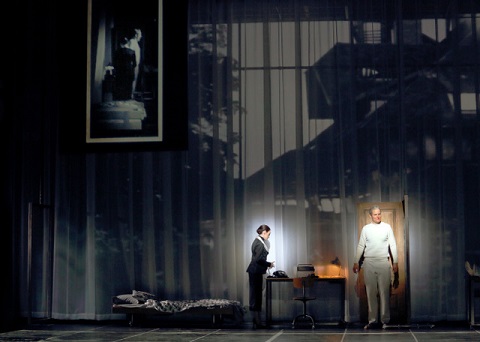 Jennifer France (The Princess) and Nicholas Lester (Orphée). Photo credit: Catherine Ashmore.
Jennifer France (The Princess) and Nicholas Lester (Orphée). Photo credit: Catherine Ashmore.
Netia Jones - in her role as costume designer - has as far as possible made the distinction between the living and dead, the underworld and the world on the Parisian streets, completely authentic. Café society reflects the buoyancy in Glass’s bright scoring; but in the tribunal scene there is every suggestion she is mirroring the complexity of guilt and collaboration which is so affecting in Cocteau’s visionary cinematography. The detail is very finely attuned to what we hear in the score - something we rarely appreciate in opera.
The casting and singing in this production is first rate. It has to be
said that the very size of this theatre doesn’t always make it easy to
appreciate how well artists fit the roles they are singing - and this was
partly the case here. Cocteau does complicate the story - so we get the
introduction of a new character, Heurtebise, who has fallen in love with
Eurydice. The resolution in the opera is that the Princess and Heurtebise
sacrifice their love to send Orphée and Eurydice back to the living on the
condition that they never again look at each other. There is unquestionably
some ambiguity in how this is played out - where do the dynamics of love
lie, and if there are love interests where does the power rest?
The dominant characters in both the Cocteau film and Jones’s opera are clearly the Princess and Heurtebise, at least in so far as the erotic dimension is drawn. It was unequivocally the case that what we got here was an Orphée and Eurydice who embraced their urbanity. Cocteau’s film almost languished in the beauty of his Orphée, Jean Marais, and the sheer charisma of his Princess, Maria Casarès. In Jones’s production one sometimes felt that it was the sultry beauty of Anthony Gregory’s Cégeste, the young up-and-coming drunken poet soon to be struck down by a motorcycle.
Jennifer France’s Princess manages to be enigmatic and imperious, embracing everything the dour Eurydice is not. There is an elegance to France’s Princess of Death, a rhythmic power to her characterisation of the role which is faultless. It isn’t just the crystal-like purity, the diamond-cut precision of her singing which is so striking but the way she acts which also gives this assumption such presence. Standing centre stage, swathed in black, she can sometimes seem larger than life; walking in the shadow scene there is a rhythm to her steps which moves in complete harmony with the music. She seems a source of mystery, no more so than when she disappears through the mirrors and fades into the darkness. The voice is tenebrous, yet completely resolute. There is a haunting, but formidable projection to what she sings. And yet she is fundamentally human, capable of seeming completely tragic as she resolves to forgo her own love.
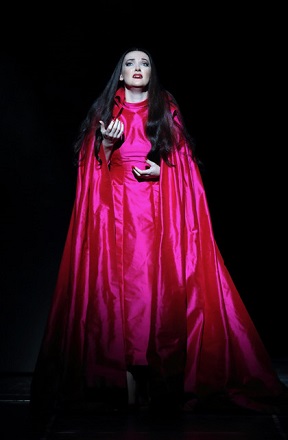 Jennifer France (The Princess). Photo credit: Catherine Ashmore.
Jennifer France (The Princess). Photo credit: Catherine Ashmore.
Nicholas Lester’s Orphée manages to stride between the banality of his existence with Eurydice and the underworld where his love for the Princess is never quite resolved. It never quite feels a dominant performance in this production, however, perhaps reflecting the duality of his underachievement and the enigma of his desires. The sense that this Orphée is just an ordinary young man - almost forgettable - never ceases to be one of the fissures in this production. Lester often appears at his best besides his Eurydice, Sarah Tynan, where both seem to covet the essence of their fate. But one also perhaps feels Lester’s poet is not one who is in love with mortality; that is for the anti-hero Cégeste whose fate is for death to embrace the poet. And if Cocteau has us gaze on his Orphée, Jones almost avoids this. As finely sung as it was, it felt to me a performance which lacked potency - but perhaps this was entirely the point.
Nicky Spence’s Heurtebise also travels between the living and the dead, but what Orphée lacks in emotional power the young chauffeur, like the Princess, is driven by desire. Attracted to the urbane Eurydice he too must sacrifice his love, but Spence was hugely affecting. I’ve sometimes felt disinclined to warm to the character, but Spence’s performance of him rather changed this. He made him vulnerable, the suggestion that his love for Eurydice was doomed and tragic. He sang magnificently. Sarah Tynan’s Eurydice manged to walk the thin line between being simple and sounding anything but. The voice never lacked colour or tonal beauty, the bourgeois print of her dress all that was needed to make her seem simply ordinary. Anthony Gregory’s Cégeste sang with such poetic diction in mind one often related to his character more than one did with Orphée. I’m not sure if it was intended or not, but the near reversal of the Orphée and Cégeste characters in this production had Gregory’s poet sounding more intense and anguished, his journey through the underworld among the recent dead, and his typing of radio messages, almost overshadowing those of Orphée.
If Philip Glass’s score for this opera lacks some of the richness we hear in an opera like Akhenaten, its can sometimes appear closer to some of the composer’s film music. There is a clear debt to Leonard Bernstein is some of the jazz one hears; but the precision of the instrumentation, the clarity of individual textures such as a flute or trumpet, the use of percussion, and the detail uncovered owes something to Glass’s early training in France under Boulanger. It’s no coincidence that Nadia Boulanger was one of the undead walking through the underworld in Jones’s production. Geoffrey Paterson, making his ENO debut, was fastidious in uncovering the layers in the score and the music was conducted at a pace which never impedes the drama of the work. But this is, I think, not a Glass opera which suffers from tempo issues as some of his works are prone to do. The ENO orchestra were, as usual with this composer, superb.
This is a production which works as opera, despite its heavy homage to the film on which it is based. The tendency in the past for directors to use the medium of cinema in opera staging’s has often felt overly interventionist, or has interfered with what we are seeing. Netia Jones has been able to strike a balance between the two which makes for a compelling experience.
Marc Bridle
Orphée - Nicholas Lester, Eurydice - Sarah Tynan, Princess - Jennifer France, Heurtebise - Nicky Spence, Cégeste - Anthony Gregory, Judge/Commissaire - Clive Bailey, Poet - Simon - Shibamu, Aglaonice - Rachael Lloyd, Reporter - William Morgan; Director/Costume design/Video design - Netia Jones, Conductor - Geoffrey Paterson, Set design - Lizzie Clachan, Lighting - Lucy Carter, Choroegraphy - Danielle Agami, Orchestra of English National Opera.
English National Opera, London Coliseum; Friday 15th November 2019.
image=http://www.operatoday.com/Glass%20Orphee%20title.jpg image_description= product=yes product_title=Philip Glass: Orphée - English National Opera product_by=A review by Marc Bridle product_id=Above: ENO: OrphéePhoto credit: Catherine Ashmore
November 17, 2019
Rapt audience at Dutch National Opera’s riveting Walküre
Indeed, director Pierre Audi’s production, the only one from his 1998 Ring cycle which has not been demolished, is still worth seeing or revisiting. But the publicity copy could just as easily have read “Don’t miss the first chance ever” to see Eva-Maria Westbroek sing Sieglinde on the operatic stage in her native country. Because, as she proved yet again, Westbroek is an ideal Sieglinde. The unique metal of her instrument fits the role like a glove and she portrays the downtrodden but plucky woman insightfully and with deep compassion. Her luminously intense performance was the kind that lingers in one’s memory. But the same applies to this Walküre as a whole. There was barely a cough or a wiggle as the rapt audience took it all in.
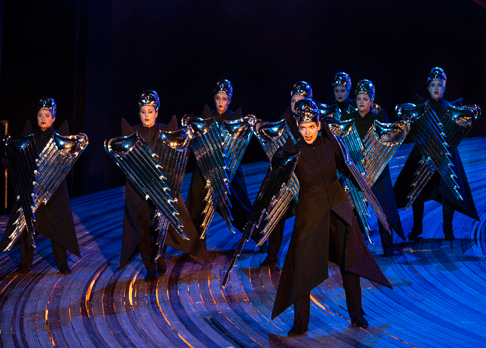
One of the strengths of this production is that, although the singers move across massive, nonspecific spaces, with the orchestra in full view, which should have an alienating effect, they always feel physically and psychologically within reach. George Tsypin’s gigantic set, which curls around the orchestra seated onstage, covers the pit and spills into the auditorium. It creates an almost conspiratorial intimacy between the singers and their public, and, with the musicians behind them, they never have to force to override the orchestra. At lofty junctures, such as Siegmund’s “Wälse!” cries and Brünnhilde’s annunciation of his death, Audi gives them heroic stature by placing them high on a rusty bridge, a construction jutting out into the hall that also serves as the ash tree growing through Hunding’s dwelling. At dramatic high points, dazzling lighting and fire effects transform the stage into an elemental battleground.
The set is not easy on the singers who have to walk up and down its steep gradient. Neither are the late Eiko Ishioka’s costumes – stiff, multilayered creations that are bona fide works of art. Alluding to several eras while avoiding the particular, they seem to be resistant to aging. The overtly aggressive Hunding, sung by orotund bass Stephen Milling, looks like a science-fictional samurai. His suffering wife Sieglinde is laced up in Medieval stays and her twin brother and lover Siegmund wears Bronze-Age tatters. The goddess Fricka, an imperiously irate Okka von der Damerau in splendid voice, uses twin ram-headed walking sticks in lieu of a ram-drawn chariot. And the Valkyries have wings that gleam like Harley-Davidsen engines. Their famous ride, as finely sung as it was choreographed, revealed another acoustic plus of the set – the whole spectrum of war goddess voices, from high to low, was distinctly audible.
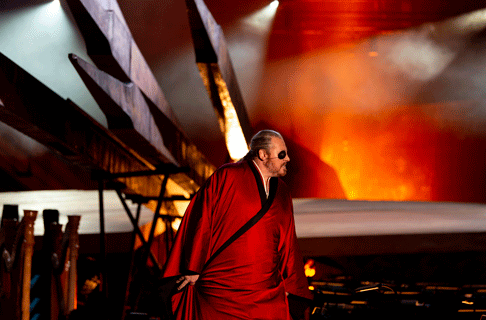
The cast carried the heavy costumes with aplomb while delivering inspired performances. Tenor Michael König was a chiefly lyrical Siegmund, but with the required heroic heft. Although not the most penetrating of actors, he sang beautifully and tirelessly. Bass-baritone Iain Paterson, a master in shading text and measuring out emotion, was completely engrossing as a tyrannical Wotan. Audi’s top god in crisis is unable to keep his violent streak under control. During the clash with his wife Fricka he is disingenuous at first. Then, when he realises he is losing the argument, he makes a clumsy attempt at marital seduction. He is so emotionally crippled that he can only touch his errant favourite daughter Brünnhilde tenderly after she falls asleep. Paterson was gripping to the end, his voice quivering with emotion during Wotan’s farewell to Brünnhilde, a new role for soprano Martina Serafin. It is fair to say that her “Hojotoho!” battlecry was not the most focused, but a few stubborn top notes do not matter in such a vibrant and vocally appealing role debut. Serafin’s Valkyrie was warm of voice and temperament, a Brünnhilde to fall in love with. Next year she will sing the role at the Paris Opera in both Die Walküre and Siegfried.
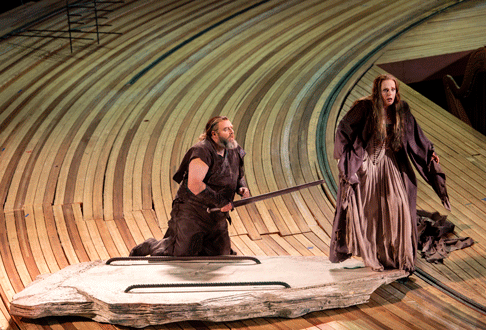
Orchestrally, this was yet another riveting Wagner performance under DNO chief conductor Marc Albrecht. Amsterdam is now familiar with his supercharged, skilfully steered crescendos, and he did not disappoint when storms raged, villains gave chase and swords and spears clashed. Plying a darkish palette, the Netherlands Philharmonic burst through these passages with explosive élan, the brass bold, at times rough-edged, the strings metallized. In quieter moods, Albrecht took risks with broad tempi, sometimes paring down the sound to a mere whisper. The pay-off was a pliant performance with a steadfast sense of direction. Even when Siegmund and Sieglinde were falling in love, the music smouldered purposefully rather than flowering poetically. No wonder the audience listened with bated breath. Die Walküre runs until the 8th of December and is sold out, but same-day tickets could become available. If Siegmund’s ceaseless courage against overwhelming odds teaches us anything, it’s never say die.
Jenny Camilleri
Richard Wagner: Die Walküre
Martina Serafin, Brünnhilde; Iain Paterson, Wotan; Eva-Maria Westbroek, Sieglinde; Michael König, Siegmund; Okka von der Damerau, Fricka; Stephen Milling, Hunding; Dorothea Herbert, Gerhilde; An de Ridder, Ortlinde; Kai Rüütel, Waltraute; Julia Faylenbogen, Schwertleite; Christiane Kohl, Helmwige; Bettina Ranch, Siegrune; Eva Kroon, Grimgerde; Iris van Wijnen, Rossweisse. Pierre Audi, Director; George Tsypin, Set Designer; Eiko Ishioka, Costume Designer; Robby Duiveman, Costume Designer; Wolfgang Göbbel, Lighting Designer; Cor van den Brink, Lighting Designer; Maarten van der Put, Video. Marc Albrecht, Conductor. Netherlands Philharmonic Orchestra. Seen at Dutch National Opera & Ballet, Amsterdam, on Saturday, the 16th of November, 2019.
image=http://www.operatoday.com/Die-Walkure---De-Nationale-Opera-%C2%A9-Ruth-Walz-0002.png
image_description=Photo by Ruth Walz © De Nationale Opera
product=yes
product_title=Rapt audience at Dutch National Opera’s riveting Walküre
product_by=A review by Jenny Camilleri
product_id=All photos by Ruth Walz © De Nationale Opera
Christmas at St George’s Windsor
The Choir of St George’s Chapel comprises twelve lay clerks, who live within Windsor Castle, and twenty choristers drawn from St. George’s School nearby. St George’s is a close-knit, residential community, providing services at daily office throughout the year: effectively the Queen’s own chapel and choir.
This recording takes us through three important seasons in the liturgical calendar – Advent, Christmas and Epiphany. Each section is planned in a sequence connecting the past to the present. William Byrd is represented three times - Vigilate for Advent, Puer natus est nobis for Christmas and Ecce Avenit for Epiphany, serving as a pivot between the modern Church of England, the Reformation and the church before that. The melody of Creator of the Stars and Night used in the Vespers on the four Sundays in Advent, dates from the seventh century, heard here with a text from Victorian times. The cantor is Simon Whiteley. The polyphony of Byrd’s Vigilate rings out beautifully in this Chapel, a masterpiece of Gothic architecture. Orlando Gibbons’ This is the record of St John, from the same period, connects to the new Anglican tradition. Both are complemented by Joseph Rheinberger’s “Rorate caeli” from Neun Advent-Motteten op 176 (1893) for four-part chorus. Michael Finnissy’s Telling (2008) sets an anonymous 16th century text. “Man stands in doubt, but seeks about, where they mayest him see”. Finnissy comments on the final chord of the refrain, on its “mystery, ambiguity and even irrationality”. After all, a miracle has happened beyond normal understanding. “Must carols be fluffy and sentimental?”, he asks.
No such qualms in the jolliness of Arvo Pärt’s Bogoróditse Djévo, from 1990 but already a Christmas classic. In an acknowledgement of other threads of the British choral tradition, A Tender Shoot by Otto Goldschmidt who founded the Bach Choir in 1875. If it sounds familiar, it’s because it’s a variation of the hymn to the Virgin Mary, Es ist ein Ros’ entrsprungen in English translation. John Gardner’s Tomorrow shall be my dancing day (1966) is another modern classic, where the organ, usually solemn, does a jerky “dance”.
Christmas here begins with Puer natus est nobis, twice, first as plainsong (Ben Alden, cantor), then in William Byrd’s version, from his Gradualia Book 2, (before 1607), Alden being joined by two altos and the choir, the parts forming a tracery as elaborate and beautifully structured as the ceiling above the choir stalls in St George’s Chapel. “On Christmas night, all Christians Sing”, is heard here based on the song collected by Ralph Vaughan Williams in May, 1904, near Horsham, hence the title The Sussex Carol. The text was first published in the 17th century but its origins may go back even further. Here it is heard in an arrangement by Philip Ledger from 1986, where the sound of pealing bells is evoked in the voice parts and organ. “Minuit, chrétiens, c’est l’heure solennelle”, Adolphe Adam’s Cantique de Noël is here heard in the original, Nicholas Madden singing in fairly idiomatic French. This isn’t carol so much as art song, given that Adam wrote grand opera (Le postillon de Lonjumeau), audiences of the time expecting performance standards equal to what they might hear in the opera house. Madden’s voice rings clearly and carries well, supported by the organ.
More bells in Mykola Leontovich’s The Carol of the Bells, an arrangement of the Ukrainian folksong Schedryck, heard here in English translation. Another Philip Ledger arrangement of a traditional carol, I saw Three Ships is followed by an arrangement by David Briggs of Away in the Manger. “I wrapped the original melody up in a post-impressionist harmonic language, saturated in garlic and one or two other exotic, succulent herbs!”. It is a delight, Briggs’ background as an organist spicing up the organ part so it glows with rich warmth. In contrast, the sparkling voices of the young choristers of St George’s enliven The Seven Joys of Mary arranged by William Whitehead.
Just as the introit to Christmas in this collection began with plainsong and Byrd, Epiphany is marked by Ecce Avenit, first with cantor Ben Alden, then with the full blown polyphony of William Byrd. West Gallery music, usually simple metrical psalm, originated in smaller parishes in Georgian times. The term “West Gallery” refers to the practice of placing choirs in a gallery on the west side of the chapel, facing the altar but behind the congregation. Their relative informality fell out of favour after the rise in popularity of organs and more organized religious practice in the 19th century. In Under the Greenwood Tree, Thomas Hardy describes this social change in rural Dorset. West Gallery hymnal would have been even more remote from the perspective of high Victorian Windsor, so it’s good to hear how the Choir of St George’s Chapel enjoy singing A Gallery Carol, from Dorset, in an arrangement by Reginald Jacques. The background to Bethlehem Down is even more irreverent. Neither Peter Warlock (Philip Heseltine) nor Bruce Blunt, who wrote the text, were religious. They wrote the hymn for a newspaper competition to raise money so they could indulge in alcohol. Nonetheless, the hymn was an instant hit, and remains a favourite to this day. God moves in mysterious ways. This most rewarding collection concludes with an exuberant flourish. Nowell Sing We was commissioned for the 2014 Festival of Nine Lessons and Carols in York Minster. The composer is Matthew Martin (b. 1976) Director of Music at Keble College, Oxford. It’s a heady mix blending Latin and English texts, in a spicy cocktail of sound, the organ wild and free, before a sudden, conventional coda.
Anne Ozorio
image=http://www.operatoday.com/034571282817.png image_description=Christmas at St. George's, Windsor product=yes product_title=Christmas at St George’s Windsor: A sequence of music for Advent, Christmas & Epiphany product_by=St George’s Chapel Choir Windsor, James Vivian (conductor), Luke Bond (organ) product_id=Hyperion CDA68281 [CD] price=$12.00 product_url=https://amzn.to/2pqQv3DNovember 16, 2019
Sarah Wegener sings Strauss and Jurowski’s shattering Mahler
There are, it’s probably true to say, very few conductors who, as Karl Böhm once said, dare to conduct the prelude to Tristan und Isolde as Wagner wrote it. Böhm was specifically referring to Leonard Bernstein, though he never bothered in any of his performances to take the Bernstein approach himself. Vladimir Jurowski doesn’t either - though, in parts, his performance sometimes felt even more oddly phrased. Why observe the first bar rest, but substantially shorten the second, for example? But it was possible in Jurowski’s performance to ignore the shortcomings in some of his more creative moments (the full-beam dash into the climax, for one) and focus on the searing playing of the London Philharmonic Orchestra. You heard it first on the ascent of the cellos, and that astonishing sigh - which here just opened out with breathtaking sadness and pain. The phrasing of the woodwind, and an oboe which burned like incense and then wilted into silence. This is music that rides a wave and it can sometimes give the impression of being uncontrolled. Jurowski - like so many conductors - sees rapture but little else. What I missed here was the struggle, the exhaustion, the profound psychological darkness that is in this music as the climax capitulates into unsettled calmness (I have never forgotten Sir Colin Davis conducting it just this way). Jurowski’s way with the prelude might have worked better had we got the Liebestod - as it was, the concert ending seemed unsatisfactory.
The pairing in the first half of Wagner with seven Richard Strauss songs was an entirely natural fit. Sarah Wegener, a late replacement for Diana Damrau, who had clearly struggled with Strauss in New York a few days earlier, didn’t always feel entirely comfortable in some of the songs - in a program which remained unchanged (except in order). Wegener’s voice is a touch darker than Damrau’s, but it is also less quicksilver, less inclined to favour an agile approach and sometimes struggles with the precision of her breath control. On the other hand, there is a purity of expressiveness, a willingness to read deeply into the textual meaning of these songs which is memorable.
Jurowski applied some dangerously slow tempos to a few of the songs on this program. Whether Damrau would have tolerated the extremely broad playing in ‘Wiegenlied’ or ‘Morgen’ is debatable; in fact, these were two songs where Wegener excelled simply because she was able to penetrate the text with some startling originality and beautiful phrasing. ‘Morgen’, particularly, in which the voice seems to just appear from a void, was striking for its exceptional richness of tone, but yet it was as fragile and delicate as the most eggshell-like of porcelain. Here the widening of the tempo seemed ideal simply because the song was fragrant with the endlessness it tries to achieve. Wegener didn’t lack pathos either; it felt like a perfect miniature of Straussian opulence.
‘Wiegenlied’, too, lived a little dangerously but Wegener was able to remind us that this is a song about fatherhood and the spirituality of a mother and child. If the voice strained a little above the stave this was a sign less of her ability to hit the note and more to simply hold its length. ‘Das Rosenband’, the first in this cycle on the program, was a little uneasy in approach - almost sensuous as a reading of the text, with impeccable phrasing, until that glorious ascent into heavenly ‘Paradise’ which never quite soared as it should.
‘Ständchen’ is rather like a painting, almost Debussyian in its imagery. Wegener clearly knows how to bring the text to life, how to make that brook babble, the trees bend, the mystery of moonlight cast a shadow and the flowers smell of their fragrance. If there was a problem, it was less her fault and more to do with Jurowski’s unwillingness to give much exigency to the rhythm - these were orchestral brushstrokes that sometimes felt thickly rendered.
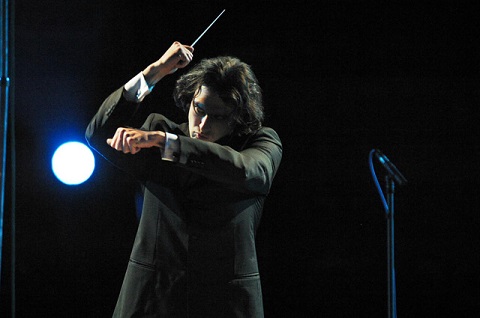 Vladimir Jurowski. Photo credit: Roman Gontcharov.
Vladimir Jurowski. Photo credit: Roman Gontcharov.
The original program had ‘Zueignung’ placed in the middle - an odd choice. In the end, this was the closing song and probably proved the most controversial. Jurowski’s tempo was extraordinarily slow. This was a performance less about Wegener and more about the orchestra, the intimacy suffocated at the expense of some quite outrageous sonorities concentrated elsewhere. Impassioned and ardent this song might be, but Wegener was constrained by the amplitude of the orchestra - her final ‘Dank’ so clipped it simply proved too taxing for her to sustain.
If there is one word to describe Jurowski’s performance of Mahler’s Fifth Symphony it is innovative. This was one of those Fifths which proved something of a revelation, controversial though it might have been. It felt particularly Russian in almost every way - grim, intentionally menacing, turbulent, brooding, desolate and teetering towards the manic. Often it was uncomfortable to hear - where one expected it sound Viennese it often found itself in the grip of wider East European revolution, where there should have been light there was darkness. There had been an opening Funeral March which looked back towards Wagner, and where one usually blithely gets trumpet solos which sound crystalline and polished here they fell like an executioners axe. The stormy second movement progressed less with the radiance of ecstasy where it should and more like a requiem for the dead. When collapse arrived it was like the shattering of stone until what you were left with was the shell of a totally destroyed edifice in a landscape that seemed torn apart. Even the Adagietto seemed restless, less a sigh or love song, and more an uneasy truce between emotions which seemed incapable of complete expression. There was little joy in the first section of the Finale - it felt stripped bare, but what a climax! At times, this was a performance which embraced the darkness of Wagner but looked forward to the bleakness of Shostakovich.
None of this would have been possible without the exceptional playing of the London Philharmonic. The strings were like thick black tar, the brass didn’t shimmer but blasted through the orchestra like a battalion in combat, flutes and clarinets screamed through their pages as if ripping the notes off them. Jurowski quite simply gave one of the most manic and shattering performances of a work which rarely gets heard this way.
Marc Bridle
Sarah Wegener (soprano), Vladimir Jurowski (conductor), London Philharmonic Orchestra.
Royal Festival Hall, London; Wednesday 13th November 2019.
image=http://www.operatoday.com/Sarah%20Wegener.jpg image_description= product=yes product_title=Mahler, Strauss and Wagner: LPO conducted by Vladimir Jurowski product_by=A review by Marc Bridle product_id=Above: Sarah WegenerPhoto credit: Marvin Stellman
November 15, 2019
Manon Lescaut in San Francisco
If for nothing else her relative youth becomes the Abbe Prévost’s teenage heroine, plus this young soprano is in her vocal prime, may it endure for years to come.
The driving force of this splendid (in part) evening was conductor Nicola Luisotti who attacked an excited piazza in Amiens with such energy that I feared for the tenor of Puccini’s delicate (well maybe not-so-delicate) love scenes to come. But the maestro made the moment Manon falls in love with des Grieux so delicate that it almost seemed real, the subtly discovered emotions flowing in beautifully colored orchestral chords. The maestro, with Puccini, let us know that love itself was to be the unquestioned muse of the evening.
The second act resolutely explored the intimacy of Manon’s feelings, the maestro in total sympathy with Mme. Haroutounian’s exquisitely intoned “in quelle trine morbide,” the soprano locked totally within herself. And then came the impassioned duet with des Grieux “Tu, tu, amore, tu, ah! mio immenso amore,” the maestro riding the emotional crests of love with orchestral harmonies and phrasing of sweetly charged color. And finally in the last act Manon’s wrenching “Sola, perduta, abbandonata” sung, initially supine, the soprano lost within herself, the maestro offering only the woodwind desolation of love lost in the Louisiana desert.
The evening at its best was this elegant duet of the maestro with the soprano.
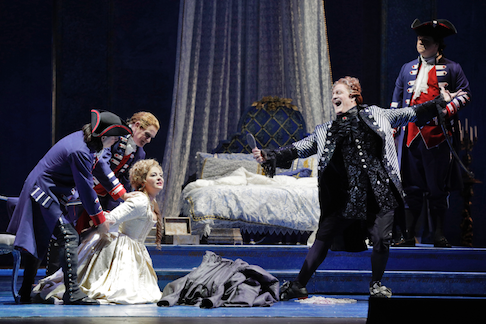 Geronte de Revoir (Philip Skinner) relishes the arrest of Manon (Lianna Haroutounian)
Geronte de Revoir (Philip Skinner) relishes the arrest of Manon (Lianna Haroutounian)
Lianna Haroutounian is one of the rare artists who communicates every word she sings. She possesses a very beautiful, clear, youthful voice of full lyric strength. Coupling voice with small physical stature and extraordinary communicative powers has made Butterfly la Haroutounian’s rôle fétiche, as seen on many of the world’s major stages. It is likely her Manon will now find very great appreciation as well.
The role of the Chevalier des Grieux was delegated to tenor Brian Jagde who has already sung 13 other roles at San Francisco Opera. Mr. Jagde is a fine singer and enjoys a deservedly successful career. There are however, and fortunately for Puccini, many other tenors in the world who might actually have discovered the poetry of this Romantic hero’s hopeless love for a sympathetic if neurotically narcissistic heroine. As it was Mr. Jagde remained first and foremost a tenor and never a lover. If at first we were impressed with the glories of his vocal maturity, they wore thin by the time we reached Louisiana where there was a hint that maybe something more might occur, but that was very late in the evening.
Baritone Anthony Clark Evans made Manon’s brother called simply Lescaut everything he needed to be — first of all of fine voice and then of suave presence. Mr. Evans found as well the avidity of provincial nobility and a touching fraternal sympathy for his sister that hugely complemented the Haroutounian performance.
The myriad of small roles were relegated to current Adler Fellows (the “Adlers” are the participants in San Francisco Opera’s operatic finishing school) who were cool performers (“cool” in its highly complimentary use meaning stylishly by the book). Of note was the Edmondo of tenor Christopher Oglesby. Four members of the San Francisco Opera Chorus created an impressive madrigal!
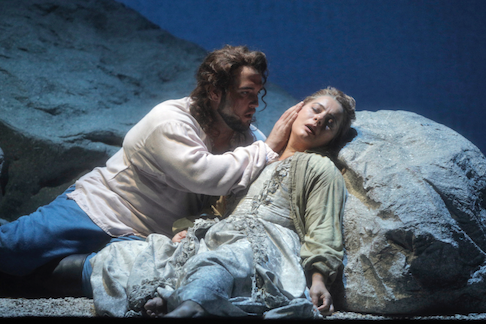 Manon and des Grieux in Lousiana
Manon and des Grieux in Lousiana
Conductor Luisotti revealed the beauties of love that we learned lay hidden within Puccini’s score, and he discovered an elegance of subtle emotions that is unusual in Manon Lescaut readings. More often conductors and productions focus on the verismo in Manon Lescaut — its brutalities. Each of its four brutal episodes (acts) do in fact resolve in an enormous emotional rush. In the Luisotti Manon Lescaut there was instead the overwhelming revelation of love. In the end there was even the sense that one might shed a tear.
What the 2005 Olivier Tambose production from the Lyric Opera of Chicago had to do with any of this is a mystery. It was in its own world and I'm not sure what world that is. In the first act there was precise detail in the setting but often highly stylized, choreographed and symmetrical staging, like operetta. This in contrast to a basic naturalism of blocking in the second act (except when Lescaut leaped foolishly onto Manon’s sumptuous bed to praise her beauty). Mr. Tambosi did offer a gratuitous dose of realism in the third act with the shocking brutality of the flinging to the ground and branding of the women prisoners as they were to shipped off to Louisiana.
There was the inexplicable casting of bass Philip Skinner as Geronte de Revoir (Manon’s rich lover) that added a peculiar, out of place, rough caricature in the otherwise careful Second Empire elegance of the setting and costuming. Mr. Skinner is an excellent character singer and a wonderful San Francisco Opera resource when appropriately cast.
Conductor Nicola Luisotti was the San Francisco Opera music director from 2009 to 2018. He elicited a superb performance from the orchestra he honed into one of the world’s finest. It could be a revelation if this maestro were ever given a production that approaches the conceptual level he brings musically to the operas he conducts.
Michael Milenski
Cast and production information:
Manon Lescaut: Lianna Haroutounian; Chevalier des Grieux: Brian Jagde; Lescaut: Anthony Clark Evans; Geronte: Philip Skinner; Edmondo: Christopher Oglesby; Singer: Ashley Dixon; Dancing Master/Lamplighter: Zhengyi Bai; Innkeeper/Naval Captain: SeokJong Baek; Sergeant of Archers: Christian Pursell; Madrigal Singers: Angela Eden Moser, Jesslyn Thomas, Laurel Cameron Porter, Sally Mouzon. San Francisco Opera Chorus and Orchestra. Conductor: Nicola Luisotti; Stage Director: Olivier Tambosi; Production Designer: Frank Philipp Schlössmann; Lighting Designer: Duane Schuler; Choreographer: Lawrence Pech. War Memorial Opera House, San Francisco, November 13, 2019.
image=http://www.operatoday.com/ManonLescaut_SF1.png
image_description=Photo by Cory Weaver courtesy of the San Francisco Opera.
product=yes
product_title=Manon Lescaut at the San Francisco Opera
product_by=A review by Michael Milenski
product_id=Above: Lianna Haroutounian as Manon, Zhengyi Bai as the Dancing Master
All photos copyright Cory Weaver, courtesy of San Francisco Opera
November 14, 2019
A lukewarm performance of Berlioz’s Roméo et Juliette from the LSO and Tilson Thomas
If, over the course of this symphonie dramatique its cumulative impact didn’t quite bring that special thrill factor, there was much to appreciate in the extraordinary daring of the composer’s conception. There’s the originality of its orchestration (with much favour given to the cello section), the striking novelty of its choral recitative and the odd, uneven distribution of the vocal forces where two of the three soloists (who never sing together) only participate in Part One. For some, this might be considered a wilful lack of consideration for his singers, and not least there’s the reduction of Shakespeare’s play to scattered scenes - barely a narrative in any conventional sense. That the doomed lovers are musically evoked from within the orchestra is a masterstroke.
This performance did not have the most convincing start and subsequently the ensuing reimagining of the warring Montagues and Capulets felt a little earthbound, though the intervention of the Prince brought some majestic brass tone. A polished semi-chorus of 12 singers from the Guildhall School of Music and Drama brought wonderful transparency to the Prologue’s text, closely followed by a poised Alice Coote - positioned between two harps and second violins - for her singular and memorable contribution. Ideally cast for this cameo role, her fine delivery and creamy tone enriched the folk-like melody and perfectly caught the pains of young love amid soft summer breezes, the whole enlivened by shapely phrasing from a reduced cello section.
American tenor Nicholas Phan made a similarly brief appearance for his Queen Mab narration, sung with jewel-like tone and much scintillation from some nimble woodwind playing. Romeo’s solitary thoughts were nicely captured by the LSO strings and Olivier Stankiewicz’s expressive oboe also caught the ear in the Larghetto espressivo. The ensuing ball and the arrival of both Romeo’s and Juliet’s themes (one noble, the other playful) drew a riot of colour, brass and violins keenly responsive to Tilson Thomas’s animation. Returning party revellers (the gentlemen of the LSO chorus) sang deftly, if not quite conveying an image of cavorting youths saying their farewells. It’s a tiny quibble, and of no great import since the LSO players have this music in their bones (transfused into their collective bloodstream over the years via Colin Davis) and the Love Scene glowed with exquisite tenderness, while the secondary reference to Queen Mab was delightfully buoyant.
From this fantasy the action moves to the presumption of Juliet’s death (thanks to a sleeping potion) and the surrounding lament. If the Funeral Procession didn’t quite mesmerise, the ensuing tragedy was vividly fashioned, a haunting clarinet for Juliet’s awakening and an explosive orchestral response as both lovers take their lives. French bass Nicolas Courjal made the most of his dramatic role, initially woolly-toned as a guilt-ridden Friar Lawrence, later commanding in his assertion that Verona will be ‘great in history’. The London Symphony Chorus (as Montagues and Capulets) responded to his pleas for reconciliation with strength of tone and characterful intensity.
Overall, this was a performance that illuminated the richness of Berlioz’s imagination, if not his dramatic instincts.
David Truslove
Alice Coote (mezzo-soprano), Nicholas Phan (tenor), Nicolas Courjal (bass) Michael Tilson Thomas (conductor), Guildhall Singers, London Symphony Chorus, London Symphony Orchestra.
Barbican Hall, London; Sunday 10th November 2019.
image=http://www.operatoday.com/Michael%20Tilson%20Thomas%20Brandon%20Patoc.jpg image_description= product=yes product_title=Berlioz: Roméo et Juliette - Michael Tilson Thomas conducts the LSO at the Barbican Hall product_by=A review by David Truslove product_id=Above: Michael Tilson ThomasPhoto credit: Brandon Patoc
November 12, 2019
Mahler’s Third Symphony launches Prague Symphony Orchestra's UK tour
A gruelling travel itinerary with five performances of the longest symphony in the standard repertoire doesn’t necessarily make a comfortable ride in terms of logistics, especially when two choirs (women’s and children’s voices) need to be locally sourced for several performances. Little wonder on opening night there was a sense of an orchestra holding back, keeping its collective powder dry. Pacing is everything on an orchestral tour, and a similar sense of keeping something in reserve might also be applied to the Finnish conductor Pietari Inkinen whose efficient and understated direction of this gargantuan work (played without an interval and coming in at about one hour and forty minutes) drew some fine, if uneven, playing from his Czech forces.
With its extraordinary blend of the sublime and the commonplace, Mahler’s Third Symphony - written in an unassuming little hut in the middle of an Alpine field - inhabits a sweeping grandeur that inflates the genre well beyond convention. Its mix of garish marches, rustic folk tunes and hymn-like apotheosis bring together a celebration of the natural world along with high-minded ideals from Nietzsche, all compressed into an ambitious design that confounded William Walton who declared, ‘It’s all very well, but you can’t call that a symphony’. It’s a work fraught with challenges, not least the need to integrate its earthy and exalted manner into a satisfying and coherent whole. In many respects Inkinen met this challenge head on, creating a handsome, well-judged account that grew in stature and emotional power, By the end I was won over, largely by his impressive control over its vast structure. This was no flawless account by any means, but there was sufficient certainty of direction and accuracy of playing to engineer no small achievement.
The striding opening theme was cleanly despatched by eight horns and heralded a thirty-minute plus span of accumulating momentum and drama. The Anvil’s bright acoustic allowed plenty of detail to register, and for the most part the orchestra produced a well-balanced tone, if a tad lightweight from its eight double basses. Occasionally, there could have been more rhythmic bite, as in the somewhat limp upward scales from the lower strings - marked to be played wild and triple forte. Elsewhere, the solo violin might have been more tender and the solo trombone less effortful. But the playing overall gave full expression to the gravitas and jollity of Mahler’s vision, with plenty of swagger in climaxes where a shrieking piccolo and two timpanists were not afraid to come to the fore.
There was a gentle nod to indulgence in the Minuet, its summer flowers charmingly lit by oboe and pizzicato strings at the start and thence a flowing account in which playful woodwind brought much effervescence to this musical Garden of Eden. If the creatures of the forest (as Mahler once subtitled his third movement) needed a little more definition, there was no escaping the clarity of the post-horn. Despite being hidden away in a corridor, Marek Zvolánek’s trumpet scorched the air with no chance of sounding distant and realising the composer’s evocation of primal innocence.
Ester Pavlů was a poised and rich-toned mezzo-soprano for her ‘Midnight Song’, and as her intonation and sense of involvement developed so the movement gained in intensity. Hopes to hear the mournful rising third from first oboe (marked hinaufziehen - drawn upwards) remained unfulfilled - a shame as it’s a characterful quirk from Mahler. Apart from its suggestive cry of a night bird, its ear-catching glissando is surely endorsed by the composer’s wish that ‘the whole of nature finds a voice’.
Pavlů was joined by the women of the Brighton Festival Chorus and the Tiffin Boys’ Choir who acquitted themselves with conspicuous joy and forthright tone in the ‘angels’ movement - Peter’s journey to heaven. They were easily heard above the clangour of tubular bell and too when softer dynamics demanded, the whole aided and abetted by a no-nonsense tempo. It was the heaven-storming Adagio, ‘ What love tells me’, that found Inkinen in his element. This was a wonderfully translucent reading; noble and of searching inwardness, with solo flute and resplendent brass adding to the rapt serenity and eventual triumph, this last thrillingly captured by unrestrained timpani. If earlier playing had occasionally felt routine this was a superbly redemptive close and left me in no doubt of this conductor’s promising future.
David Truslove
The Anvil, Basingstoke; Thursday 7th November 2019.
image=http://www.operatoday.com/Ester%20Pavlu.jpg image_description= product=yes product_title=Mahler Symphony No.3 - Prague Symphony Orchestra at The Anvil, Basingstoke product_by=A review by David Truslove product_id=Above: Ester PavlůPhoto credit: Josef Rabara
November 10, 2019
From Darkness into Light: Antoine Brumel’s Complete Lamentations of Jeremiah for Good Friday
One can thus imagine the excitement experienced by Musica Secreta’s co-director Laurie Stras, when the discovery of what she describes as ‘seventeen verses, which were found hiding in plain sight in a sixteenth-century manuscript’ revealed Antonine Brumel’s setting of the Lamentations of Jeremiah to be much more monumental, intricate and imposing than previously imagined.
The result - Musica Secreta’s recently released From Darkness Into Light (on the Obsidian label) - is a compelling fusion of scholarship, instinct, creativity and hypothesis. So much depends, in such matters, on circumstance: clues are tantalising but confirmation rare; conviction relies on the heart as much as the head. For example, as Stras points out in an online guide to accompany the recording, we do not even know the date of Brumel’s death for certain: ‘Richard Sherr, the esteemed historian of Roman musical culture in the 1500s, presumed that Brumel died in 1512, based on the circumstances of a letter written in mid-May 1512, from Mantua, that suggests he might have been mortally unwell. And while the Florentine Vincenzo Galilei, writing near the end of the sixteenth century, said that Brumel had been called to Rome by Pope Leo X in 1513, musicologist Daniel Heartz rejected this as muddled thinking on Galilei’s part, based not on Galilei’s knowledge but on his assumptions.’
Brumel’s Lamentations have been known and heard - in performance and recording - in the form of two verses and a refrain, ‘Jersualam, convertere’. Stras has revealed them to be a much more expansive setting in five ‘movements’ spanning 45 minutes - quite unusual, even remarkable, for a work composed c.1480-1520 - which, while having no specific liturgical function, are likely to have been performed during Holy Week.
There is much finely observed and detailed scholarship in evidence in this recording and the materials associated with it. It is noted that there are five refrains, not three; and the verses do not divide in correspondence with the liturgy, so adaptation would be required for liturgical function. But, there is also evidence of creative thinking. Given that ‘[t]he five sections with their refrains do not correspond with any existing musical or liturgical structure, but they do map exactly onto another art form, extremely familiar to the Florentine elite’, there is a suggestion that Senecan tragedy, ‘the literary model for many Elizabethan dramas’, provides a model with its five-act narrative arc: ‘the Exposition, the Beginning of action, the Complication of action, the Reversal of fortune, and the Catastrophe. Each section of Brumel’s Lamentations then becomes an act in a drama, and the refrains take the place of the classical Chorus, concluding each act.’
There is no clear route through such scholarly and theoretical debates, other than to let the music itself speak. From the start of the first ‘Act’ of Brumel’s Lamentations (Heth. Cogitavit Dominus) the mood is confidently declamatory and pressing of pulse, and the intensity grows, the urgency compels, as the Lord’s breaking of the wall of the daughter of Zion threatens dissolution and anarchy. There is an energetic uplift to the ensemble sound at the start of the second Act ( Joth. Sederunt in terra) though this is complemented by some gritty harmonic ‘obstructions’ and a taut dialogue between flowing counterpoint and more ingrained homophony.
The sound is bright but also grainy at times; individual voices fly free though they are anchored by the organ’s unobtrusive but solid foundations. ‘Perfect’ harmonies are repeatedly troubled by ‘problematic’ piquancy - there are some terrific/terrifying false relations! - but the over-riding impression is one of life-relishing forward momentum. There is a wonderful registral expansiveness which tells of the elder daughters of Zion who ‘sit upon the ground and keep silence’ as ashes are thrown upon their heads. ‘[T]he virgins of Jerusalem have girded themselves with sackcloth: the virgins of Juda hang their heads to the ground,’ we are told. The music is unpredictable and vitalised, episodic and striving.
The third Act (Lamed. Matribus suis dixerunt) is riven with restlessness and anxiety, as the wounded, fainting daughters question their mothers, ‘Where is the wheat and the wine?’ The vivacity and optimism of the account of the daughter of Zion, whose grief ‘is great like the sea’, is astonishing, and speaks of an underlying faith of which most of us can, I suspect, scarcely imagine. Act 4 flourishes with assertive forays, ‘Your prophets have seen vain and foolish things for you’, which release the highest voices to reach and soar. At times there is such energy and power in the singing that one feels one’s feet lift from the floor. The sense of individual voices crying out - ‘He has made my flesh and skin old’, ‘He has … surrounded me with gall and travail’, ‘He has set me in dark places, as they that are forever dead’ - is almost overwhelming emotive, as melodic lines assert themselves within a fraught but flowing discourse, and the dissonances coalesce almost painfully.
In the final Act, the individual voices seem to come together in a collective, homophonic expression of despair that the Lord ‘has made my paths crooked’ and ‘has turned aside my ways, and pulled me in pieces’, the organ binding individual voices to a common cause. Even if tense dissonances express pain experienced, there is hope: ‘Jerusalem, return to the Lord your God.’
The historical source of Brumel’s Lamentations that Stras discovered was undecorated and not for display, but its friar-copyist, Fra Antonio Moro, left clues for the modern-day musical detective to interpret. He also left another Florentine manuscript - the Biffoli-Sostegni manuscript - which belonged to two nuns, Suor Agnoleta Biffoli and Suor Clemenzia Sostegni, and which is filled with details and minutiae revealing much about the nuns’ daily lives.
The second half of this disc draws upon that Florentine manuscript, with anonymous works settling alongside those of masters such as Josquin, Antonio Moro and Loyset Compère. A 16th-century Ave maris stella seems somehow to ‘free’ the voices and in the unison episodes there is a wonderful sense of joy and life: the final upwards-reaching cadence is quite extraordinary. Similarly, the organ impels the voices with terrific buoyancy in Moro’s five-part Sancta Maria. Listening, I began to wonder about - and feel a surprising persuasive pull towards - lives and loves, faiths and fidelities in such distant times and places. The repetitive tropes of the brief 16 th-century Jesus autem cum ieiunasset are no less entrancing, though the strong lower voices of the contemporary Multiplicati sunt qui tribulante me, with its succinct final cadence, seem to speak even more assertively of assured devotion.
The freedom and energy of the anonymous 16th-century Verbum caro factum est sweeps up the listener in its glorifying cadence and propels one into the unison affirmation of an anonymous Salve Regina, the harmonic and sonic richness - and episodic confidence - of which seems to defy and deny our 21st-century assumptions and complacencies.
The liner book contains Latin texts and English translations, and explanatory essays are supplemented by more extended online analysis of the historical and musical context. This is a recording that will delight scholars and laymen, theorists and practitioners, alike.
Claire Seymour
Rigoletto past, present and future: a muddled production by Christiane Lutz for Glyndebourne Touring Opera
He was also - according to studies such as Peter Ackroyd's 2014 biography Charlie Chaplin: A Brief Life - a megalomaniac who treated his wives (invariably much younger) and children, callously and carelessly. A sexual predator, Chaplin reportedly estimated that he had slept with 2000 women. In The Charles Chaplin Archives (2015), film historian Paul Duncan details the scandals - and scandalous efforts to avoid them - paternity suits and divorce proceedings which led, in 1945, Senator William Langer to put forward a bill calling for ‘the Attorney General to investigate and determine whether the “alien” Chaplin should be deported because of “his unsavory record of law breaking, of rape, or the debauching of American girls 16 and 17 years of age”’.
So, one asks oneself, why did German director Christiane Lutz (making her Glyndebourne and UK debut) think that Chaplin, whom she describes as “an iconic comedian” with “charisma”, has anything in common with Verdi’s cruel but vulnerable hunch-backed jester, Rigoletto, whose principal aim in life is to protect his daughter, Gilda, from the corruption of contemporary society to which he, as he is self-laceratingly aware, contributes?
Lutz takes the 1930s Hollywood studio system as her setting and starting point. And, this doesn’t seem unreasonable. After all, the casting-couch sexual predator was no less common then than during our #MeToo age, and the Duke as Hollywood mogul wouldn’t be a far-fetched notion - just as the Duke as US President, seen last week in Welsh National Opera’s revival of John Macdonald’s 2002 Rigoletto is a credible notion. Indeed, Richard Carr, Lecturer in History and Politics at Anglia Ruskin University and author of Charlie Chaplin: A Political Biography from Victorian Britain to Modern America (2017), has noted that in February 2012, when co-hosting a dinner to honour Chaplin’s services to the movie industry, Harvey Weinstein remarked that he regarded Chaplin to be “one of my idols, certainly”. ‘At the time, this appeared to be a fairly run of the mill commemoration in Tinseltown, but, in the light of recent revelations about Weinstein, we may now have to view it in a rather different light,’ writes Carr.
However, there’s a chasm between Verdi’s taunting and tormented jester and Chaplin, who is often presented as an arrogant genius who manipulated those around him with no remorse. I seem to have spent much of the past week reflecting on the relationship between the composer’s score and the director’s creative response to it, in the theatre and in different receptive contexts, but while the two WNO productions that I saw in Birmingham, and the previous evening’s winning revival of Robert Carsen’s 2011 production of Handel’s Rinaldo gave much pleasure, even as they raised questions, after sitting through Lutz’s overloaded, often messy and illogical, and sometimes absurd production, I found myself siding with pianist Sir András Schiff who, in 2014, in Neue Zürcher Zeitung , despaired: ‘What is it with directors? Why is it that most directors find it so hard to fade into the background and stand in the shadow of the work? Where did they acquire this addiction for self-expression, pomposity and disrespect? Why there no humility or modesty? Why this panic fear of boredom?’
Things didn’t get off to too bad a start, though. A Chaplin-esque silhouette, visible through a white screen, indulged in some idiomatic gestural vocabulary, before an old man (actor Jofre Caraben van der Meer) in modern dress walked into a circle of light. As the Prelude began its dark dramatic signposting, so the figure stripped off jacket, jumper and trousers and spun around on the floor on his belly, in underpants and vest, obsessively writing the single word “forward”, over and over, as it was simultaneously etched, blotched and obliterated before our eyes on the screen projection. A short grainy clip of a retired actor, looking back with nostalgia and bitterness followed. These were, apparently, two of the three Rigolettos which Lutz leads us to expect: the young man, the older man fighting against his fate, and “an old man regretting that he can’t change the past”: “In a movie you can always cut and re-shoot, but in life of course that’s not possible.”
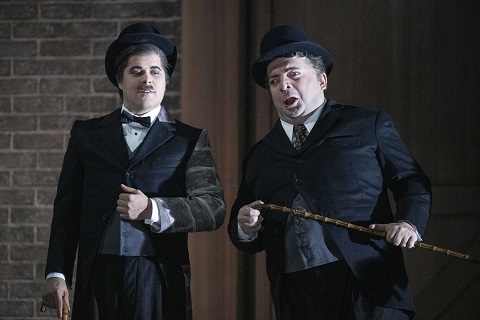 Oleg Budaratskiy (Sparafucile) and Nikoloz Lagvilava (Rigoletto). Photo credit: Richard Hubert Smith.
Oleg Budaratskiy (Sparafucile) and Nikoloz Lagvilava (Rigoletto). Photo credit: Richard Hubert Smith.
Thus, Lutz has laid the prefatory groundwork, and Act 1 opens in the spacious brick ‘warehouse’ designed by Christian Tabakoff, a studio-set in Hollywood’s Golden Age replete with cine-cameras, film techies, extras, PAs, costume racks and scissor-action bamboos chairs emblazoned with the names of the significant players: ‘Duca’, ‘Rigoletto’, ‘Monterone’. An actress, posing against a monochrome backdrop, is harried away by the director-cum-Duke. Rigoletto, a comic lead, waddles about à la Oliver Hardy and indulges in some business with a Chaplin-style walking cane. But, the mood is mild and there’s none of the decadence and viciousness, jealousy and conflict, that one might expect in Verdi’s opening scene. The debauchery is going on behind-the-scenes, it appears, for it’s not long before Monterone - Aubrey Allicock in resounding voice, wearing a plum-coloured suit to match his face purple with anger - appears, alongside his daughter (the afore-mentioned actress), who is carrying her new-born babe.
As Monterone denounces the depraved Duke/director, his daughter (aerialist Farrell Cox) flees up a fly-tower, subsequently to fall in a slow-motion suicide, rolling head-over-heels, her white skirts billowing like an angel’s wings. The shock - or Monterone’s subsequent curse - is clearly a game-changer for Rigoletto: the surtitles tell us that it’s ‘17 years later’, and the babe-in-arms abandoned on the studio floor is now a young woman who is under the impression that Rigoletto is her father. Some unpleasant incestuous relations seem inevitable.
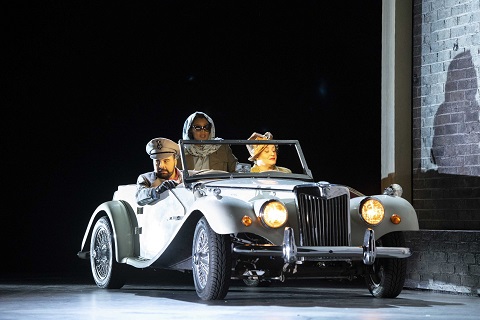 Matteo Lippi (Duke), Vuvu Mpofu (Gilda) and Natalia Brzezińska (Giovanna). Photo credit: Richard Hubert Smith.
Matteo Lippi (Duke), Vuvu Mpofu (Gilda) and Natalia Brzezińska (Giovanna). Photo credit: Richard Hubert Smith.
Rigoletto is clearly not a jobbing actor living in a hovel, so we don’t visit his home. Sparafucile emerges - literally, his suit is half-brick, half-black - from the walls of the cavernous empty studio; his murderous suggestions - subtly delivered by Oleg Budaratskiy, whose villainy vocal and otherwise are of the swift, understated kind - are overheard by the old man whom we saw in the opera’s opening moments (at least now clothed). And, it’s to the studio that Gilda rolls up, driven by a chauffeur in a smart car, with chaperone Giovanna (a rich-toned Natalia Brzezińska, a GTO Chorus member) in tow. As Gilda questions Rigoletto about her mother, we see the Duke bribe the chauffeur and don his livery.
At this point, I began to lose sympathy with Lutz’s concept and execution. Matteo Lippi’s Duke is confident and controlled, vocally and dramatically, but there is no chink of ambiguity that might intimate genuine feelings for Gilda - and, in any case, she’s his daughter! Gilda is initially alarmed by his advances, though she submits, inevitably, to his power and privilege. In the following scene we see a smirking Duke complete his deal with the chauffeur, handing over the readies and returning the latter’s uniform in a corner-seat of Sparafucile’s bar - more Victorian boozer than Hollywood watering-hole. ‘Parmi veder le lagrime’ the Duke may sing, from the comfort of his director’s office, but these are crocodile tears. The falsities of ‘La donna è mobile’ - here, bright, agile and virile - represent his ‘sincerity’.
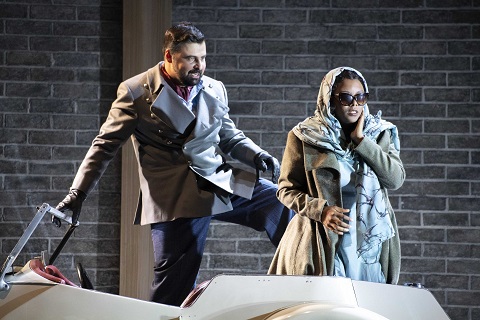 Matteo Lippi (Duke) and Vuvu Mpofu (Gilda). Photo credit: Richard Hubert Smith.
Matteo Lippi (Duke) and Vuvu Mpofu (Gilda). Photo credit: Richard Hubert Smith.
The abduction is similarly unconvincing. For some reason, Gilda runs into the ladies’ lavatories, narrowly avoiding meeting her own ‘father’ on the hostelry doorstep. The assembled film crew talk of running off with Countess Ceprano but there’s no clear sense of ill-will towards Rigoletto - or ‘his mistress’, as in Piave’s libretto. Some Laurel & Hardy-style japes with a ladder ensue, distracting Rigoletto, and Gilda is abducted - all without a jot a theatrical tension.
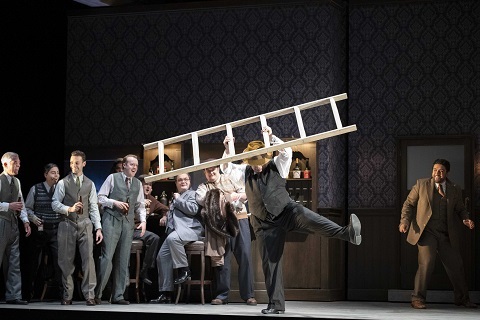 Nikoloz Lagvilava (Rigoletto). Photo credit: Richard Hubert Smith.
Nikoloz Lagvilava (Rigoletto). Photo credit: Richard Hubert Smith.
It doesn’t get much better when Monterone re-appears, to be ‘condemned’ - in what court, for what ‘crime’? - accompanied by the ghost of his ‘fallen angel’, as our aged haunter strokes the floor onto which she fell (seventeen years ago). Fortunately, there’s no directorial concept on earth that can destroy the expressive power of Verdi’s Act 3 Quartet. And, though encumbered with a frightful maid’s costume and soapy mop, Madeleine Shaw’s Maddalena is striking of voice. As the tragedy plays out, our haunter - perched on a bar stool - is joined by a grey-haired Duke: it’s all rather Dickensian, as Time Future visits a Time Present afflicted by the deeds of Time Past. Without revealing Lutz’s concept-closer, let’s just say that the time-travelling visitants have a role in the denouement.
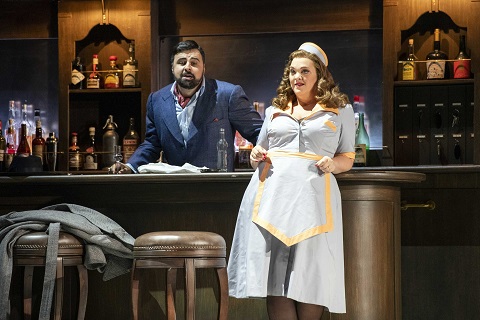 Matteo Lippi (Duke) and Madeleine Shaw (Maddalena). Photo credit: Richard Hubert Smith.
Matteo Lippi (Duke) and Madeleine Shaw (Maddalena). Photo credit: Richard Hubert Smith.
The central duo - who is this case are not father and daughter, thereby sending the whole action spinning into a psychological no-man’s land - do their best, and often that is very good. Vuvu Mpofu is no ingénue, at least vocally - her soprano burns with passionate feeling, even if here it is directed at some pretty dodgy targets - and she gives a very credible dramatic reading in the lamentable circumstances. Nikoloz Lagvilava makes up for some lapses in accuracy and intonation with a vivid commitment and a strong, burnished sound that rings with as much genuine anguish as is possible within this dramatic concept. If at times this Rigoletto seems somewhat detached, then perhaps that’s because this Rigoletto is not the eponymous jester’s tragedy, but the Duke’s - and the latter doesn’t seem to care.
Thomas Blunt conducted a careful, often surprisingly understated - but no less effective for that - reading of the score; the GTO textures were clear and the colours well-defined. Thanks to some fine singing and playing - and because The Marlowe Theatre, refurbished and reopened in 2011, is such a fine venue in which to experience opera - this wasn’t an ‘unenjoyable’ evening, but it was a frustrating one. Verdi and Piave created a terrific tragic tale; the director’s duty is surely to tell it.
Claire Seymour
Rigoletto - Nikoloz Lagvilava, Gilda - Vuvu Mpofu, Duke of Mantua - Matteo Lippi, Sparafucile - Oleg Budaratskiy, Maddalena - Madeleine Shaw, Count Ceprano - Adam Marsden, Matteo Borsa - John Findon, Monterone - Aubrey Allicock, Marullo - Benson Wilson, Countess Ceprano - Jane Moffat, Giovanna - Natalia Brzezinska, Court Usher - John Mackenzie-Lavansch, Page - Roisín Walsh, Actor - Jofre Caraben van der Meer, Aerialist - Farrell Cox; Director - Christiane Lutz, Conductor - Thomas Blunt, Set Designer - Christian Tabakoff, Costume Designer - Natascha Maraval, Movement Director - Volker Michl, Lighting Designer - Benedikt Zehm, Projection Designer - Anton Trauner, Glyndebourne Tour Orchestra, The Glyndebourne Chorus (Chorus Director, Aidan Oliver).
The Marlowe Theatre, Canterbury; Saturday 9th November 2019.
image=http://www.operatoday.com/Aerialist%20%28Farrell%20Cox%29%20and%20Glyndebourne%20Chorus.jpg image_description= product=yes product_title=Verdi: Rigoletto - Glyndebourne Touring Opera at The Marlowe Theatre, Canterbury product_by=A review by Claire Seymour product_id=Above: Farrell Cox (aerialist)Photo credit: Richard Hubert Smith
Rinaldo Through the Looking-Glass: Glyndebourne Touring Opera in Canterbury
Handel’s tangled tale of an episode during the First Crusade at the end of the 11th century, drawn from Torquato Tasso’s epic Gerusalemme Liberata, is transferred to a 20th-century boarding-school. Rinaldo’s heroic exploits - as he seeks to rescue his beloved Almirena, with the help of fellow Christian knights, her father Goffredo and brother Eustazio, from the dastardly clutches of Argante King of Jerusalem and the sorceress Armida, and eject the Saracens from the Holy City - become the wish-fulfilment dream of a frustrated adolescent, bullied by his peers and beaten by his schoolmasters.
Perhaps it’s the historic and stylistic ‘distance’ of Handel’s operas from our own time that encourages directors to overlay (overload?) them with fanciful dramatic conceits, elaborations and excesses. Some might view such meddling as disrespectful - to composer and audiences alike - but perhaps such ‘translations’ are in keeping with the spirit of the original? If we accuse such directors of ‘look-at-me-cleverness’, then isn’t that just what Handel was ‘guilty’ of when he and showman-impresario Aaron Hill presented the first performance of Rinaldo, at the Queen’s Theatre Haymarket on 24th February 1711, dazzling the audience not just with the vocal virtuosities of Handel’s ‘newly imported’ all-Italian company of star soloists, but also with excesses of lavishness in the form of fire-snorting dragons, flocks of sparrows, mermaids and aerial machines?
Contemporary literary critics held their collective noses, suspicious of this new Italian art form which curmudgeonly ‘roast-beefers’ termed ‘an exotic and irrational entertainment’. In The Spectator, Joseph Addison and Richard Steele took every opportunity to satirise Italian opera: ‘Spectatum admissi risum teneatis?’ (‘If you were admitted to see this, could you hold back your laughter?’) was the Horatian epigraph chosen by Addison for an account of Rinaldo which stressed the dangers to theatre-goers posed by the illuminations and fireworks: ‘there are several engines filled with water … in case any accident should happen.’ Steele derided the real-life sparrows which took flight during Almirena’s ‘bird-song aria’: ‘there have been so many flights of them let loose in this opera that it is feared the house will never get rid of them; and that in other Plays they may make their Entrance in very wrong and improper scenes … besides the Inconveniences which the Heads of the Audience may sometimes suffer from them’. When the stage-crew forgot to move the wing-flats, the critics’ could not contain their glee: ‘We were presented with the prospect of the ocean in the midst of a delightful grove and I was not a little astonished to see a well-dressed young fellow in full-bottomed wig, appear in the midst of the sea, and without visible concern taking snuff.’
But, the opera was a sensation, Handel’s first London triumph: Rinaldo received 15 performances and was revived a number of times in the years to 1731. Addison et al seemed to have been most concerned with the liberties that opera takes with ‘reality’. In contrast, Carsen relishes such liberties. And, if in 2011 there was some scepticism about Carsen’s school-boy adventurism - Boy’s Own Magazine meets Harry Potter - then with each revival attitudes have softened, warmed, and now the production looks to become a much-loved repertory stalwart at Glyndebourne. Certainly, the capacity audience at the Marlowe Theatre in Canterbury loved it.
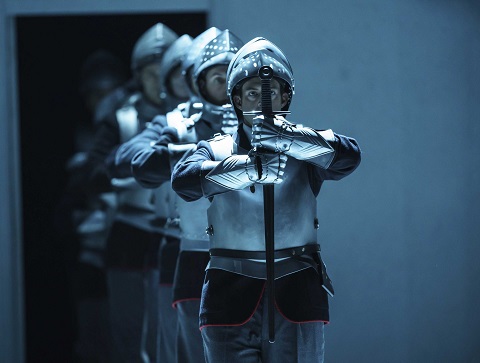 Jake Arditti (Rinaldo). Photo credit: Bill Cooper.
Jake Arditti (Rinaldo). Photo credit: Bill Cooper.
Gideon Davey’s single set serves as white-washed classroom, schoolyard, trainee dominatrices’ dormitory, and battle-cum-sports field. Smart in regulation blazer and tie, Rinaldo enters the empty schoolroom at 8.55am, pulls a portrait of his beloved from his satchel and pastes it inside the lid of his school-desk. A globe sits imperiously upon the Headmaster’s desk, a reminder of the Crusaders’ colonial imperialism, perhaps. The blackboard is blank: a tabula rasa for the unhappy teenager’s imagination. Just before the bell, a rowdy bunch of his peers burst in and, scenting a weakness, see an opportunity for some sadism and bullying. And, why not? They are, after all, only aping the Master and Mistress who then treat Rinaldo to a caning.
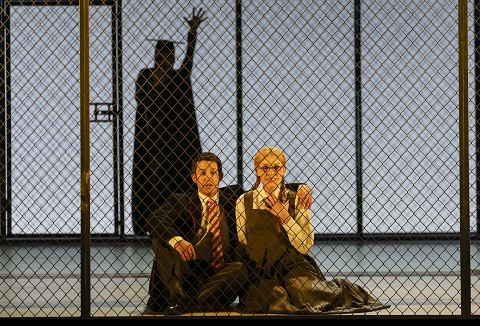 Jake Arditti (Rinaldo) and Anna Devin (Almirena). Photo credit: Bill Cooper.
Jake Arditti (Rinaldo) and Anna Devin (Almirena). Photo credit: Bill Cooper.
However, as writers from Lewis Carroll to Philip Pullman have long known, a child’s imagination sets them free. So, it’s off through the blackboard-glass we go. Rinaldo and his classmates don silver breastplates over their blazers; the Headmaster is transformed into a scheming Saracen, while the Mistress morphs into a school-boy’s fantasy: a slinky sorceress in dominatrix leather. Fired by Goffredo’s promise that victory in battle will earn him Almirena’s hand in marriage, Rinaldo tracks down his beloved amid the bicycle racks, only for Armida and her brigade of black-arts bandits - who’ve traded their burqas for gothic fishnets and miniskirts - to snatch her from his arms.
The ‘Crusaders’ set off to rescue her on flying bicycles - ET meets Mary Poppins - stylishly choreographed to intimate the equestrian exploits of their historical predecessors. There is visual spectacle and satire in equal measure. A siren-chorus of identikit Almirenas tricks Rinaldo into a boat and he finds himself imprisoned in Armida’s dormitory. Just when it seems that Alminera faces certain death, the Christian Magician’s word proves true - despite the mad scientist’s earlier explosive experimentations in the chemistry lab - and Goffredo and Eustazio ‘storm’ Armida’s palace. Well, some heroic knights leapfrog the ramparts with impressive athleticism, while others engage in a Morecombe & Wise routine: a Fosbury flop pratfall prompts some self-preserving pragmatism as the scenery is lifted, allowing the straggling Crusader to crawl his way through.
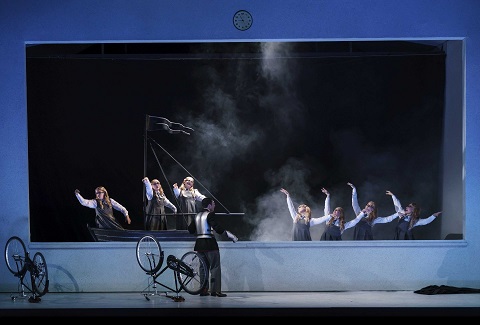 Photo credit: Bill Cooper.
Photo credit: Bill Cooper.
The final showdown takes place on the school playing-field, where, after all, all significant battles are won: lacrosse and hockey sticks clash as a large ball (the schoolmaster’s globe) floats balletically on the end of a stick, imbuing the fight with cartoonish grace. Naturally, the Christian Crusaders are triumphant. Rinaldo finds himself back in the empty school, the clock-hand not yet telling nine o’clock …
The light-hearted lunacy of the proceedings was beguiling and undoubtedly made more enchanting by the soloists’ mastery of the musical idiom. Jake Arditti is no stranger to outré Handelian outings, having sung the title role in Longborough’s 2014 production which saw him cast as the strong-man in the megalomaniac ring-master Argante’s circus. Here, he displayed infinite stamina, streaming through the vocal fountains with pinpoint precision, a fair amount of vocal embellishment, and envincing martial confidence and heroic conviction. ‘Cara Sposa’, which Handel himself considered one of his finest arias, was beautifully phrased and if it did not seem quite languid enough to really touch one’s heart, then perhaps Carsen’s prevailing comic irony made such sincerity hard to accomplish.
 William Towers (A Christian Magician) and James Hall (Goffredo). Photo credit: Bill Cooper.
William Towers (A Christian Magician) and James Hall (Goffredo). Photo credit: Bill Cooper.
Arditti’s fellow countertenors matched him for style, though James Hall’s Goffredo needed a little more weight and stature, especially at the end of Act 1 when he learns of his daughter’s kidnapping by the forces of darkness. Tom Scott-Cowell’s Eustazio offered a lyrical complement to both.
Anna Devin sang Almirena’s ‘Augelletti, che cantate’ with purity and poise, beautifully accompanied by the trilling birdsong of Rebecca Austen-Brown’s sopranino recorder. ‘Lascia ch’io pianga’, in which the imprisoned Almirena laments her fate, was also beautifully shaped, but I’d have liked a little more hint of the intensity and spirit with which the maiden urges her heroic rescuer on to victory.
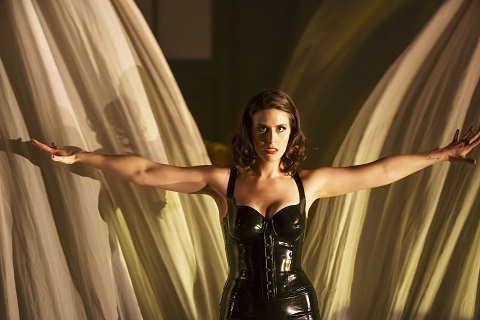 Jacquelyn Stucker (Armida). Photo credit: Bill Cooper.
Jacquelyn Stucker (Armida). Photo credit: Bill Cooper.
The task of delivering the feisty fury was left to Jacquelyn Stucker who, as a fire-and-brimstone Armida, topped the vocal honours and commanded the dramatic stage. Resplendent in shiny black latex - as fearsome as Maleficent, that ‘mistress-of-all-evil’ in Disney’s Sleeping Beauty - Stucker sang with a sparkle like the luxurious shine of rubies as Armida stamped and scorched her way through any obstacle that dared to confront her. Like the scythe she wielded with relish, Stucker’s soprano evinced a glamorous intensity with a real glint of danger. It had both bite at the top and succulence in the middle, as well as darkness at the bottom: it’s hard to imagine a soprano with the power and range more suited to embody the evil enchantress’s schizophrenic mood-swings - first she wants to destroy Rinaldo, then she wants to debauch him, seduced by his heroism and nobility. Armida’s hissy-fit when her plans are thwarted, and Argante proves unfaithful, was a sight to behold: bed-linen and furniture went flying asunder, and she whipped through Handel’s torturous runs, savouring the virtuosity. No wonder her acolytes cowered and cringed before her. Aubrey Allicock’s Argante also seemed a little overshadowed at times, though Allicock made a strong contribution to Carsen’s irony.
The superb cast were supported by buoyant playing from the reduced-sized Glyndebourne Tour Ochestra, conducted by David Bates. The recitatives had vivid energy, supported by David Miller’s creative archlute, which complemented the stage action; the fast numbers bubbled effervescently while the more reflective numbers had time to make their mark.
I confess that my natural inclination is to flinch from the sort of dramatic dabbling in which Carsen indulges here; but on this occasion I found myself increasingly relishing an insouciant irreverence - and sheer sense of fun - that Handel himself would surely have enjoyed. Such cheekiness also has the merit of taking the spotlight off the Christian triumphalism of the close: “O clemency of Heaven!”, “Blessed Fate!”, “Virtue has triumphed!” cry the elated, conquering Crusaders. “O happy we!” is the choric conclusion.
“After such cruel events, I don’t know if I am dreaming or awake,” says Almirena, when she is rescued by her warrior-hero. And, at the conclusion of Carroll’s Alice in Wonderland Alice berates her sister Kitty for waking her, reflecting on “who it was that dreamed it all. This is a serious question … You see, Kitty, it must have been either me or the Red King. He was part of my dream, of course—but then I was part of his dream, too!”
Carroll concludes:
In a Wonderland they lie,
Dreaming as the days go by,
Dreaming as the summers die:
Ever drifting down the stream —
Lingering in the golden gleam —
Life, what is it but a dream?
Sentiments with which, one imagines, Carsen would concur.
Claire Seymour
Goffredo - James Hall, Rinaldo - Jake Arditti, Almirena - Anna Devin, Eustazio - Tom Scott-Cowell, Herald - David Shaw, Argante - Aubrey Allicock, Armida - Jacquelyn Stucker, Woman - Catriona Hewitson, Siren 1 - Chloe Morgan, Siren 2 - Rachel Taylor, A Christian Magician - William Towers, Dancers (Caitlin Fretwell Walsh, Keiko Hewitt-Teale, Caroline Lofthouse, Sarah O’Connell, Sarah Ward), Actors (Andrew Hayler, Nathaneal James, Anthony Kurt Gabel, Bailey Pepper, Colm Seery); Director - Robert Carsen, Conductor - David Bates, Revival Director - Francesca Gilpin, Designer, Gideon Davey - Movement Director - Philippe Giraudeau, Revival Movement Director - Colm Seery, Lighting Designers - Robert Carsen/Peter van Praet, Glyndebourne Tour Orchestra.
The Marlowe Theatre, Canterbury; Friday 8th November 2019.
image= http://www.operatoday.com/GTO%20Rinaldo%20title.jpg image_description= product=yes product_title=Handel: Rinaldo - Glyndebourne Touring Opera at The Marlowe Theatre, Canterbury product_by=A review by Claire Seymour product_id=Above: Jacquelyn Stucker (Armida) and dancersPhoto credit: Bill Cooper
November 9, 2019
Predatory power and privilege in WNO's Rigoletto at the Birmingham Hippodrome
After Jo Davies’ #MeToo-filtered Carmen the previous evening at Birmingham’s Hippodrome, came this Welsh National Opera revival of James Macdonald’s 2002 production of Rigoletto, which transfers the action from an immoral court in Renaissance Mantua to modern-day corridors of power, laying bare the misogyny, abuse and moral vacuum which underpins contemporary political power and privilege.
Designer Robert Innes Hopkins’ monochrome projection of Capitol Hill - the neoclassical dome subtly recalling the opera’s original Renaissance setting - nods towards the Kennedy-era White House, a period now at least partially characterised by the catalogue of sexual infidelities, assaults and religious hypocrisy revealed subsequently. The interior design of Act 2’s Oval Office, however, suggests more recent political eras, perhaps the Clinton years or, inevitably, the current incumbent.
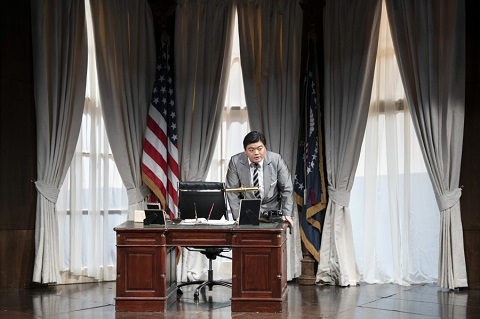 David Junghoon Kim (The Duke). Photo credit: Richard Hubert Smith.
David Junghoon Kim (The Duke). Photo credit: Richard Hubert Smith.
Though the Stars and Stripes stand tall behind the ‘President’s’ desk, the invitation to draw parallels between past and present is gently proffered, which is a good thing because if one probes to closely the holes and non sequiturs come into view. What is a court jester doing in the Oval Office? How does one explain society’s permittance of Gilda’s incarceration by her controlling father? And, we might believe that in the Renaissance a dutiful daughter, whose life has been a sequestered one, might not recognise her father’s employer, the local Lord, but would she really be so media-innocent in the late twentieth century and fail to spot the President - even if his old college scarf does serve as a ‘disguise’?
Most problematic of all is the opera’s central dynamic force (and original title): Monterone’s curse. It might be possible to interpret ‘la maledizione’ figuratively: a foretelling of the individual suffering that inevitably results from a corrupt patriarchal system? But, that’s not the line Macdonald takes. Here, Monterone - a straight-backed, stern Eddie Wade - is not dragged off to prison for his attack on the Duke’s debauchery but instead incarcerated in an asylum - an attempt to make sense of non-sense which doesn’t quite succeed.
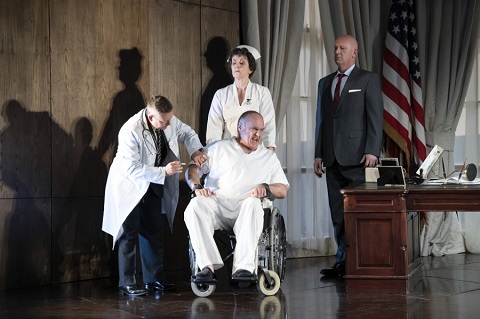 Eddie Wade (Monterone). Photo credit: Richard Hubert Smith.
Eddie Wade (Monterone). Photo credit: Richard Hubert Smith.
There were other small details that seemed to undermine the ‘realism’. The iron stairway leading up to Rigoletto’s shabby home is decked with flowerpots and a pumpkin; yet Gilda, full of the joy of misguided love, dances up the steps waving a sparkler. Given the timing of this tour, perhaps revival director Caroline Chaney was hedging her bets on Hallowe’en or Guy Fawkes Night? Then, when Gilda has been kidnapped, she runs through the Oval Office wearing a pair of pristine pyjamas, the sleeve of one arm decorously ‘torn’, not a hair out of place.
But, as always with such minor irritations, they were swept away by some truly engaging sung performances, as Rigoletto and the Duke battled it out not only for possession of ‘their girl’ but also for the vocal honours. Mark S Doss has a big bass-baritone which seems almost to reach out and grasp the audience, compelling them to share in Rigoletto’s trials and agonies. His voice can feel a little cumbersome at times, but the American singer can vary its colour, and its essential weight and fullness also means that the pianissimos can fade to a wisp and still make a mark. I found this Rigoletto a little too fond of grimacing, hand-wringing and head-clutching, as Doss sought to convey the ‘jester’s’ moods as they modulate between mockery, rage and distress. But, I did feel Rigoletto’s vulnerability. He cruelly baits Monterone but it’s clear he just wants to be in the gang - there’s a fine line between the bully and the bullied - though his checked jacket, as much as his hunchback and limp, mark him as, unavoidably, an outsider. Moments such as Rigoletto’s desperate scramble up the stairs, to discover that Gilda has been abducted, and his opening of the sack to find it contains the body of his daughter, were powerfully emotive.
David Junghoon Kim’s careless, self-regarding Duke remains unaware of such distress, which arises from his own narcissistic self-indulgences. Since I first heard him 2016, when he joined the Royal Opera House as a Jette Parker Young Artist, Junghoon Kim’s seems to have blossomed fulsomely, and now boasts a rich sheen, varied tonal shades and real strength of line. ‘La donna e mobile’ was muscular and clear, delivered with a confidence laden with conceit. Does the Duke really love Gilda? It wasn’t, perhaps never is, possible to know: perhaps he just thinks he does, for a short moment.
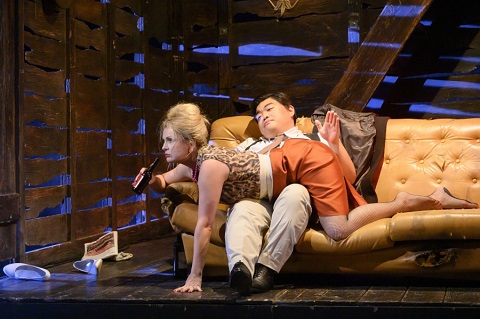 Emma Carrington (Maddalena) and David Junghoon Kim (The Duke). Photo credit: Richard Hubert Smith.
Emma Carrington (Maddalena) and David Junghoon Kim (The Duke). Photo credit: Richard Hubert Smith.
This Gilda certainly loves him, though. Haegee Lee (like Junhgoon Kim, a former Jette Parker Young and also hailing from Korea) has such a purity of tone and accuracy of intonation and ornament that one would never for a moment doubt Gilda’s sincerity. When I heard Lee sing ‘Caro nome’ during this year’s JPYA summer showcase , I was tremendously impressed, praising ‘a measured and confidently crafted performance which communicated character and feeling most impressively’. Here, while no less struck by Lee’s vocal precision and care, I found her dramatic embodiment of the role less convincing: too much wide-eyed wonder and ingénue stargazing for my liking.
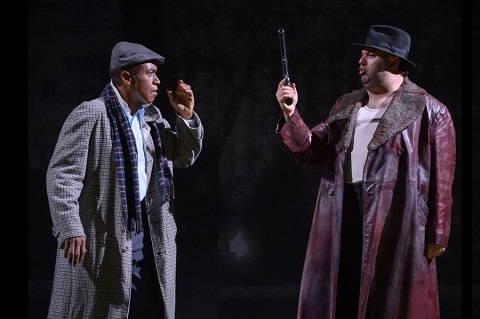 Mark S Doss (Rigoletto) and James Platt (Sparafucile). Photo credit: Richard Hubert Smith.
Mark S Doss (Rigoletto) and James Platt (Sparafucile). Photo credit: Richard Hubert Smith.
James Platt was a frightening Sparafucile, lingering menacingly in the shadows, his Hadean voice shimmering with hatred (and evidencing none of the ‘wobble’ that has sometimes been evident of late). The Act 3 quartet was a dramatic and musical highlight, Emma Carrington’s Maddelena descending from atop the tawdry inn to seduce a Duke she seemed to truly love, just as blindly as Gilda.
Conductor Alexander Joel led a thoughtful performance in the pit, one skilfully paced and readily ratcheting up the tension as required. It was a pity, therefore, that having churned up an emotional maelstrom in the first scene, a technical hitch (one presumes?) during the scene change resulted in a long hiatus before the action resumed, undoing Joel’s good work as the audience relaxed, chatted and fidgeted.
Rigoletto has always been ‘political’. Its ‘predecessor’, Victor Hugo’s carefully researched study of ‘Francis I’, fooled no one and Hugo’s thinly disguised criticism of King Louis-Philippe led to his play being banned after one performance, not to be seen in France for 50 years. Verdi’s censors allowed him and Piave, his librettist, to set the play only if the action was transferred from France to Mantua, Francis I becoming a Gonzaga duke in a royal court that was no longer in existence, and as such unlikely to either offend or incite. In his renowned ‘mafioso’ staging for ENO, Jonathan Miller exploited this innate political core to the full. The corruption of high office; the ethical vacuity of the ruling classes; power maintained by misogyny, abuse and violence: plus ça change. Le roi s’amuse indeed.
That said, the perspective that Macdonald encourages us to adopt - like Jo Davies’ #MeToo sightline the previous evening - seemed ultimately irrelevant to the listening theatre-goer’s experience and pleasure. Together these two engaging and enjoyable WNO productions suggest that it’s the music and the singing that hold the balance of operatic power after all.
Claire Seymour
The Duke - David Junghoon Kim, Gilda - Haegee Lee, Rigoletto - Mark S Doss, Monterone - Eddie Wade, Countess Ceprano - Paula Greenwood, Sparafucile - James Platt, Count Ceprano - Martin Lloyd, Borsa - Simon Crosby Buttle, Marullo - Alastair Moore, Giovanna - Sian Meinir, Maddalena - Emma Carrington, Page - Francesca Saracino, Usher - George Newton Fitzgerald; Director - James Macdonald, Revival Director - Caroline Chaney, Designer - Robert Innes Hopkins, Lighting Designer - Simon Mills, Orchestra and Chorus of Welsh National Opera.
Birmingham Hippodrome; Wednesday 6th November 2019.
image=http://www.operatoday.com/WNO%20Rigoletto%20title%20Mark%20S%20Doss%20Rigoletto.jpg image_description= product=yes product_title=Bizet: Rigoletto - Welsh National Opera at the Birmingham Hippodrome product_by=A review by Claire Seymour product_id=Above: Mark S Doss (Rigoletto)Photo credit: Richard Hubert Smith
November 8, 2019
Virginie Verrez captivates in WNO's Carmen at the Birmingham Hippodrome
Instead, Davies and designer Leslie Travers, in their attempt to examine the sexual politics of Carmen through a contemporary lens, transfer the action of the opera to the ‘world of Brazilian favelas and the tight community within’. They cite the Brazilian government’s implementation, with the assistance of the army, of the favela eradication in the 1960s - and the poverty, violence and lawlessness that characterised the favelas - as evidence in support of their argument that this world fits ‘the economic and sexual politics of Carmen’ and is ‘a good home for Carmen’s wild Bohemian spirit’.
At least, that’s what Davies tells us in a programme booklet article which I did not read until after the performance. Looking at Travers’ grey, gritty set - a curving edifice that served, pretty effectively, as run-down tenement block, soldiers’ barracks, Lillas Pastia’s tavern in the shadow of the ramparts, mountain-side smugglers’ den, and bull-ring arena - I had no sense of the ‘visual flavours of Latin America’ that Travers and costume designer Gabrielle Dalton are reported to have researched.
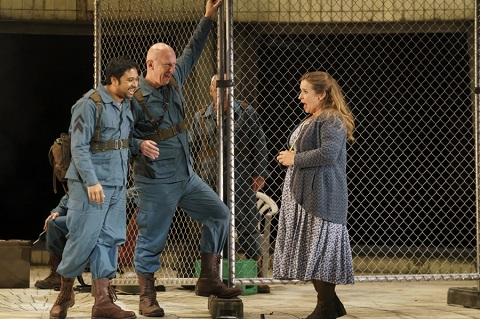 Ross Ramgobin (Moralès), Anita Watson (Micaëla). Photo credit: Bill Cooper.
Ross Ramgobin (Moralès), Anita Watson (Micaëla). Photo credit: Bill Cooper.
Not that it mattered. The opening moments of the production may not have dazzled our eyes with the oranges and golds, gleaming in the bright white light, of a square in Seville, but the grimy compound enclosed by metal grilles, through which the smirking soldiers leered at passing young girls, and the towering tenements strewn with sagging washing-lines, made for a persuasive, if indeterminate, locale. As the grilles were swivelled when the working girls finished their shift at the cigarette factory, we were by turn both outsiders and insiders, a fitting metaphor for the opera’s tensions and divisions.
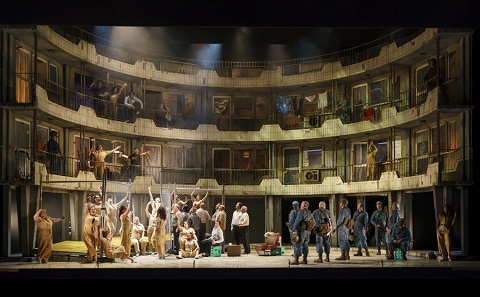 Photo credit: Bill Cooper.
Photo credit: Bill Cooper.
There was, however, little sense of racial conflict. This Carmen was no foreigner on Spanish soil, a traveller from lands flung far and wide, who challenges a society that cannot accept the outsider for fear of denying itself. Her wildness was not a sort of gypsy madness, rather a wilfulness born of frustration and a desire for freedom. Fair enough. But, there was similarly no sense of the class conflicts that oppress Carmen (reflecting the contemporary tensions between the middle-class and the large, malleable labour force upon which the bourgeoisie depended in Bizet’s France), despite Davies’ suggestion that Carmen is a sort of nineteenth-century Jade Goody, cut from a similar working-class cloth.
If you excise race and class, you’re left with gender and nineteenth-century cultural ambivalences about women and female sexuality. Indeed, Davies’ principal aims seems to have been to take a feminist stance and pose some #MeToo questions in the context of contemporary sexual politics. But, while she asks, ‘whether Bizet’s ending would be the same, or any different were he writing today?’, Davies’ production doesn’t actually venture very far in exploring this question. Some of the spoken dialogue may have been revised, but since it’s in French this will pass most of the audience by, unless they glance up at surtitles which are out-of-kilter with the stage action. Instead, what we have is a conventional telling of an ‘old’ tale: the silencing of a sexually confident woman by a society afraid of her liberated spirit.
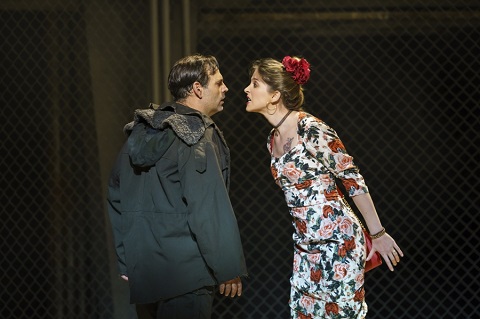 Dimitri Pittas (Don José), Virginie Verrez (Carmen). Photo credit: Bill Cooper.
Dimitri Pittas (Don José), Virginie Verrez (Carmen). Photo credit: Bill Cooper.
Fortunately, Davies has an excellent cast to tell this tale. French mezzo-soprano Virginie Verrez’ Carmen really does charm and entrance when she sings, even if her actions and behaviour are often more aggressive than provocative. Carmen clicks, not castanets, but empty shot glasses; she douses a soldier in liquor and taunts him with a lighted match, laughing viciously. Charming. Though more likely to be wielding a Kalashnikov than castanets, Verrez still seduced: she has a lovely silvery, silky mezzo which can shine brightly or sink into darker hues, and she moves between the two with confidence and expressive clarity. Her Habañera fully exploited the teasing slides of Bizet’s chromaticism but it’s a pity that Davies doesn’t really acknowledge that this is both song and dance: the physicality of the song expressed through its vamping rhythm and extravagant leaps and descents of register was largely absent. During the ‘Seguidilla’, Carmen remained squarely seated on the ground, her hands tightly bound, though Verrez was able to communicate the physical slipperiness implied with her voice. At Lillas Pastia’s tavern, Carmen offers to dance for José alone, but then spends most of the song lounging on an ugly plastic chair; two dancers are called upon to express the implied physical dynamics and impulses.
Such numbers are also ‘performances’: we are not sure, when she sings these ‘popular songs’ whether Carmen is expressing herself or adopting a theatrical persona. Here, Carmen’s songs were not placed ‘in the spotlight’ in this way; even the impact of her first entrance, which is such a disruptive dramatic force, was diminished as she meandered through the crowd of girls and soldiers. Despite this, Verrez held our attention and enchanted our ears throughout; tattooed and pony-tailed, sporting first dull dungarees and trainers, later a backless floral frock accessorised with red handbag and stilettos, she might have become the generic ‘Essex girl’ with whom Davies draws parallels. That she did not speaks much for Verrez’ technical and expressive assurance.
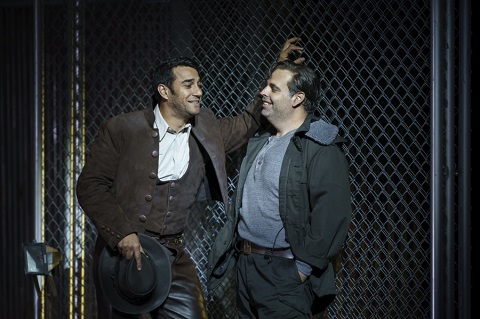 Phillip Rhodes (Escamillo), Dimitri Pittas (Don José). Photo credit: Bill Cooper.
Phillip Rhodes (Escamillo), Dimitri Pittas (Don José). Photo credit: Bill Cooper.
Dimitri Pittas’ José is more despondent sulk than bewildered naïf, but Pittas has the range and power for the part. The mummy’s-boy cadet was fittingly melancholy and troubled, and, by Act 4, credibly deranged by love and impotence as he prowled within the crowd outside the bull-ring arena. Initially, I thought I detected an edgy grain to Pittas’ tenor, when it was pushed high or loud, and the ‘Flower Song’ didn’t really intoxicate with its melodic flights of fancy; but, his tenor increasingly found a finer, warmer focus and, by the climactic duet, rang with dramatic intensity.
Anita Watson was a surprising forthright Micaëla, and it worked: this Micaëla was much more than a one-dimensional ‘good girl’ - the foil to Carmen, introduced into the opera to satisfy Bizet’s bourgeois audience. She was not intimidated by the groping eyes of the soldiers in Act 1, making her utterances more integrated into the dramatic tension than is sometimes the case. And, during her Act 3 air, time seemed to stand still: Watson conveyed Micaëla’s quiet heroism most impressively. This was a moment of serenity amid the prevailing moral chaos. Phillip Rhodes’ Escamillo wore the toreador’s leather trousers and blouson with style and displayed the sort of vocal and physical appeal that made Carmen’s attraction persuasive - though, again, he had to fight his way to centre-stage through the revellers at Lillas Pastia’s.
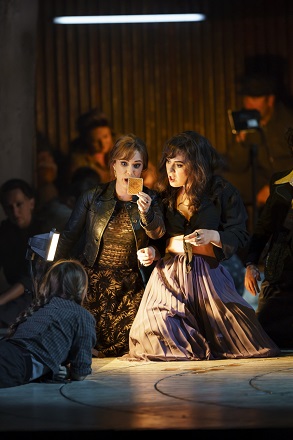 Harriet Eyley (Frasquita), Angela Simkin (Mercédès). Photo credit: Bill Cooper.
Harriet Eyley (Frasquita), Angela Simkin (Mercédès). Photo credit: Bill Cooper.
The secondary roles were strongly characterised and sung, which served to create an impression of a ‘real’ community. Frasquita (Harriet Eyley) and Mercédès (Angela Simkin) were fully involved in the drama, sang with vibrancy, and were also clearly distinguished characters. The reading of the cards was a striking moment, no mere divertissement for smugglers and gypsies with time on their hands. Both her companions’ care for Carmen, and the veracity of the danger embracing her, were powerfully communicated. “Death, I saw it, him first, me next, for both of us, death,” Carmen sings, darkly and slowly. It seemed to me that here, perhaps, was a way to answer the #MeToo questions Davies’ purports to pose: fated to die, she may still control when and where? Might not Carmen’s final declaration, “I know that you are going to kill me; but whether I live or die, no, no, I shall not give in to you!” and her command, “All right, stab me then, or let me pass!”, be dramatized as a choice? After all, she sings, “Free she was born and free she will die!”
Henry Waddington really grabbed one’s attention as Zuniga, while Ross Ramgobin’s Moralès was a strong dramatic presence in the opening Act. Benjamin Bevan (Dancaire), Joe Roche (Remendado) and Gregory A Smith (in the spoken role of Lillas Pastia) enlivened the bandit scenes. The children’s chorus were superb, raised on the tenement balconies, firing water-pistols at the marching soldiers, and the Chorus of WNO sang, and moved, persuasively. Tomáš Hanus drew some fire and spirit from the WNO Orchestra, balancing the exoticism with a warm Romantic glow.
This was a highly enjoyable evening. No ‘concept’ was needed - or, indeed, really evident: singers and musicians simply let Carmen’s songs ‘speak’ for themselves.
Claire Seymour
Carmen - Virginie Verrez, Don José - Dimitri Pittas, Micaëla - Anita Watson, Escamillo - Phillip Rhodes, Moralès - Ross Ramgobin, Zuniga - Henry Waddington, Frasquita - Harriet Eyley, Mercédès - Angela Simkin, Dancaire - Benjamin Bevan, Remendado - Joe Roche, Lillas Pastia - Gregory A Smith, Dancers (Carmine De Amicis, Josie Sinnadurai); Director - Jo Davies, Conductor - Tomáš Hanus, Set Designer - Leslie Travers, Costume Designer - Gabrielle Dalton, Movement Director - Denni Sayers, Assistant Choreographer/Dance Captain - Carmine De Amicis, Fight Director - Lisa Connell, Orchestra and Chorus of Welsh National Opera.
Birmingham Hippodrome; Tuesday 5th November 2019.
image=http://www.operatoday.com/Angela%20Simkin%20Harriet%20Eyley%20Virginie%20Verrez.jpg image_description= product=yes product_title=Bizet: Carmen - Welsh National Opera at the Birmingham Hippodrome product_by=A review by Claire Seymour product_id=Above: Angela Simkin (Mercédès), Harriet Eyley (Frasquita) Virginie Verrez (Carmen)Photo credit: Bill Cooper
November 7, 2019
Die Zauberflöte brings mixed delights at the Royal Opera House
This seventh revival of David McVicar’s Die Zauberflöte, first shown in 2003 and now rebooted by Bárbara Lluch, is no less gloomy or plausible in its narrative. Thankfully, its exploration of Enlightenment values, and its narratives of morality and power, are all given a light dusting and freemasonry is all but erased in this dark and occasionally enchanting production.
The glowing orbs carried through the stalls at the start of the Overture signal where we’re heading, not necessarily plot-wise but more by suggestion in terms of emotional trajectory. Ancient superstitions are abandoned for reason and a partnership of equals emerges after several testing ordeals for Tamino and Pamina whose joyful union is ultimately celebrated. Sounds cosy, but notions of power and equality propounded by Mozart’s librettist Emanuel Schikaneder are merely ideals, and in that sense, we’ve not come very far since Viennese audiences first heard this musical fairy-tale in 1791.
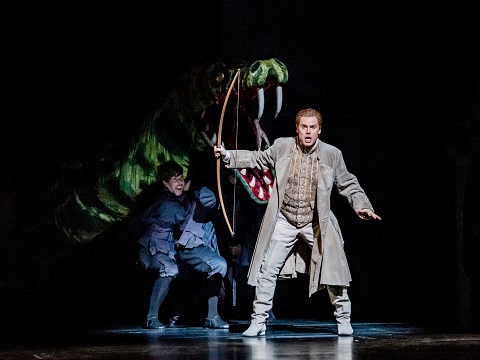 Benjamon Hulett (Tamino). Photo credit: ROH/Tristram Kenton.
Benjamon Hulett (Tamino). Photo credit: ROH/Tristram Kenton.
The work’s underlining solemnity is balanced by gentle humour, generated not so much by the accoutrements of popular theatre presented here - a wriggling serpent, the rubber chicken or the air-borne bicycle - but by the characters themselves, principally the comic exchanges between Vito Priante’s engaging Papageno and Elsa Dreisig’s spirited Pamina. Their partnership is more convincing than any other on stage and enjoys a special camaraderie nowhere more obviously than in the companionable duet ‘Bei Männern, welche Liebe’ - sung with effortless musicality and glorious tone and connected by a real chemistry - a bond that, had he been a tenor, Priante and Dreisig would have made a believable married couple-to-be. Benjamin Hulett’s ringing Tamino is fervently and cleanly delivered: a strong wholesome and safe-as-houses tenor arrives in ‘Wie stark ist’, but the unvarying nobility of stance and textbook movements never quite draw the eye. Tamino’s betrothal to Pamina is a plot convenience, but here manages to look more manufactured than usual simply because the rapport is missing and it’s not just Mozart’s fault.
The composer conceived the work for a theatre in a Viennese suburb for a popular audience used to family entertainment. That he elevated this Singspiel to more lofty dimensions isn’t an issue here, more the absence of any sense of wide-eyed wonder in a shadowy production that stems as much from the drab colours (even the wild animals look anaemic) as the unimaginative direction, and where singers at times are almost overwhelmed by the sheer enormity of the surrounding marble columns. These crowd the stage to oppressive effect and merely highlight the post-war pallor of the costumes. Spectacle is there, of course, such as the giant moon and sun, but it needs more than a lick of paint to liven up proceedings within these, often empty, cavernous spaces. 18th-century frock coats, pretty dresses and a shabby suit for a mallard-wearing Papageno don’t quite remind us that this opera shares elements with pantomime.
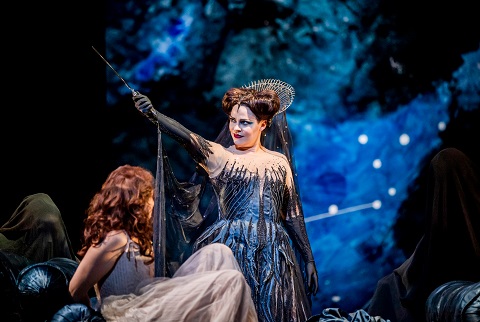 Elsa Dreisig (Pamina) and Tuuli Takala (Queen of the Night). Photo credit: ROH/Tristram Kenton.
Elsa Dreisig (Pamina) and Tuuli Takala (Queen of the Night). Photo credit: ROH/Tristram Kenton.
Niggles aside, I enjoyed the absence of distracting movement during many of the set pieces, allowing key arias and ensemble numbers to register fully, to speak for themselves as it were. Particularly memorable was the wonderful Act Two Terzett ‘Soll ich dich’, beautifully rendered, buoyant and sung with flawless ensemble and genuine affection - a standout moment of pure bliss. Elsewhere, the trio of Ladies (Kiandra Howarth, Hongni Wu and Nadine Weissmann) eventually found an accommodation in their ensembles, a quality brought off with great assurance by the three boys Richard Wolfson, Joshua Abrams and William James who made the most of their cameo roles.
There is plenty of drama from the Finnish soprano Tuuli Takala as an admirable Queen of the Night. Her arias blazed with conviction and brought sustained applause for her efforts. Equally impressive, and at the other end of the stave, is the commanding presence and amply upholstered bass of Andres Bauer Kanabas as Sarastro. His shapely ‘O Isis und Osiris’ was especially gratifying. So, too, was the clarion and insinuating tone from Rodell Rosel as a foppish Monostatos - less a repellent monster than someone to be ridiculed. It was curious to see Papagena dressed as a woman belonging to the oldest profession, but Chilean soprano Yaritza Véliz fulfilled her portrayal with ease.
Leo Hussain directs the Royal Opera House Orchestra with flair, bringing flexible and generally forward tempi. Despite the odd disagreement between pit and stage the opening night was a musically persuasive evening and will sharpen up in time.
David Truslove
Tamino - Benjamin Hulett, Papageno - Vito Priante, Queen of the Night - Tuuli Takala, Monostatos - Rodell Rosel, Pamina - Elsa Dreisig, Sarastro - Andres Bauer Kanabas, Papagena - Yaritza Véliz, First Lady - Kiandra Howarth, Second Lady - Hongi Wu, Third Lady - Nadine Weissmann, First Boy - Richard Wolfson, Second Boy - Joshua Abrams, Third Boy - William James, Speaker of the Temple - Darren Jeffery, First Priest - Harry Nicoll, Second Priest - Donald Maxwell, Men in Armour - Andrés Presno & Julian Close; Director - David McVicar, Conductor - Leo Hussain, Revival Director - Bárbara Lluch, Designer - John Macfarlane, Lighting - Paule Constable, Movement Director- Leah Hausman, Revival Movement Director - Angelo Smimmo, Orchestra and Chorus of Royal Opera House.
Royal Opera House, Covent Garden, London; Friday 1st November 2019.
image=http://www.operatoday.com/Vito%20Priante%20%28Papageno%29%20and%20Elsa%20Dreisig%20%28Pamina%29.jpg image_description= product=yes product_title=Mozart: Die Zauberflöte, Royal Opera House, Covent Garden product_by=A review by David Truslove product_id=Above: Vito Priante (Papageno) and Elsa Dreisig (Pamina)Photo credit: ROH/Tristram Kenton
November 6, 2019
Soprano Eleanor Dennis performs Beethoven and Schubert at the 2019 Highgate International Chamber Music Festival
Aberdeenshire-born, Eleanor explains that she has a natural feeling for the traditional Scots poetry, which is written in a register with which she is entirely comfortable. “While a beautiful melody may be the thing that immediately draws one’s ear to a particular song, when learning a song I always think about the words first, about the focus of the song. If the poem is ‘special’ then it will always be even more pleasurable to sing.”
Eleanor will perform three of the 25 songs which form Beethoven’s Op.108 set at St Anne’s Church on Sunday 24th November , accompanied by a piano trio comprising Joseph Middleton (piano), Natalie Klouda (violin) and Caroline Dale (cello). At the time when Beethoven was making his arrangements of these traditional Scots melodies and lyrics (the arrangements were essentially intended as drawing-room songs aimed for an audience of well-to-do Scottish amateurs) there was a vogue in Germany for all things Scottish, especially the pseudo-Celtic works of Ossian and the novels of Sir Walter Scott. It should, however, be noted [1] that there was little common ground between poets such as G.A. Bürger and J.W. von Goethe, and musicians such as Reichardt and K.S. von Seckendorff - who, in the 1790s, developed a scholarly interest Scottish antiquity - and composers such as Haydn who at the same time began to make arrangements of songs with a realised bass line and occasional obbligato instruments to fulfil commissions for British Scots song collections.
Haydn made almost 400 such arrangements (mostly of Scottish songs, but also some Irish and Welsh songs) for collections published by William Napier (Original Scots Songs), George Thomson (A Select Collection of Scottish Songs), and William Whyte ( A Collection of Scottish Airs). And, it was Thomson who encouraged Beethoven to compose his own Scots song settings, first contacting him in 1803 to suggest that he might write some sonatas on Scottish tunes and later proposing that Beethoven might contribute to Thomson’s aforementioned collection. However, it was not until Haydn died, in 1809, that Beethoven began; the first of the Scottish tunes which he arranged appeared in volume five of the Select Collection (1818) and it is this volume from which the Op.108 songs are drawn.
Eleanor has chosen three songs which she describes as different in mood but forming a well-balanced trio. The strophic ‘Bonny Laddie, highland Laddie’ is bright and jolly, while ‘Sunset’ is a more melancholy setting of a poem by Walter Scott. ‘Faithfu’ Johnie’ has also been arranged for duet, with male and female voice in dialogue.
In St Anne’s Church later this month, Eleanor will also perform Schubert’s Der Hirt auf dem Felsen (The Shepherd on the Rock, D965), with clarinettist Peter Sparks and pianist Joseph Middleton. Completed in October 1828, this was one of Schubert’s last compositions before his premature death. It originated in a request from the singer Pauline Anna Milder Hauptmann for something that she might sing in her concerts: ‘a more brilliant music for the voice’ and something in which ‘several emotions can be presented’.
Interestingly, Eleanor remarks that one of the (many) challenges of the piece - which she initially learned for an end-of-year undergraduate examination - relates to the structure and diversity of the work. There are seven poetic verses, the first four and last by Wilhelm Müller, and verses five and six by Karl August Varnhagen von Ense. The musical structure divides into three main sections, each with its own demands. There are also repetitions: “The singer needs to find different ways of doing the same thing. And, the slower middle section is very sustained: you need to reflect on the vocal colour and feeling. It’s technically very difficult.” I wonder whether there are particular challenges when performing with obbligato instruments: “Well, an instrumentalist will come at the work from a different perspective, one perhaps less focused on the words and more on melody and harmony; and one needs to listen to the colours that they produce - one can copy, complement and gain inspiration.”
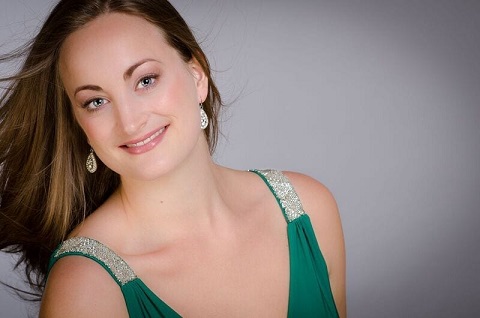 Eleanor Dennis. Photo credit: Christina Raphaelle.
Eleanor Dennis. Photo credit: Christina Raphaelle.
Eleanor regrets that the opportunities for her to perform chamber music are few and far between; she would love to do more and looks back at her student years when she had lieder classes exploring the songs of Schumann and of Strauss, and which, she admits, she probably took for granted at the time. But, she does not lament the wonderful operatic opportunities that have come her way.
Eleanor is a graduate of the Royal College of Music’s International Opera School and a former Harewood Artist at English National Opera. I think it was with the latter company that I first saw her perform on the operatic stage, in Vaughan Williams’ The Pilgrim’s Progress in November 2012, having heard her sing in the Kathleen Ferrier Award final at Wigmore Hall earlier that year. “I’d performed opera in the Britten Theatre at the RCM but my first opportunity to sing at the Coliseum with English National Opera was just amazing. The size of the auditorium, and of the chorus and orchestra. It was awesome.” I remember Eleanor, too, as a ‘poised and imperious’ High Priestess in Phelim McDermott’s season-opening production of Aida in 2017, in which Tom Pye’s designs, Bruno Poet’s lighting and the bevvy of dancers and acrobats seemed to me to have been judged by the creative team to be more important than the score and singing itself - though that made the production no less spectacular and enjoyable. “I’d imagined that I would be singing from off-stage, but in fact I was not only on stage but wearing a nude body suit: it was the right thing at the right time,” Eleanor laughs. It was a case of seeing what evolved on the night, and the singers were in need of a little more structure, whatever the merits of the visual beauty and the kinetic vitality.
Britten’s music has played an important part in Eleanor’s musical and professional development. She has commented elsewhere, “My first operatic memory is being in the Peter Grimes opening chorus, aged about four, and having the time of my life. From then on, opera just became the thing I loved.” In the 2019/20 season Eleanor makes her debut with Opera North as Miss Jessel in The Turn of the Screw , a revival of Alessandro Talevi’s 2010 staging; indeed, she is just about to commence a week of music rehearsal, prior to a further three weeks of work in the theatre in the new year. “This is a big sing, as big as Britten gets; I learned it for my Opera North audition, and this was the first time that I’d really looked closely at the music. It’s intensely dramatic, and really something to get one’s teeth into.” There’s also the challenge of embodying a ghost, something that Eleanor is clearly looking forward to!
2020 also sees Eleanor make her debut for the Grange Festival, as Helena in a new production of A Midsummer Night’s Dream (Paul Curran’s production, seen in Europe, will be ‘remade’ for The Grange). This has become almost a signature role for Eleanor: she performed the part of the feisty Helena at ENO in 2018 and the year before I saw her performance at the Aldeburgh Festival in Netia Jones’ wonderfully magical visual spectacle. I remark that the latter production was made even more bewitching by Iestyn Davies’ performance as Oberon: “Yes, it’s amazing - even in rehearsals - what he can do with his voice,” Eleanor remarks generously, obviously delighted to have been involved in such a creatively inspiring production.
I ask Eleanor what she finds so rewarding and stimulating about singing Britten’s music: “It’s the way he sets words to music. Britten knows exactly how to ‘colour’ words; and if you just sing what’s on paper - every dynamic marking, accents, every dotted crotchet - then you will communicate.” She finds Helena a particularly interesting comic character to interpret. “At times she is playful - ‘I am your spaniel’ - elsewhere flirtatious or furious.” Eleanor suggests that singers of Britten’s music just need to listen to the orchestral fabric and harmony: there are “crunchy dissonances, and deliciously playful, piquant harmonies” and the orchestral sound embraces the voice.
I conclude with a customary question: what next? Strauss is clearly where Eleanor’s heart lies (casting directors take note!). She is looking to tackle some bigger roles, such as the Marschallin and Arabella, in future; and, also, Wagner. But, then, there will always be room for Mozart, too: for the Countess, Fiordiligi (my Opera Today colleague, Mark Berry, very much enjoyed Eleanor’s performance at Opera Holland Park in 2018 ), the First Lady (“it’s difficult but always fun”), and Donna Elvira.
But, first there come German Romantic interpretations of poetry, both Scottish and German. At the very least, one can be assured that Eleanor will fully inhabit the language with idiomatic nuance and native fellow-feeling!
The Highgate International Chamber Music Festival runs from 23rd to 30th November 2019.
Claire Seymour
[1] As explained by Sarah Clemmens Waltz (2011), ‘Great Expectations: Beethoven's Twenty-Five Scottish Songs, The Beethoven Journal, Vol.26/1:13-25.
Photo credit: Christina Raphaelle
November 5, 2019
Haydn's La fedeltà premiata impresses at the Guildhall School of Music & Drama
Haydn’s opera mixes seria and buffa elements, and while it delights in ridiculing classical pomp and presumption - the Act 2 finale openly parodies the coro di Furie from Gluck’s Orfeo ed Euridice - there are also moments of genuine pathos and musical sincerity. First performed at Eszterháza on 25th February 1781, La fedeltà premiata celebrated the reopening of the court theatre after a fire. It was much admired: revised in 1782, it went on to receive 36 performances in four seasons, second only in popularity to Haydn’s dramma eroico, Armida; in 1784 a performance was given, in German translation, by Schikaneder’s troupe in Vienna. Thereafter it fell into obscurity, though the overture remained familiar - in its guise as the finale of his Symphony No.73, La Chasse - and one scene (Celia’s ‘Ah come il core’) was published as a cantata for soprano and orchestra.
The dismantled and dispersed manuscript was eventually ‘rediscovered’ in Turin and in 1968 a complete score was published for the first time by Henle-Verlag. The first modern performance took place at the Holland Festival in 1970, the first UK staged performance occurred as part of the Camden Festival in April 1971, and since then both Glyndebourne (1979) and Garsington (1995) have presented productions, as have some of London’s conservatoires.
If La fedeltà premiata has, like the dozen so operas by Haydn that have survived, struggled to find a foothold in the opera house, then it can’t be denied that Haydn did give his audience at Eszterháza much eventful extravagance and spectacle. Sea-monsters and satyrs are on the rampage. A wild boar separates the heroes from the hysterics, sending the philandering ‘Count’ Perrucchetto - whose name literally means ‘wig-maker’ - clambering up a tree-cum-stepladder, while the noble Fileno shows his mettle by slaying the beast.
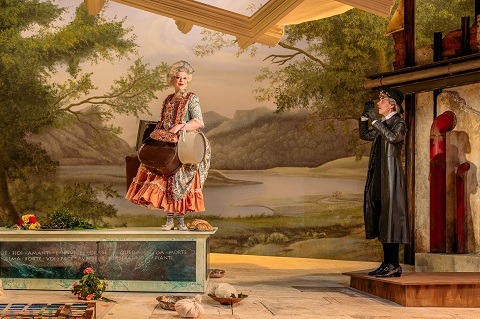 Eline Vandenheede (Amaranta), Adam Maxey (Melibeo). Photo credit: Mihaela Bodlovic.
Eline Vandenheede (Amaranta), Adam Maxey (Melibeo). Photo credit: Mihaela Bodlovic.
There’s a colourful cast of characters too, including Melibeo, the crooked High Priest (here looking like the Witch-Finder General in his menacing leather coat and gloves, though his spy-goggles were designed to wheedle out faithful lovers than that supposed sorceresses), and Amaranta, a grand ‘lady’ who hails from the sticks but gives herself airs and graces. Flirtatiousness and falsehood seem to be leading to tragedy before an honest swain’s self-sacrifice sees the sea-monster struck by a thunderbolt and its lair transformed into the Temple of Diana: the goddess descends, deus ex machina, the true lovers are re-united and all live happily ever after.
The finer details of the plot of Giambattista Lorenzi’s libretto remained elusive, though, even after this engaging and committed performance of Stephen Barlow’s new production by the postgraduate students of GSMD. In the first scene, Amaranta essentially sets out the stall by reading the inscription on the Temple of Diana which proclaims that, ‘Every year two faithful lovers will be sacrificed to the sea monster until a heroic soul offers his own life. Only then will peace return to the land of Cumae’.
So, the hunt begins for a pair of faithful lovers to appease the goddess of hunting and chastity, the chase being led by Melibeo who has his own lustful eye on Amaranta. The problem is that faithful lovers are in short supply, not least because to publicly declare one’s true devotion would mean certain death. There thus ensues a parade of private professions of love and swift public denials: necessity makes a virtue of fickleness. Essentially Nerina loves Lindoro (Amaranta’s brother), but he loves Celia (who is Fillide in disguise), who in turn loves Fileno (who, for an unexplained reason, thinks Fillide is dead - bitten by a snake, presumably a wry nod to Gluck). Perruchetto loves everyone, especially himself. The intrigues, betrayals and back-tracking pile up until Melibeo, exasperated by the repeated thwarting of his plans to matchmake some lovers whose death will revoke the curse, and by Amaranta’s wild wilfulness, imprisons Celia in a cave with Perruchetto, presumably assuming that she will emerge unchaste. When she insists upon her preserved purity, he determines that they will be serve to satisfy the sea monster anyway, prompting Fileno to offer himself as a sacrifice instead. Cue Diana, waving her magic wand - and skilfully wielding her long-bow to strike the dastardly Melibeo with an arrow.
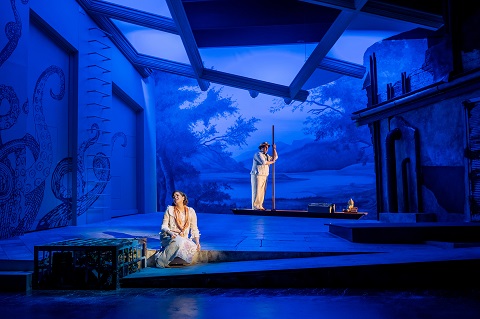 Ema Nikolovska (Celia), Robert Lewis (Fileno). Photo credit: Mihaela Bodlovic.
Ema Nikolovska (Celia), Robert Lewis (Fileno). Photo credit: Mihaela Bodlovic.
Barlow suggests that when he read through the libretto, his first thought was that it was essentially an episode of Love Island. Fortunately, his reflections did not stop there, and his production is a charmingly insouciant mishmash of pseudo-antiquity, eighteenth-century Classicism and modern-day motifs - a burlesque which effortlessly blends past and present, exposing the foibles of others and ourselves.
Against a Claude Lorrain ‘landscape with piping shepherd’ back-cloth, Adrian Linford’s set slopes rakishly down from a tentacle-embossed seascape, across a Delphic shrine, towards the run-down back entrance of a hostelry. A ‘ceiling’ open to the skies enhances the artifice. Amaranta arrives, larger than life in floral mantua and high wig, and precedes to smash her way through the devotional relics, sending floral and edible offerings flying - noisily. Perruchetto wheels in on a roaring motorbike - his ‘luxuriant’ locks trailing behind him in the breeze - in search of a bottle, or two, of Bordeaux and a girl to swig it with. A Cambridge punt, stacked with trunks, tomes and teddy-bear facilitates Fileno’s entrance, his cricket whites gleaming under lighting designer David Howe’s Elysian sunbeams. Nerinda’s polka-dot cigarette pants are a walking advertisement for 50s’ style and the sharp-suited Lindoro matched her for sartorial elegance.
At times the lighting emphasises the artificiality of proceedings, elsewhere the sincerity of the sung sentiments. In the latter stages, several arias are sung just before the soloist leaves the stage, and Barlow foregrounds the theatrical pretence, and the opera’s eighteenth-century origins, by having the singers return to the stage to formally accept the applause post-aria. Similarly, a trap-door provided a welcome store of props as required.
Haydn may be criticised for lacking Mozart’s theatrical nous and insight into human relations. But, his score is wonderful, the seven main characters well-drawn, and the sentiments of any scene or number absolutely clear whatever the surrounding chaos. There is wit and lyricism, and much terrific music for the singers to get their teeth into, and the first of two casts were uniformly excellent. As satyrs and shepherds, the Chorus were equally warm and hearty of voice.
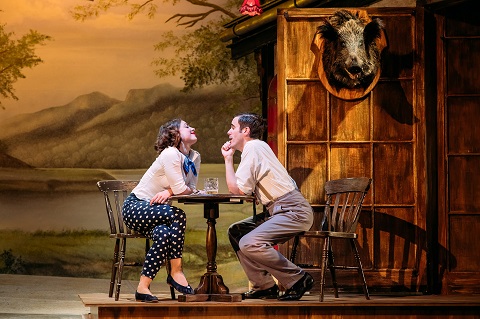 Lara Maria Müller (Nerina), Damian Arnold (Lindoro). Photo credit: Mihaela Bodlovic.
Lara Maria Müller (Nerina), Damian Arnold (Lindoro). Photo credit: Mihaela Bodlovic.
As the seria lovers Robert Lewis (Fileno) and Ema Nikolovska (Celia) had a fine ear for the extended lyricism of their arias. Celia may be disguised as a parasol-bearing shepherdess, but her nobility shone through in the pair’s first act cavatina duet, while Nikolovska assured shaped the imaginatively, and challengingly, structured ‘Ah come il core’ in which Celia contemplates her death. Her second aria was beautifully enhanced by an impressive horn solo, and some fine violin and bassoon playing. Lewis pulled off the tricky task of embodying the swooning swain, balancing absurdity - when etching his suicide note into the tree his arrow snaps - and honest heroism in the opera’s final moments. He had a fine way with the recitative. Lara Marie Müller was a pert and natty Nerinda, but she also exploited the tenderness in Haydn’s music. Damian Arnold’s Lindoro employed an occasional, and fittingly self-absorbed, sob in his voice - especially when the melodrama ran high.
Haydn gives Amaranta some strikingly sophisticated arias which suggest there is more to the wild child than initially meets the eye, and Eline Vandenheede impressed in a frenzied rage aria and, especially in the tragic ‘Del amor mio fedele’ in which Amarante’s humanity shone through her humorous excess. Matthew Palmer’s Perruchetto was borderline unhinged but vocally secure and had a musical and dramatic appeal, and madcap energy, which suggested he would make a good Papageno. I’ve admired Adam Maxey’s stage presence and suave, dark baritone in several performances of late and he excelled again as the ugly, unctuous Melibeo, resisting the temptation to overplay his dramatic hand and letting Haydn’s music do the work. Siân Dicker was an exuberant Diana and Mian Shahmir Samee a calm fluting presence.
Conductor Alice Farnham drew crisp playing from the GSMD Orchestra. The overture was brisk and clean, the horn playing vibrant. It’s a long play, and there are some sequences of slow arias which demand concentration and care, but there was no sense of flagging dramatic drive.
In a letter of 1781, Haydn declared his confidence that his operas would be assured of success if only they could be performed in one of the great cultural centres of Europe: ‘… if only they could hear my Operette [L’isola disabitata] and my most recently composed opera, La fedeltà premiata, for I assure you that such work has not yet been heard in Paris, and perhaps not in Vienna either. My misfortune is that I live in the country.’ After this enjoyable evening - imaginative, technically impressive - I couldn’t help think that if only we heard Haydn’s operas more frequently today, in productions so full of witty ingenuity, our own praise for his theatrical endeavours might be less frequently diluted by comparisons with Mozart.
Claire Seymour
Haydn: La fedeltà premiata
Amaranta - Eline Vandenheede, Nerina - Lara Marie Müller, Celia - Ena Nikolovska, Fileno - Robert Lewis, Lindoro - Damian Arnold, Perruccetto - Matthew Palmer, Melibeo - Adam Maxey, Diana - Siân Dicker, Flauto - Mian Shahmir Samee; Director - Stephen Barlow, Conductor - Alice Farnham, Designer - Adrian Linford, Lighting designer - David Howe.
Silk Street Theatre, Guildhall School of Music & Drama; Monday 4 th November 2019.
image=http://www.operatoday.com/Chorus%2C%20Matthew%20Palmer%2C%20Adam%20Maxey.jpg image_description= product=yes product_title=Haydn: La fedeltà premiata, Guildhall School of Music and Drama product_by=A review by Claire Seymour product_id=Above: Chorus, Matthew Palmer (Perruchetto) and Adam Maxey (Melibeo)Photo credit: Mihaela Bodlovic
November 4, 2019
Giovanni Pacini: Medea
Music composed by Giovanni Pacini. Libretto by Benedetto Castiglia.
First Performance: 28 November 1843, Real Teatro Carolino, Palermo
Revised, Teatro Eretenio, Vicenza, 1845.
Summary of Euripides’ Play
Medea is centered on a wife’s calculated desire for revenge against her unfaithful husband. The play is set in Corinth sometime after Jason’s quest for the Golden Fleece, where he met Medea. The play begins with Medea in a blind rage towards Jason for arranging to marry Glauce, the daughter of king Creon. The nurse, overhearing Medea’s grief, fears what she might do to herself or her children.
Creon, in anticipation of Medea’s wrath, arrives and reveals his plans to send her into exile. Medea pleads for one day’s delay and eventually Creon acquiesces. In the next scene Jason arrives to explain his rationale for his apparent betrayal. He explains that he couldn’t pass up the opportunity to marry a royal princess, as Medea is only a barbarian woman, but hopes to someday join the two families and keep Medea as his mistress. Medea, and the chorus of Corinthian women, do not believe him. She reminds him that she left her own people for him ( “I rescued you [...] I betrayed both my father and my house [...] now where should I go?” ), and that she saved him and slew the dragon. Jason promises to support her after his new marriage ( “If you wish me to give you or the children extra money for your trip into exile, tell me; I’m ready to give it with a lavish hand” , but Medea spurns him: “Go on, play the bridegroom! Perhaps [...] you’ve made a match you’ll one day have cause to lament.”)
In the following scene Medea encounters Aegeus, king of Athens. He reveals to her that despite his marriage he is still without children. He visited the oracle who merely told him that he was instructed “not to unstop the wineskin’s neck.” Medea relays her current situation to him and begs for Aegeus to let her stay in Athens if she gives him drugs to end his infertility. Aegeus, unaware of Medea’s plans for revenge, agrees.
Medea then returns to plotting the murders of Glauce and Creon. She decides to poison some golden robes (a family heirloom and gift from the sun god Helios) and a coronet, in hopes that the bride will not be able to resist wearing them, and consequently be poisoned. Medea resolves to kill her own children as well, not because the children have done anything wrong, but because she feels it is the best way to hurt Jason. She calls for Jason once more and, in an elaborate ruse, apologizes to him for overreacting to his decision to marry Glauce. When Jason appears fully convinced that she regrets her actions, Medea begins to cry in mourning of her exile. She convinces Jason to allow her to give the robes to Glauce in hopes that Glauce might get Creon to lift the exile. Eventually Jason agrees and allows their children to deliver the poisoned robes as the gift-bearers.
Forgive what I said in anger! I will yield to the decree, and only beg one favor, that my children may stay. They shall take to the princess a costly robe and a golden crown and pray for her protection.
In the next scene a messenger recounts Glauce and Creon’s deaths. When the children arrived with the robes and coronet, Glauce gleefully put them on and went to find her father. Soon the poisons overtook Glauce and she fell to the floor, dying horribly and painfully. Creon clutched her tightly as he tried to save her and, by coming in contact with the robes and coronet, got poisoned and died as well.
Alas! The bride had died in horrible agony; for no sooner had she put on Medea’s gifts than a devouring poison consumed her limbs as with fire, and in his endeavor to save his daughter the old father died too.
While Medea is pleased with her current success, she decides to take it one step further. Since Jason brought shame upon her for trying to start a new family, Medea resolves to destroy the family he was willing to give up by killing their sons. Medea does have a moment of hesitation when she considers the pain that her children’s deaths will put her through. However, she steels her resolve to cause Jason the most pain possible and rushes offstage with a knife to kill her children. As the chorus laments her decision, the children are heard screaming. Jason then rushes onto the scene to confront Medea about murdering Creon and Glauce and he quickly discovers that his children have been killed as well. Medea then appears above the stage with the bodies of her children in the chariot of the sun god Helios. When this play was put on, this scene was accomplished using the mechane device usually reserved for the appearance of a god or goddess. She confronts Jason, reveling in his pain at being unable to ever hold his children again:
I do not leave my children’s bodies with thee; I take them with me that I may bury them in Hera’s precinct. And for thee, who didst me all that evil, I prophesy an evil doom.
She escapes to Athens with the bodies. The chorus is left contemplating the will of Zeus in Medea’s actions:
Manifold are thy shapings, Providence! / Many a hopeless matter gods arrange / What we expected never came to pass / What we did not expect the gods brought to bear / So have things gone, this whole experience through!
[Source: Wikipedia]
image=http://www.operatoday.com/Medea-Sandys.png image_description=Medea by Anthony Frederick Augustus Sandys (painted 1866-68) [Source: Wikipedia] audio=yes first_audio_name=Giovanni Pacini: Medea first_audio_link=http://www.operatoday.com/pacini_medea1.m3u product=yes product_title=Giovanni Pacini: Medea product_by=Calcante: Giorgio GiuseppiniCassandra: Maria Cristina Zanni
Creonte: Marcello Lippi
Giasone: Sergio Panajia
Licisca: Enrica Bassano
Medea: Jolanta Omilian
Orchestra Sinfonica di Savona, Coro Schola Cantorum S. Gregorio Magno Trecate, Richard Bonynge (cond.)
Live performance, 5 October 1993, Savona. product_id=Above: Medea by Anthony Frederick Augustus Sandys (painted 1866-68) [Source: Wikipedia]
November 3, 2019
Van Zweden conducts an unforgettable Walküre at the Concertgebouw
Seeing Van Zweden conduct translates directly into what you hear – an energetic gracefulness guided by mathematical discipline. The lasting impression left by this Walküre, however, was one of predominant lyricism. With sonorous beauty a paramount goal, the performance peaked during its romantic and melancholy passages. But even in the opening storm and the motifs associated with the various villains of the Ring, Van Zweden and the Netherlands Radio Philharmonic, who should be proud as peacocks of the musical heights they scaled, seemed incapable of producing a harsh sound. There was also plenty of dramatic excitement, as in the turbulent prelude to Act 2 and the beginning of Act 3, when Van Zweden marshaled a cracking squadron of soaring Valkyries. But even when he turned up the decibels for Wotan’s rage, the orchestra never lost its prismatic brilliance. Naturally, Van Zweden must share the credit with the musicians – the amber strings, a stalwart brass section, the six sparkling harps in the Magic Fire Music, and the various exquisite solos. Whether taking center stage or elucidating the sung narratives, so discerningly shaped by its erstwhile chief conductor, the Netherlands Radio Phil was in excellent form.
All this and we’ve barely mentioned the cast, who made this event truly special. The fateful reunion of Wotan’s human twin children, separated in childhood, could hardly have been sung better. Stuart Skelton’s finely drawn Siegmund was its emotional center. He not only thrilled with column-rattling heroic crescendos, but his pliable tenor also conveyed a degree of dramatic nuance that was almost filmic. Evidently, Skelton has lived with and loved this character for a while and knows every fracture of his broken heart. Van Zweden was happy to follow him during Siegmund’s narration of his wretched life story, which made for some gripping storytelling. The tension was also sliceable when Skelton and Ain Anger as Hunding stared each other down after their confrontation. Anger’s Hunding was genuinely terrifying, his deep, rumbling bass exuding malevolence and fascination in equal measure. And the Sieglinde they fought over was particularly alluring, possessing the golden voice of Elena Pankratova. Although she did not exactly delve deep into the psyche of the traumatized orphan and purchased bride, Pankratova was vocally aglow. Her refulgent singing reached its zenith in Act 3, in Sieglinde’s short but intense appearance as she is galvanized out of her suicidal mourning for Siegmund by the news that she is expecting his child.
The singing gods gave the mortals a run for their money. Ronnita Miller was a quality Fricka, her mezzo-soprano aristocratic and polished. She was a wounded, betrayed wife rather than a furious moral crusader, appealing to Wotan’s compassion as well as his sense of righteousness. Thomas Johannes Mayer, an experienced Wotan, gave a complex, textually commanding portrayal of the conflicted god. Vocally, his Wotan, more lyrical than heroic, is not of the armored tank variety. At times his vocal reserves seemed to be running low, but each time he quickly managed to replenish them. The vividness of his acting constantly drew you in, not least in his tortured monologue to Brünnhilde, pivotal to understanding the power struggles and emotional forces at work in the whole of the Ring. Soprano Katherine Broderick, taking on the Walküre Brünnhilde for the first time, made a wonderful role debut. Her round, bright timbre suited the rebellious, clever young daughter. She positively reveled in the Valkyrie cries (with trills!), and her voice also retained its brightness, without losing any richness, in the low-lying Annunciation of Death. This was a beautifully sung, passionate assumption of the role, already emotionally mature in the final scene, when Brünnhilde incredulously hears that Wotan will punish her by divesting her of her immortality. Broderick’s heart-rending pleading for the mitigation of her terrible sentence was just one of this indelible performance’s extra special moments.
Jenny Camilleri
Richard Wagner: Die Walküre
Katherine Broderick (soprano), Brünnhilde; Thomas Johannes Mayer (baritone), Wotan; Elena Pankratova (soprano), Sieglinde; Stuart Skelton (tenor), Siegmund; Ronnita Miller (mezzo-soprano), Fricka; Ain Anger (bass), Hunding ; Sonja Šarić (soprano), Gerhilde; Lisette Bolle (soprano), Helmwige; Brit-Tone Müllertz (soprano), Ortlinde; Esther Kuiper (mezzo-soprano), Waltraute; Ursula Hesse von den Steinen (mezzo-soprano), Siegrune; Katrin Wundsam (mezzo-soprano), Grimgerde; Roswitha Christina Müller (mezzo-soprano), Rossweisse; Henriette Gödde (mezzo-soprano), Schwertleite. Jaap van Zweden, Conductor . Netherlands Radio Philharmonic. Heard at the Concertgebouw, Amsterdam, on Saturday, the 2nd of November, 2019.
image=http://www.operatoday.com/Schotts_1899_Walkure_title.png image_description=Brünnhilde on the mountainside [Source: Wikipedia] product=yes product_title=Van Zweden conducts an unforgettable Walküre at the Concertgebouw product_by=A review by Jenny Camilleri product_id=Above: Brünnhilde on the mountainside [Source: Wikipedia]November 1, 2019
Purcell for our time: Gabrieli Consort & Players at St John's Smith Square
As McCreesh himself noted, in an engaging introduction to the performance, King Arthur might be seen as a classic example of British ‘exceptionalism’ - “And we all know where that got us”.
In the 1680s and 1690s, when King Arthur was written, revised and first staged, England was still haunted by painful memories of a civil war which threatened to re-erupt, with the country seemingly irreconcilably divided along political and religious lines. When Charles II died in 1685 and James II replaced him, England found itself ruled by a Catholic monarch who had spent years in exile in France and who was intriguing with foreign Catholic rulers. For some, James was an autocratic interloper; for Royalists he was the true heir, destined by divine right. James’s political misjudgements were swiftly punished: by 1688 a Glorious Revolution had placed the Protestant William Prince of Orange and his wife Mary (James’s daughter) on the English throne and sent James fleeing abroad once again.
Dryden’s 1684 version of King Arthur was probably a political allegory in praise of Charles II; in 1685 the poet laureate and historiographer royal converted to Catholicism. The Revolution of 1688 saw Dryden stripped of his official positions and in need of new sources of income. Dryden’s biographer, James Winn, titles his penultimate chapter, ‘The Lab’ring Bee’, [1] acknowledging the productivity of his subject’s final years: a revised form of King Arthur had its first stage performance in 1691 when Dryden was sixty years old.
But, just as some politicians hedged their bets over the outcome of the 2016 referendum, Dryden faced the challenge of adapting an opera written for Charles II to a post-Revolution England and persuading the stage censors that the original allegorical apparatus had been disassembled. As his Preface states, ‘When I wrote it, seven Years ago, I … us’d the little Skill I have in Poetry to adorn it. But not to offend the present Times, nor a Government which has hitherto protected me (and by a particular Favour wou’d have continued me what I was, if I could have comply’d with the Termes which were offered me), I have been oblig’d … to alter the first Design, and take away … many Beauties from the Writing. ’ Andrew Pinnock and Bruce Wood have suggested that these necessary revisions account for some of the gaps and conundrums that challenge modern-day editors and performers: that words not by Dryden and music not by Purcell infiltrated King Arthur and that thematic links exist between King Arthur and the 1691 Queen Mary birthday ode , Welcome, welcome glorious morn. [2]
The editorial problems are many. There is no manuscript of Dryden’s 1684 libretto and no reliable source for Purcell’s music: scholar Curtis Price has noted that instead we face ‘a confused assortment of more than sixty manuscripts and miscellaneous publications, none of which includes the complete music’. [3] When no music exists for songs which are printed in Dryden’s text, we cannot know if Purcell’s music is sadly lost or if he chose not set the lines in question.
These are some of the problems with which McCreesh and Christopher Suckling
have been grappling in preparing the new performing edition that we heard
at St John’s Smith Square and which the Gabrieli Consort & Players
(with almost identical personnel) have recorded and released this month. Gabrieli have been performing music from King Arthur for a
quarter of a century, and this new edition reflects their evolving
interpretation and performance practice. 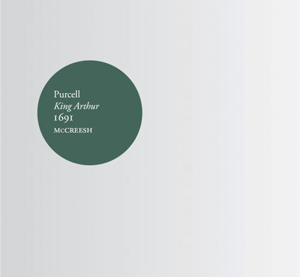 Some text has been repositioned or
reworked; musical insertions have been made, in some places in response to
gaps or ambiguities in the original sources, elsewhere to compensate for
the absence of the spoken dialogue, or to provide fitting conclusions to
the acts and masques. Inconsistencies in the various manuscripts have been
considered as performance, rather than ‘scholarly’, issues: McCreesh
explains that ‘Our singers, like Purcell’s, would naturally grace their
lines with rhythmic alterations and melodic extemporisations’, thereby
rendering the question of which textual variant is ‘correct’ moot. Having
examined contemporary sources, the decision was made to perform choruses
and dances without continuo; the songs are accompanied by harpsichord,
theorbos and guitar, without a string bass line.
Some text has been repositioned or
reworked; musical insertions have been made, in some places in response to
gaps or ambiguities in the original sources, elsewhere to compensate for
the absence of the spoken dialogue, or to provide fitting conclusions to
the acts and masques. Inconsistencies in the various manuscripts have been
considered as performance, rather than ‘scholarly’, issues: McCreesh
explains that ‘Our singers, like Purcell’s, would naturally grace their
lines with rhythmic alterations and melodic extemporisations’, thereby
rendering the question of which textual variant is ‘correct’ moot. Having
examined contemporary sources, the decision was made to perform choruses
and dances without continuo; the songs are accompanied by harpsichord,
theorbos and guitar, without a string bass line.
The practical result of McCreesh’s and Suckling’s labours and deliberations is a sheer delight. At SJSS the instrumental ensemble played with a remarkable combination of fluidity and bite. The sound was so fresh and full that one seemed to be hearing Purcell’s music for the first time. Choruses were invigored by the boldness of oboes (Christopher Palameta and Hannah McLaughlin) and Jean-Francois Madeuf’s baroque trumpet. At the start of Act 5 Ashley Riches’ richly proclaimed announcement that Britannia must “rise/In triumph of the main” was accompanied by surging strings which were then becalmed by soft oboes as Riches’ baritone, rippling with anticipation, foretold the appearance of the Queen of the Islands. Mhairi Lawson’s ensuing celebration of the “fair nymph of Britain” was accompanied by a remarkably dulcet and expressive instrumental trio (Palameta, Madeuf and leader Catherine Martin). Zoe Shevlin’s bassoon added pastoral charm to “Shepherd, shepherd, leave decoying”, sung gracefully by Lawson and Anna Dennis.
Singing from memory, the seven soloists and two additional chorus members (high tenor Christopher Fitzgerald-Lombard and tenor Tom Castle) formed a vigorous vocal ensemble in which the independent voices blended euphoniously while retaining their own colour and character. Jeremy Budd’s beautifully relaxed high tenor called us “To Woden’s Hall … Where we shall laugh/And dance and quaff/The juice that makes Briton’s bold” with such relaxed high sweetness that who could resist the invitation? “Come if you dare” responded tenor James Way, with good-humoured confidence and ease, his voice borne aloft by the pungent, punchy accompaniment. In Act 3, Rowan Pierce was a luxuriantly vibrant Cupid, waking Riches’ yawning Cold Genius. Riches was characteristically attentive to the text, its comic nuances exploited neatly, while the pianissimo chorus of ‘Cold People’ quivered and shivered evocatively. As the unidentified ‘He’ and ‘She’, Dennis and baritone Robert Davies (standing in at short notice for the indisposed Marcus Farnsworth) delivered a vibrant dramatic exchange about the trials and tribulations of love, before joining in optimistic rejoicing: “Let us love, let us love, and to happiness haste;/ Age and wisdom come too fast”.
In his Preface to Albion and Albanius (1680), Dryden described ‘dramatic opera’ as ‘a tragedy mixed with opera, or a drama written in blank verse, adorned with scenes, machines, songs, and dances, so that the fable of it is all spoken and acted by the best of the comedians; the other part of the entertainment to be performed by … singers and dancers’, adding, ‘It cannot properly be called a play, because the action of it is supposed to be conducted sometimes by supernatural means, or magic; nor an opera, because the story of it is not sung’. Here, we had no spoken text, and so, by Dryden’s reasoning, no ‘story’. But if a ‘narrative’ did not emerge, then this was of no account. What we had was essentially a serious of marvellous masques, brilliant performed, and directed by McCreesh with an understated ease borne of familiarity with Purcell’s music and an interpretative confidence shared by his Consort & Players.
Only in Act 5 did I have minor misgivings, when Dryden’s paean to tax evasion and alcoholic excess, “Your hay it is mow’d”, was turned into a raucous knees-up for country yokels jocularly waving Union Jacks: “We ha’ cheated the Parson, we’ll cheat him agen;/ For why shou’d a Blockhead ha’ One in Ten? … For Prating so long like a Book-learn’d Sot,/Till Pudding and Dumplin burn to Pot … We’ll toss off our Ale till we canno’ stand,/ And Hoigh for the Honour of Old England …” In riposte, the ladies of the chorus brandished the golden stars-on-azure of the EU insignia, to the general applause of the audience.
Andrew Pinnock [4] notes that a broadside ballad version published in 1691 has “Black-coat” instead of blockhead and suggests that Dryden’s text would have had little chance of getting past the censor. An alternative version presents more moderate sentiments, “We’ll drink off our Liquor while we can stand” and Pinnock wonders whether the ‘loutish tone’ of “Your hay it is mow’d” might have led to it being omitted ‘sometime between 1691 and 1698 to mollify church objectors; or the wording [may have been] cleaned up’.
Whatever, the ‘loutishness’ was a rather jarring note in this performance, one which Anna Dennis’ subsequent rendition of “Fairest Isle”, subtly and beautifully decorated, just about expunged, before the final chorus - an adaptation of a trumpet song and chorus from Act 4 of Dioclesian reworked to honour Britannia, St George and the Order of the Garter, in imitation of the conclusion of Albion and Albanius - brought the performance to a celebratory close.
Claire Seymour
Gabrieli Consort & Players: Paul McCreesh (conductor)
Anna Dennis (soprano), Mhairi Lawson (soprano), Rowan Pierce (soprano), Jeremy Budd (high tenor), Christopher Fitzgerald-Lombard (high tenor), Tom Castle (tenor), James Way (tenor), Robert Davies (baritone), Ashley Riches (baritone)
St John’s Smith Square, London; Wednesday 30th October 2019.
[1] Dryden and his World (Yale University Press, 1987).
[2] ‘Come ye Sons of Art - Again: Court Cross-Subsidy for Purcell’s Opera Orchestra, 1690-1695’, Early Music 37 (2009): 445-66.
[3] Henry Purcell and the London Stage (CUP, 1984), 297.
[4] ‘A Double Vision of Albion: Allegorical Re-Alignments in the Dryden-Purcell Semi-Opera King Arthur’, R estoration: Studies in English Literary Culture, 1660-1700 , vol 34/1 (2010): 55-81.
Photo credit: Andy Staples